Traverse City: Across the Mitten on Indian Trails
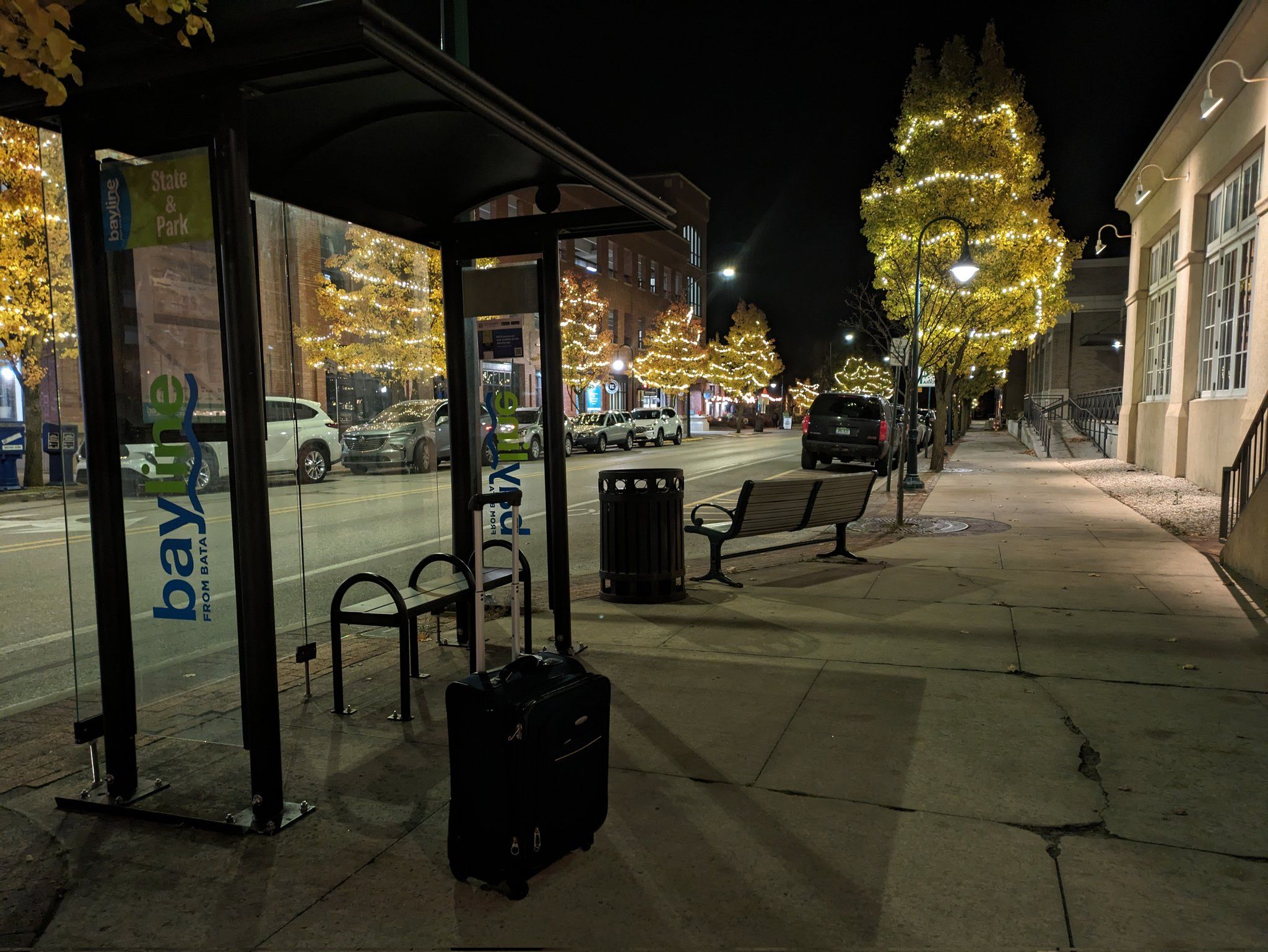
This is an expansion of a livethread originally posted to Twitter .
Setting the Stage
Over my birthday weekend I took a three-day, two-night trip up to Traverse City from Flint without once getting behind the wheel of a car. With the driving expenses out of the equation, it’s a surprisingly cheap “staycation” during the fall and winter months – less than $100 a night at many reputable hotel chains along the East Bay. I hadn’t visited the Cherry Capital since the spring of 2015 as a senior in high school, well before I began viewing our cities through the lens of a transit rider.
I planned this trip around a visit to the Groundwork Center , the nonprofit spearheading the Northern Michigan Passenger Rail project along with other local sustainability efforts. This project is one of multiple highly anticipated intercity rail expansions in Michigan along with the Detroit to Grand Rapids corridor and the restoration of passenger service between Detroit and Ontario . After attending the annual Michigan Association of Railroad Passengers meeting in Durand and connecting with the team leading the project, I was invited to tour the office. (Intercity bus service is essential, but I’d rather be on a train – wouldn’t you?)

The Northern Michigan Passenger Rail project.
The Plan
Indian Trails Schedule 1484
There is but one way into Traverse City by transit: Indian Trails Schedule 1484, which runs once a day.
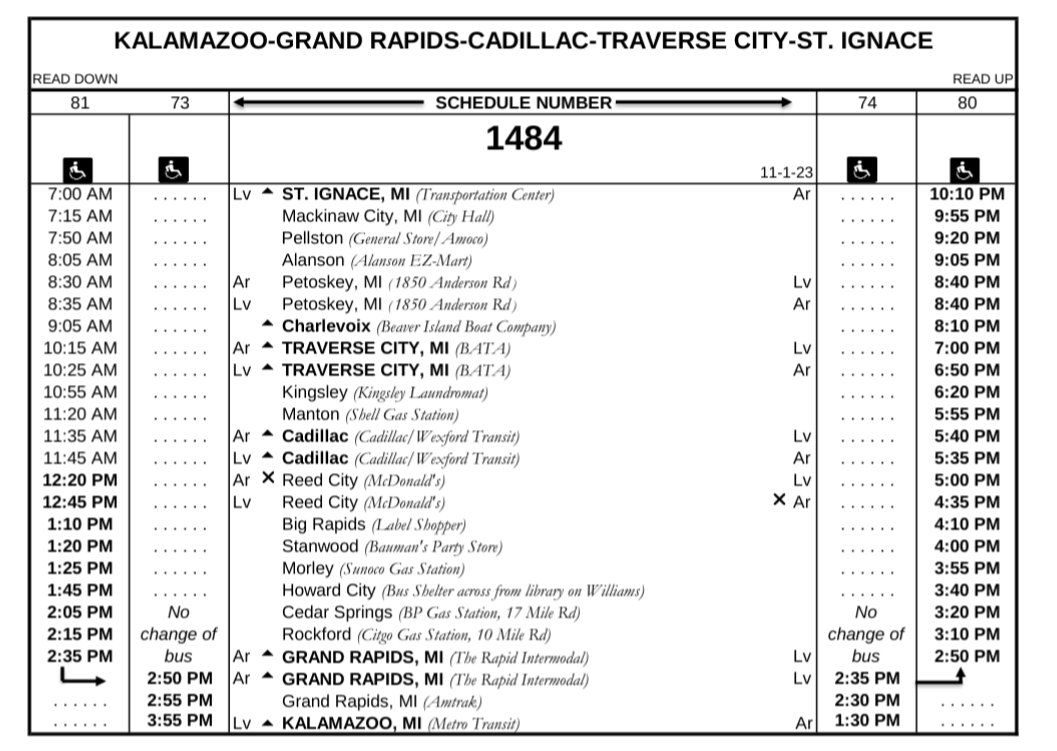
The full timetable for Indian Trails Schedule 1484 .
The northbound from Grand Rapids gets in at 7pm, and the southbound from St. Ignace departs at 10:30am. As advertised, there’s no one-seat trip from southeast Michigan up to Traverse City, though in practice there actually is: The scheduled run from Detroit to Grand Rapids via Flint and Lansing ( my usual trip ) operates on the same bus as Schedule 1484 every day, just with a different driver. If you’re “transferring” between the two runs, you can leave your stuff on the bus when you disembark in Grand Rapids for the driver swap and ticket rescan.
The opposite is true for the connection from Kalamazoo. You’ll have the same bus driver, but you’ll change buses in Grand Rapids. The interlines are mistakenly switched on the website.

As of the November 2023 service changes, the interline published on the itinerary for Schedule 1484 is incorrect. Indian Trails likely overlooked this part of the document when they updated the departure and arrival times earlier this month. I’ll be reaching out to Trails to have this addressed. (On the off chance any of the schedulers in Owosso are reading this, give this a quick patch-up please and thanks!)
From Lansing, Flint, or Detroit, it’s a ~$50 trip. That’s 8 or 9 hours on a motorcoach with a single restroom, no food service aside from bus station vending machines and the meal break – we’ll get to that – and power outlets that may or may not work depending on what type of bus you get.
But: Schedule 1484 originates in Kalamazoo, which means…
Amtrak Interoperability to the Rescue
This particular Trails route serves double-duty as a Thruway service, which allows for purchasing a bus ticket in the same transaction as a train ticket directly through Amtrak . This is a beautiful thing:
- You get the café car on the first leg
- The bus holds for the train if it's late, and vice versa
- If you have Amtrak points, the entire trip – Trails included – is completely free 🎉
That’s right: My journey up to Traverse City cost me nothing but my time and whatever I chose to spend on food along the way. (As always, my blog posts are my own voice, but if you’re a frequent Amtrak passenger in a situation to responsibly open a new line of credit the Amtrak Guest Rewards card is a must-have. They’re running a points offer again through December 6th. It’s been my primary card for a year now, I highly recommend it!)
So, in addition to the 20-minute layover in Grand Rapids I had an intermission in Kalamazoo before buckling down for the five-hour bus ride.
The final plan:
- Stock up on Amsnaks
- Grab a proper lunch in Kzoo
- Enjoy the portable café car experience during the meal break
But why not just fly in from…
NO.
I am not flying between two cities in the same state, let alone peninsula. Have a little respect for the planet (and your wallet – those puddle jumpers do not come cheap!)
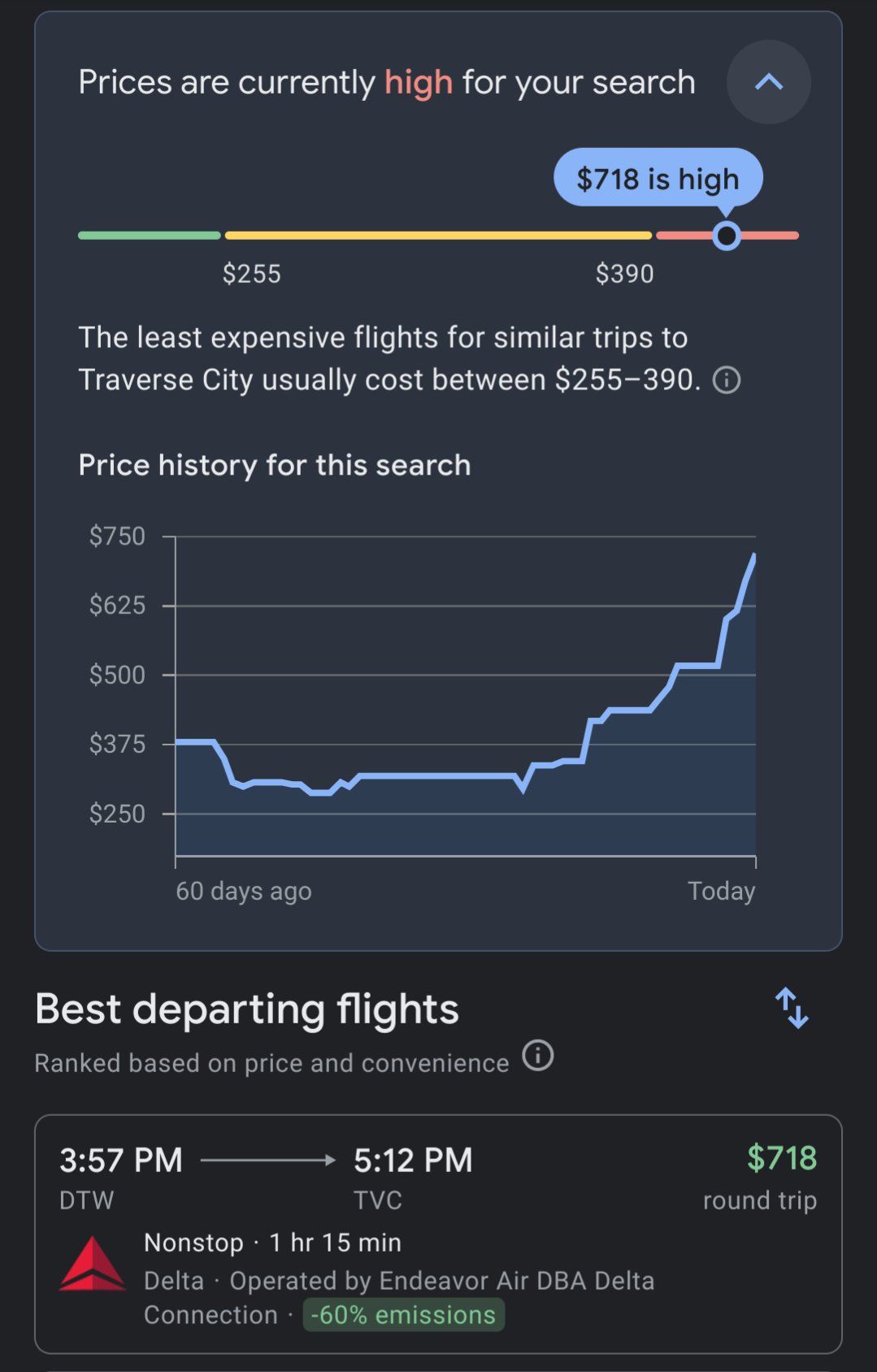
Part of transit advocacy and environmental stewardship is refusing air travel whenever alternatives are available and viable. Save the trip through airport security for cross-country or international flights.
The Journey
Act One: Flint to Kalamazoo
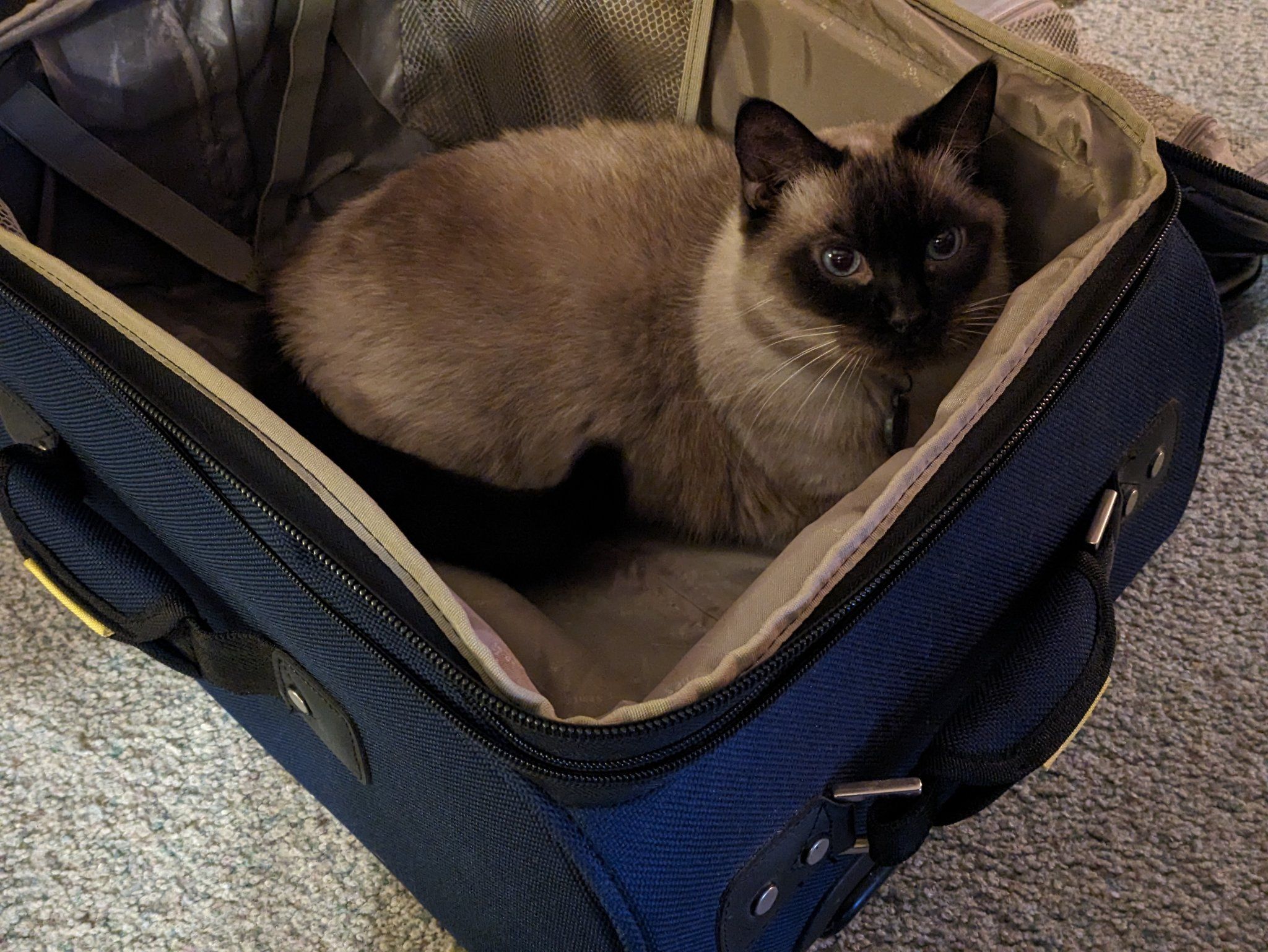
Kitkat, the family kitty, completing her pre-departure luggage inspection
There are four Amtrak stations within easy reach of southern Genesee County: Flint, Durand, Lapeer, and Pontiac. Flint is the least exciting of the bunch – it’s a 1970s-style Amshack with a fenced-in platform, which has seen very little in the way of upgrades since its construction – but it’s by far the easiest to reach on transit by way of MTA’s direct fixed-route service to the station and countywide dial-a-ride system, Your Ride. It’s very much function over form. The 8:50am Wolverine departure from Pontiac would’ve worked as an alternative first leg of the trip (and I’ve gotten to Grand Rapids that way in the past), but the layover in Kalamazoo is tighter. The 7:35am Blue Water out of Flint was the sensible choice for this journey.
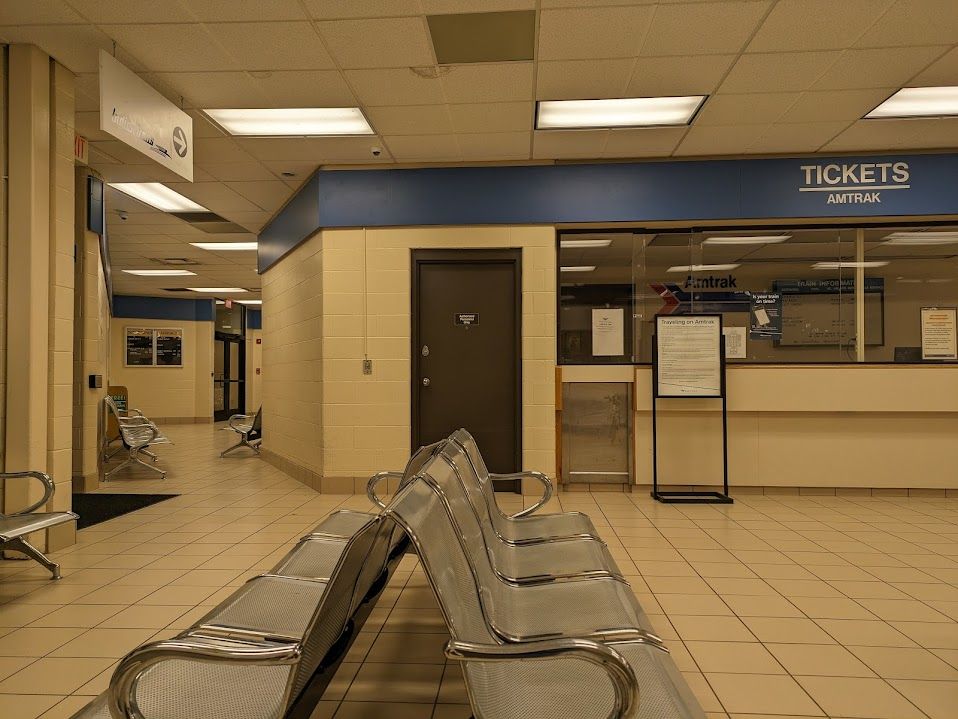
Flint’s Amtrak and Indian Trails station, a time capsule from the 70s. Classic logos included!
The Blue Water’s predecessors, the International and Blue Water Limited, ran through the Port Huron tunnel all the way to Toronto. Sadly, a one-two punch of SARS and heightened border security in the wake of September 11th killed this service.
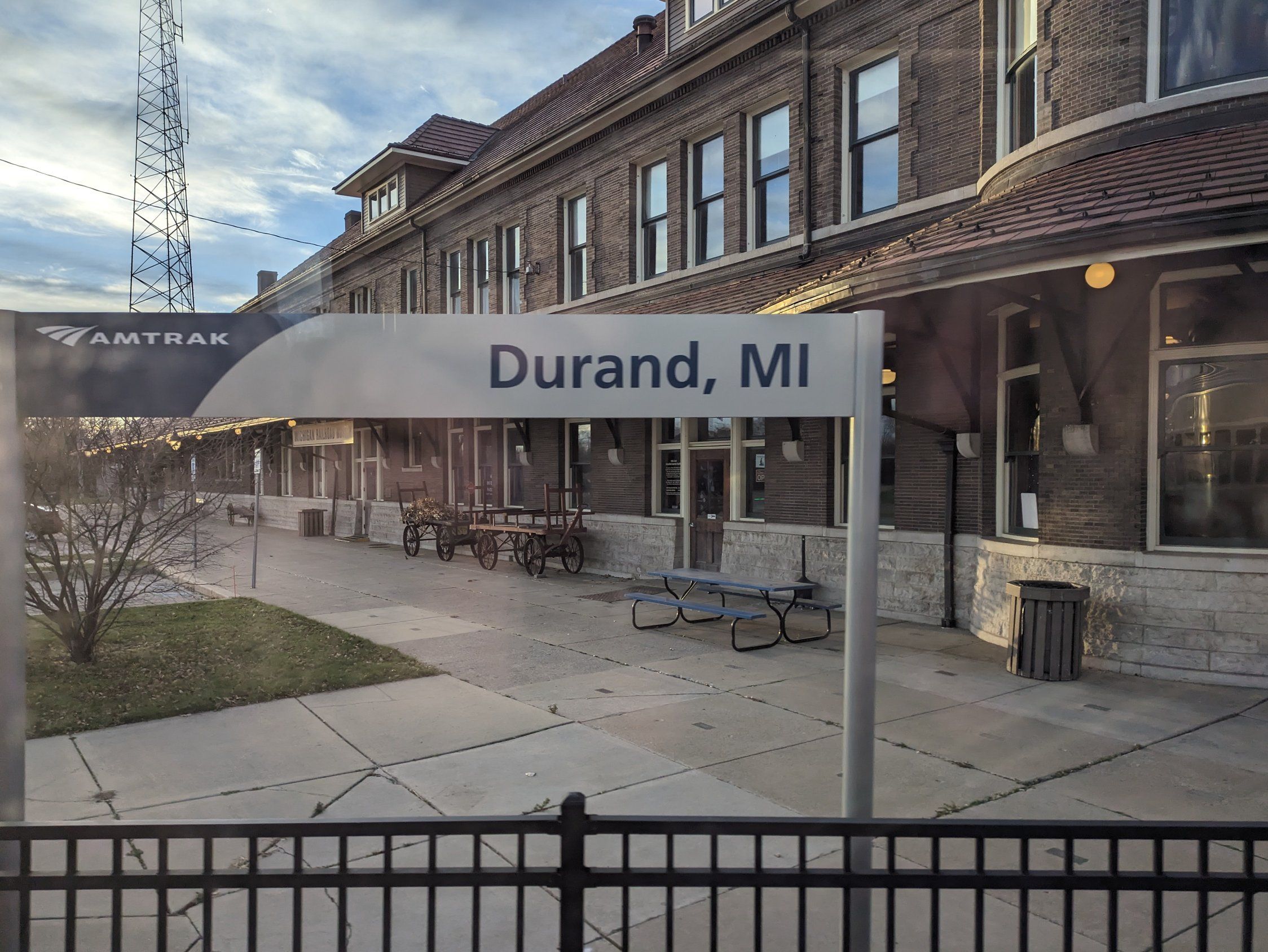
Durand Union Station is a larger, friendlier station but impossible to reach except by car, on foot from the village, or by SATA, Shiawassee County’s dial-a-ride . SATA is subject to availability and isn’t a realistic option for reaching the station by 8am from a neighboring county.
After an on-time departure out of Flint, I stocked up on café car snacks to pair with lunch and settled in for the fairly short ride to Kalamazoo.
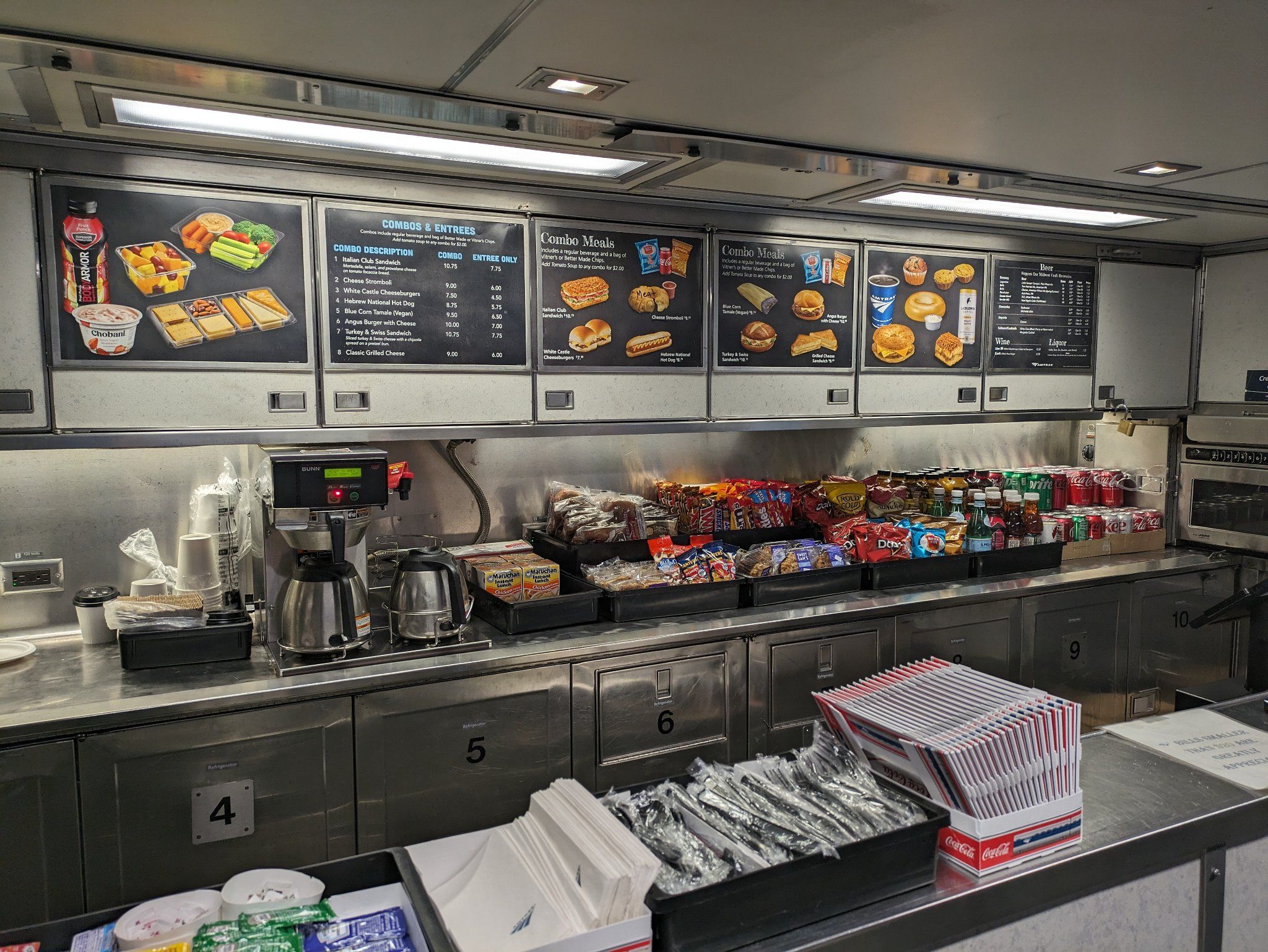
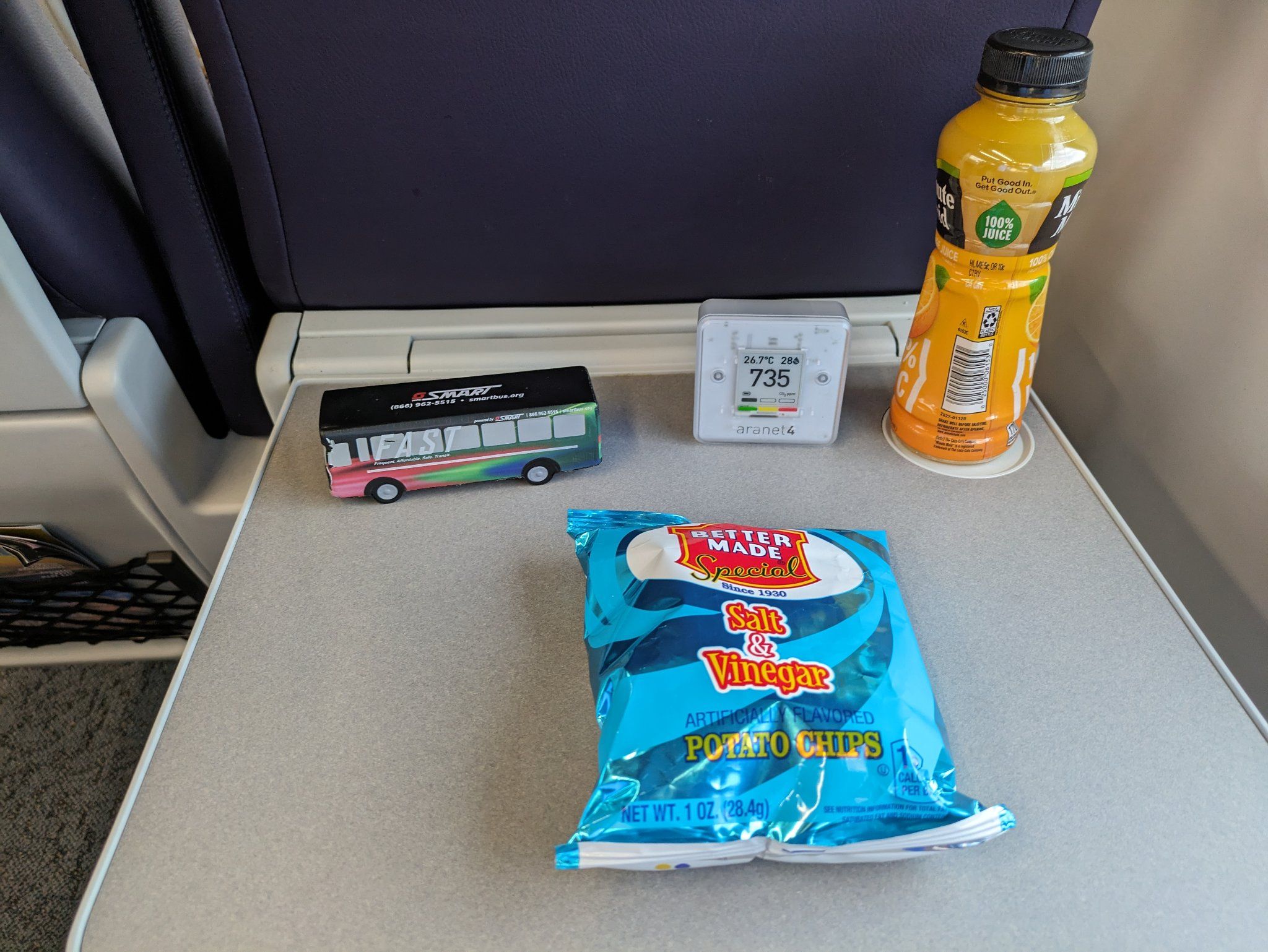
Why intercity train travel is better than intercity bus travel, Exhibit A
Like clockwork, East Lansing is where the Blue Water gets incredibly crowded. If you have an open seat next to you, the conductors will tell you to keep it clear before they pull into this station!
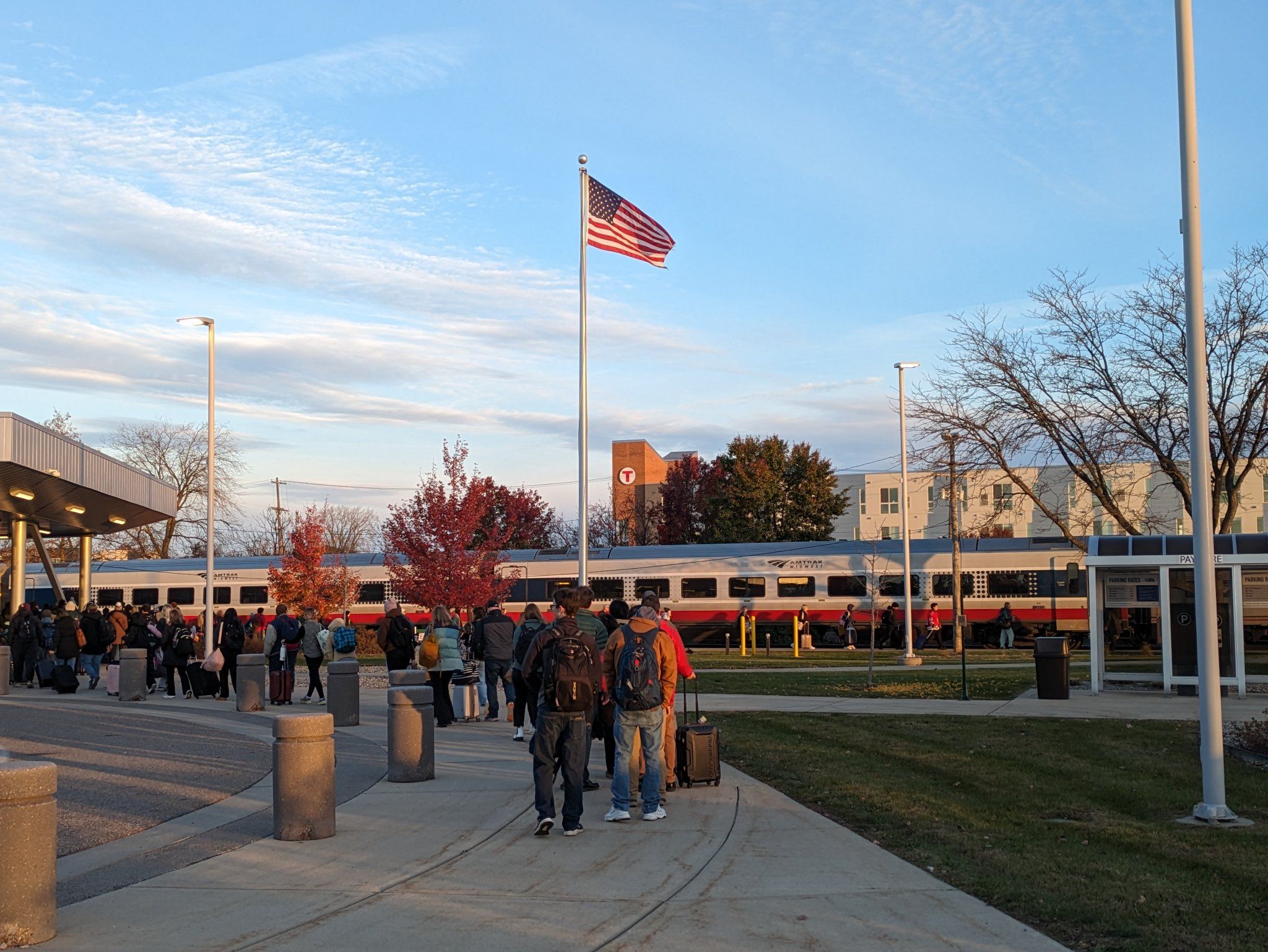
Over 200 passengers boarding the train on Friday, November 3rd.
On most of my Amtrak trips over the past year, East Lansing has been my starting point or destination. If you stay onboard traveling west, you get to see Lansing proper from a vantage point you can’t get any other way.
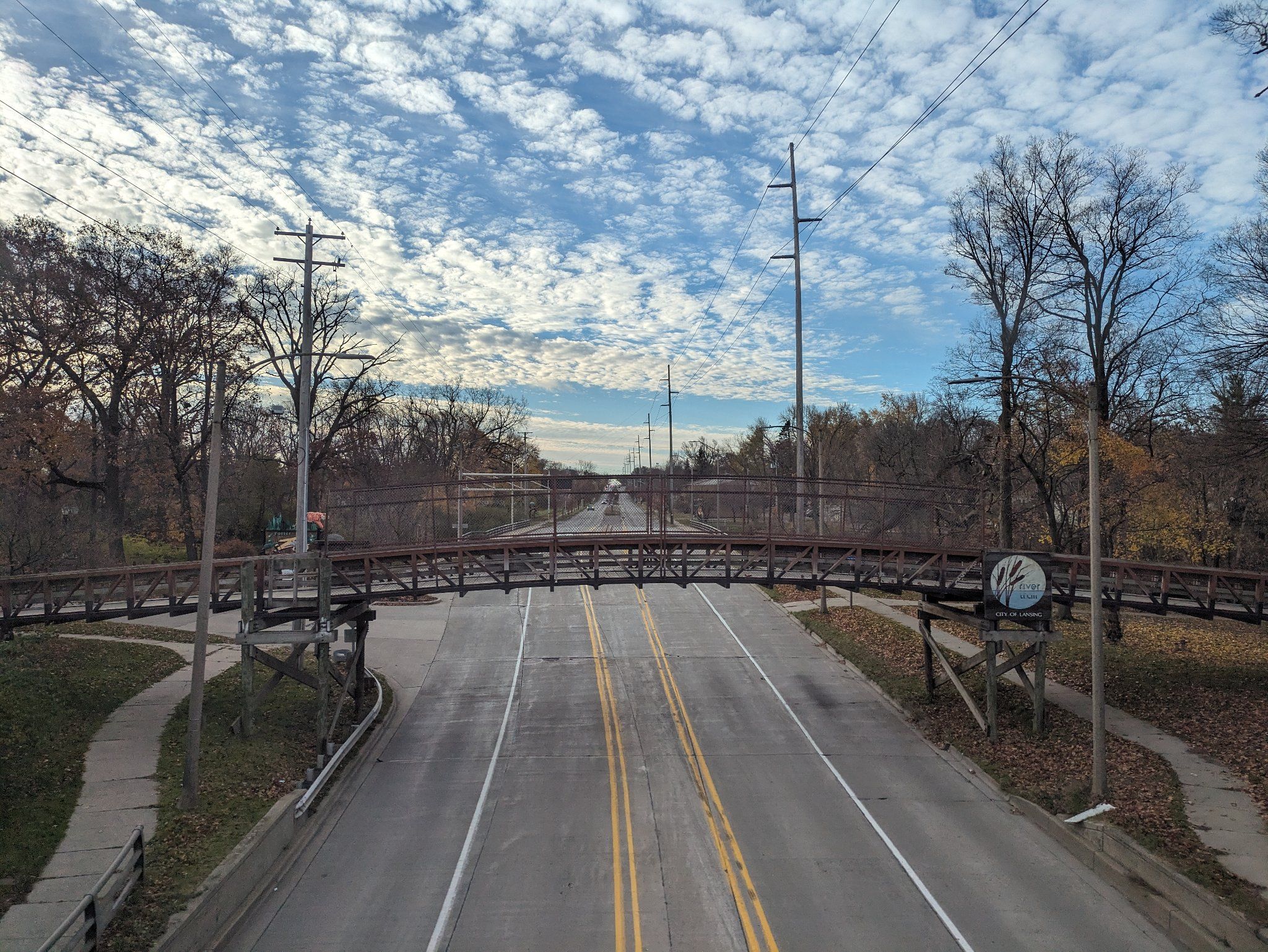
The Pennsylvania Avenue River Trail bridge outside Potter Park Zoo.
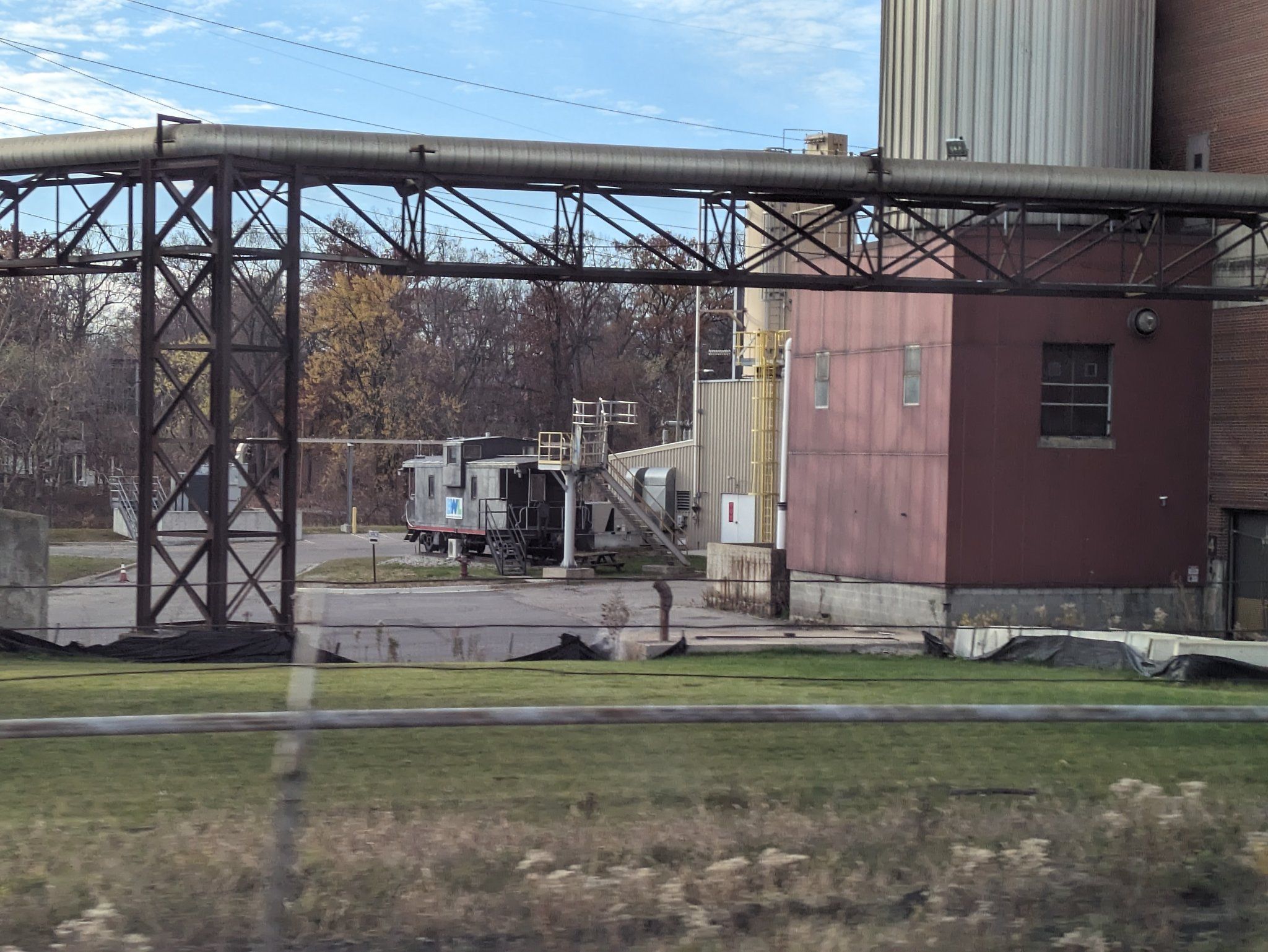
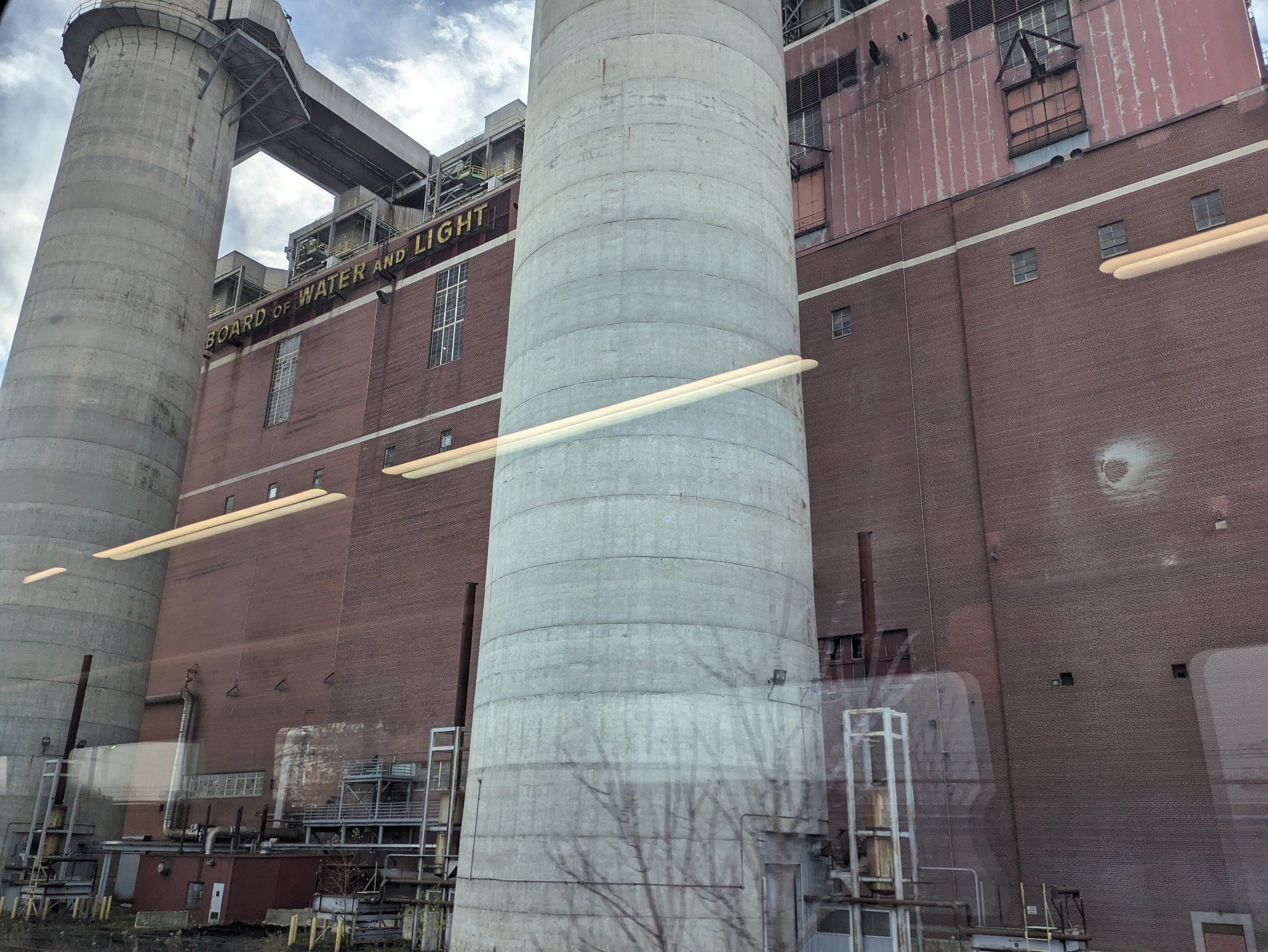
The train travels directly through the historic Eckert Power Station in REO Town, Lansing’s tallest structure.
Intermission: Mode Shift Kalamazoo
After getting a brief taste of the 110mph experience west of Battle Creek, the on-rails portion of this journey came to an end. I had three hours in Kalamazoo before hitting the road again.
Stations west of Battle Creek on the state-owned portion of the line have the privilege of seeing four round trips to Chicago a day. Lansing and Flint only get one.
I reached out to my friends and fellow advocates at Mode Shift Kalamazoo for suggestions on how to spend this time, and they delivered! I picked up a breakfast sandwich from Factory Coffee and toured the history section at the Kalamazoo Public Library.
Mode Shift Kalamazoo is a group that does what it says on the tin: They promote the prioritization of moving people, not cars. On past visits to Kzoo that didn’t involve Indian Trails I brought my e-Sparrow, but when traveling through to Grand Rapids or other west Michigan cities you can’t transport an unboxed bike (yet another point for Amtrak Midwest over intercity buses). This means nearly my entire experience with downtown Kalamazoo has been on foot and by KMetro during layovers.
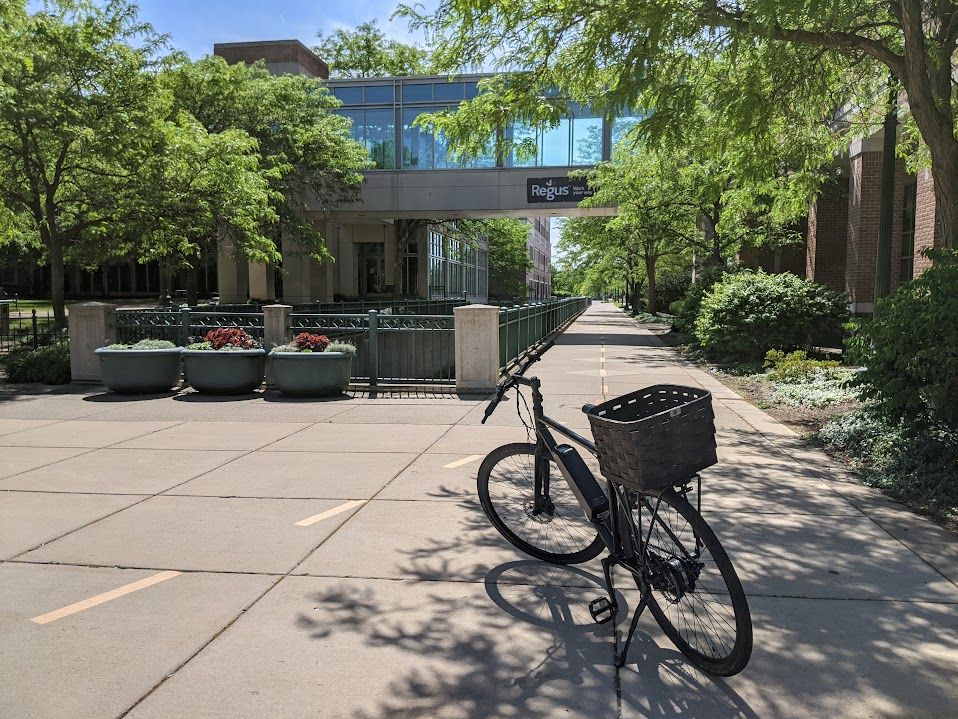
The pedestrian mall and investment in sidewalk connections are what make this work. I can reach the store to stock up on snacks, get lunch, visit the library, and even visit WMU’s campus all with luggage in tow. It’s fantastic to see this energy from Michigan’s cities and residents, and Kalamazoo is not alone in this respect!
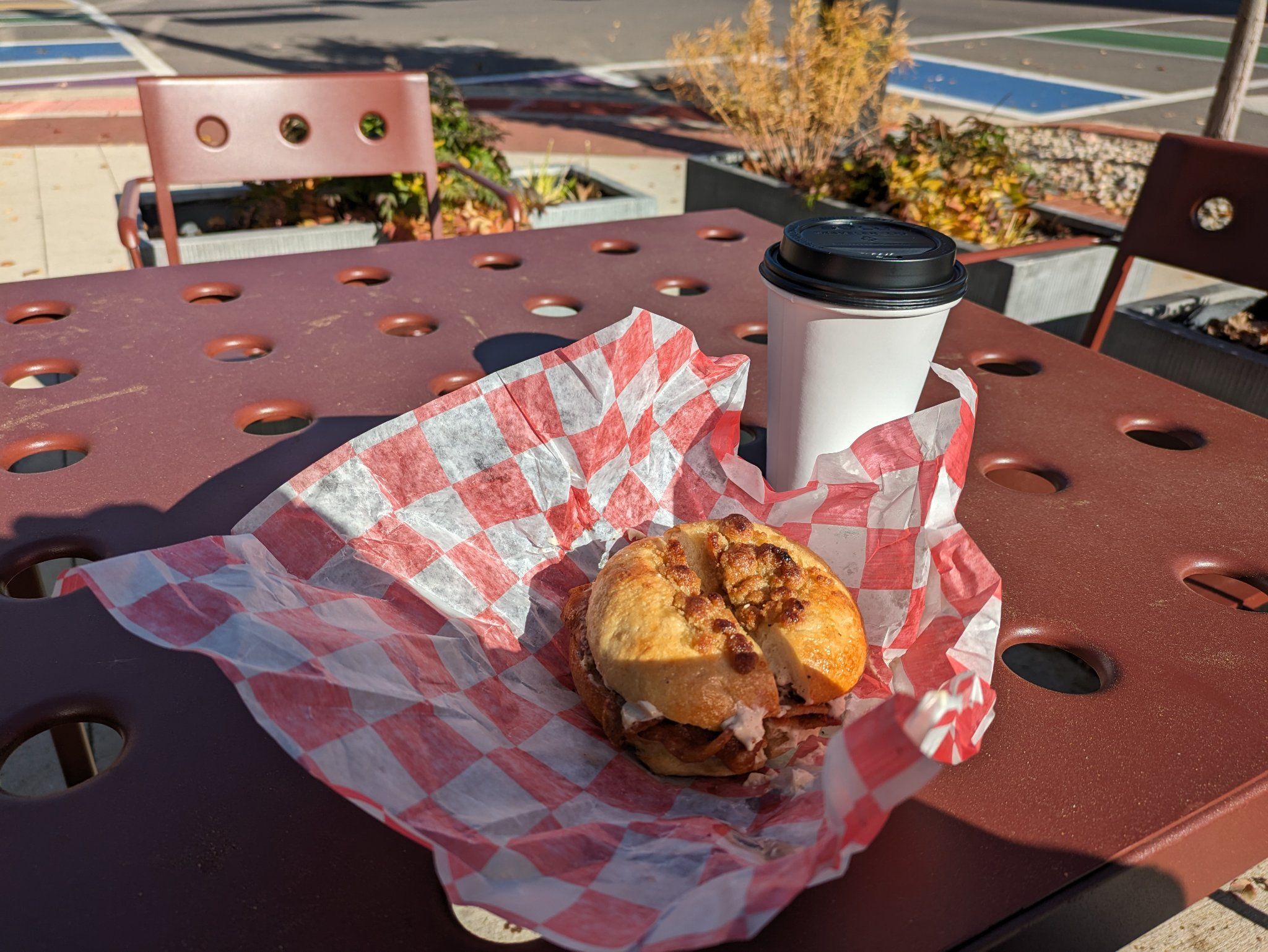
We love a walkable downtown with good transit and ample outdoor seating. (The French bagel with maple brown sugar is super tasty!)
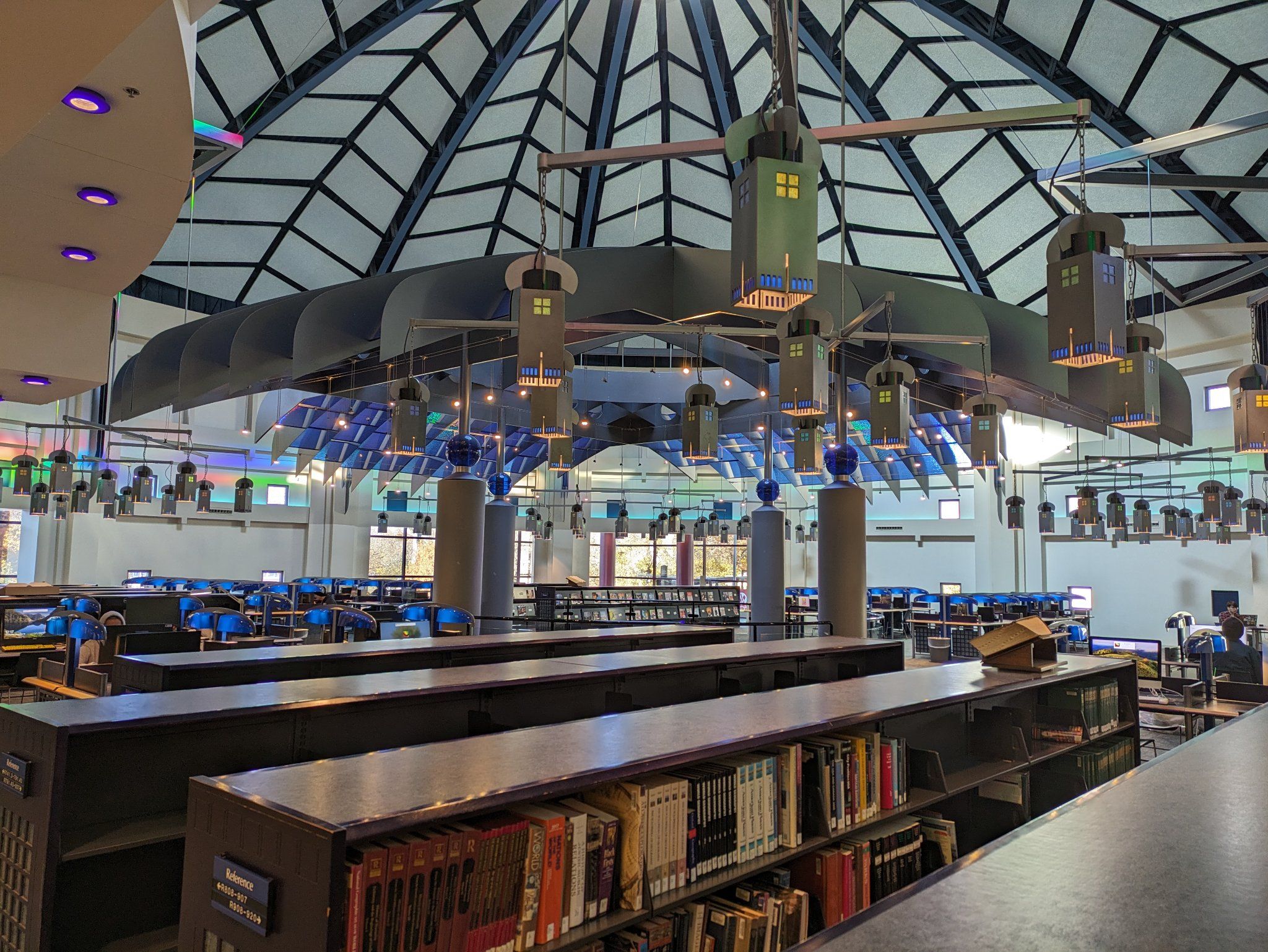
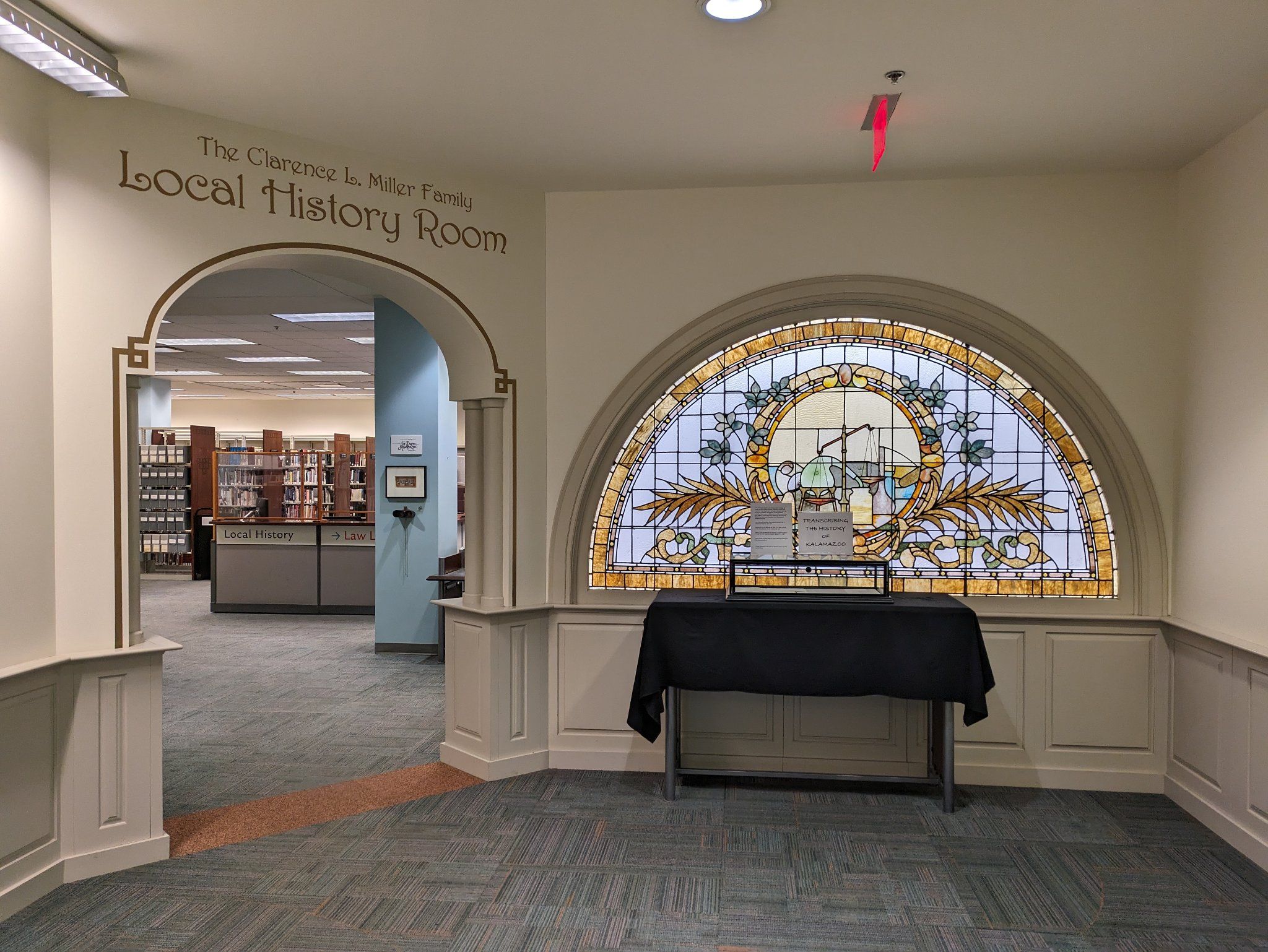
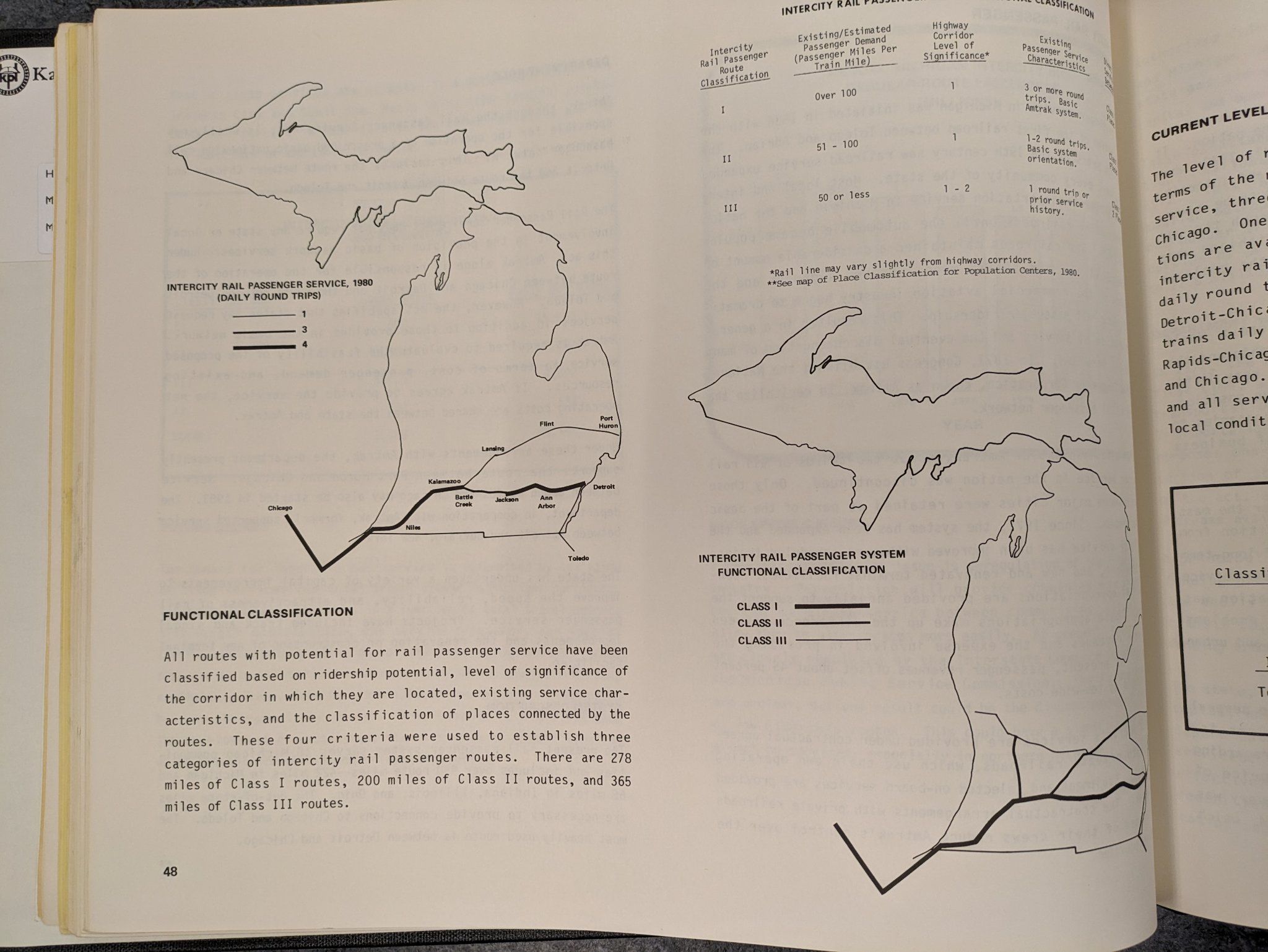
Passing the time in the Local History Room, home to lots of great recollections of intercity passenger rail service over the years.

The rail lines through downtown Kalamazoo are incredibly busy, causing frequent traffic backups. The state legislature launched a grade separation funding initiative this year to address this in key communities, specifically Downriver in Metro Detroit.
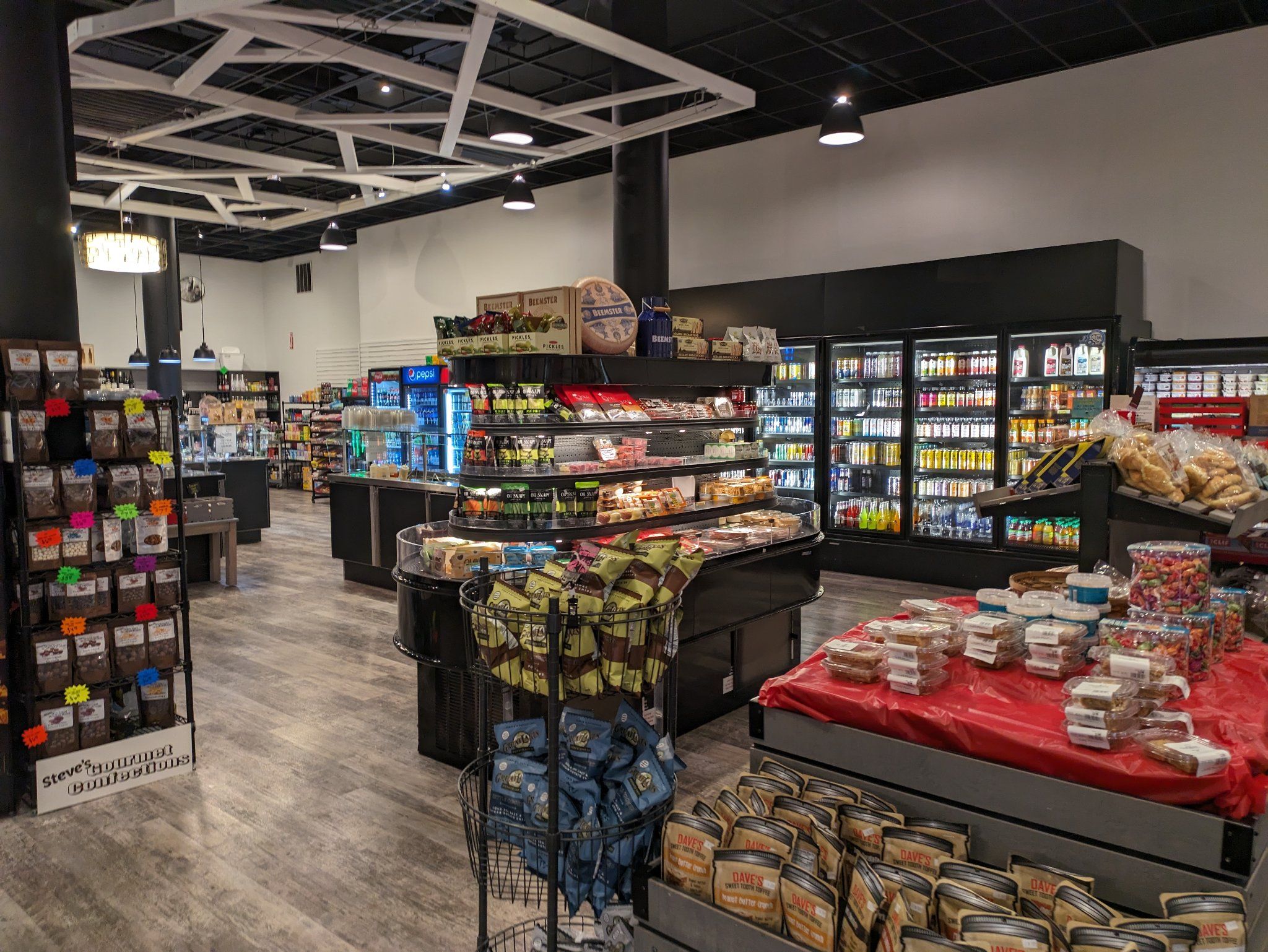
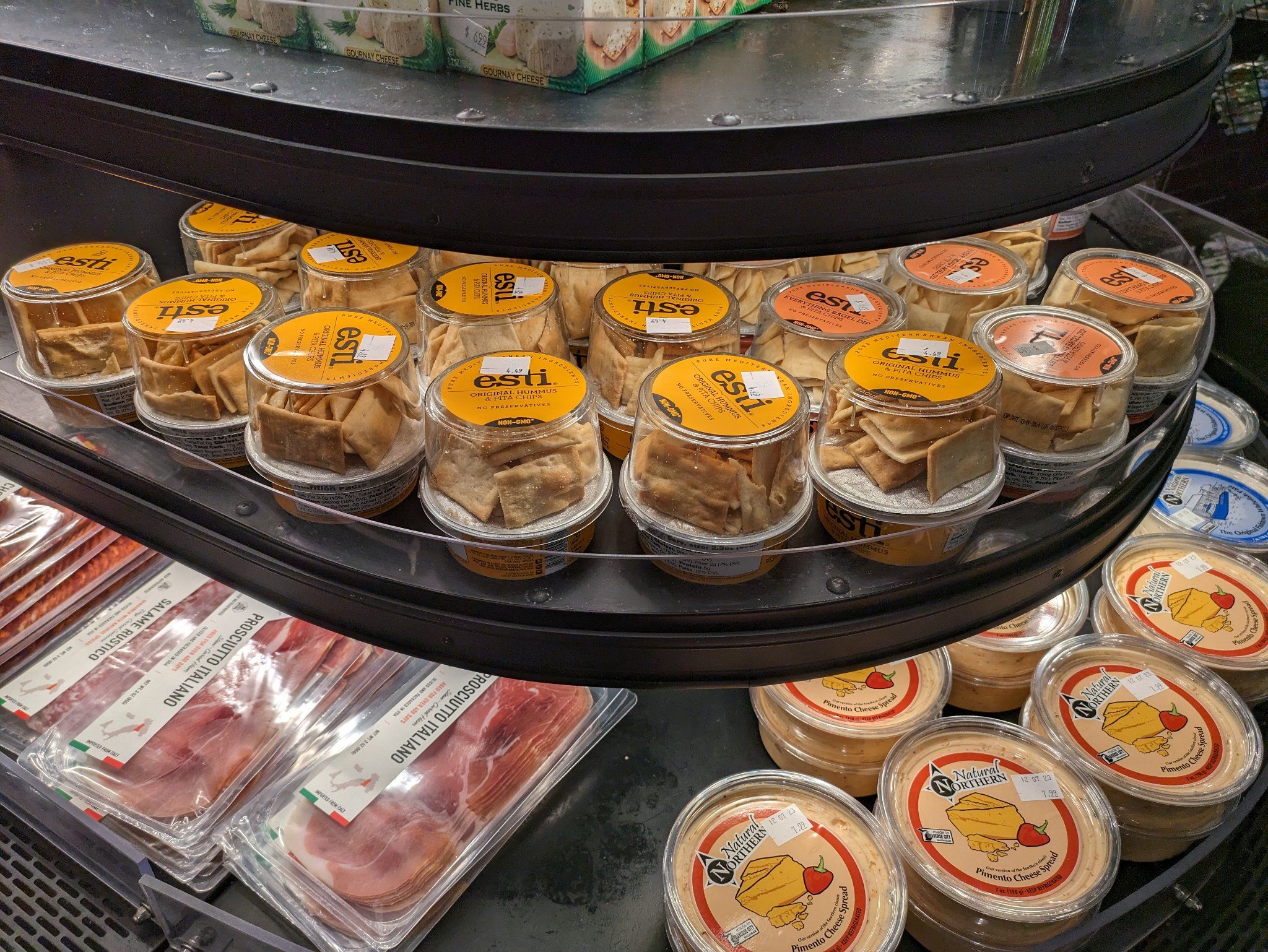
Snacks for the road, courtesy City Centre Market and Deli.
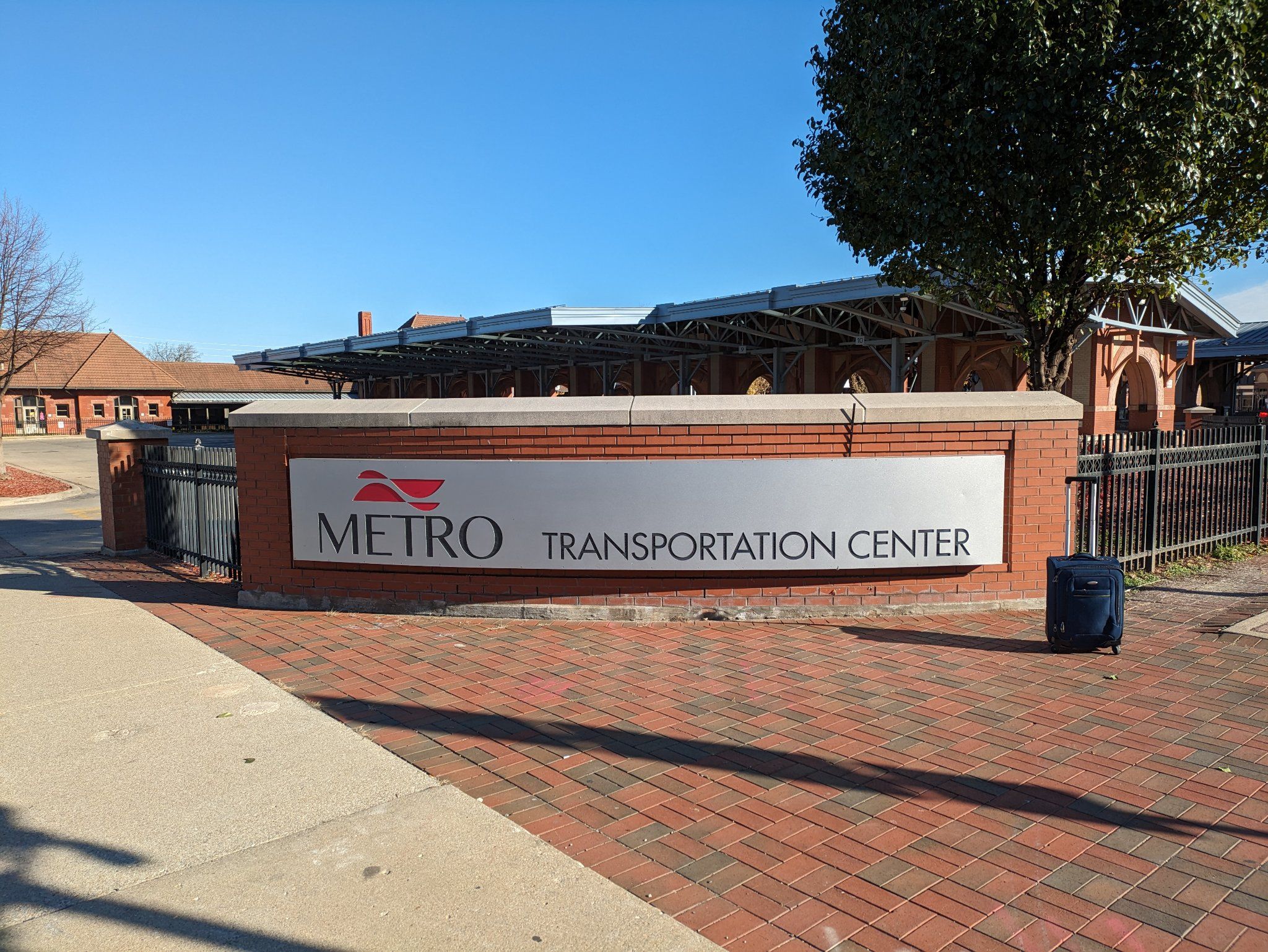
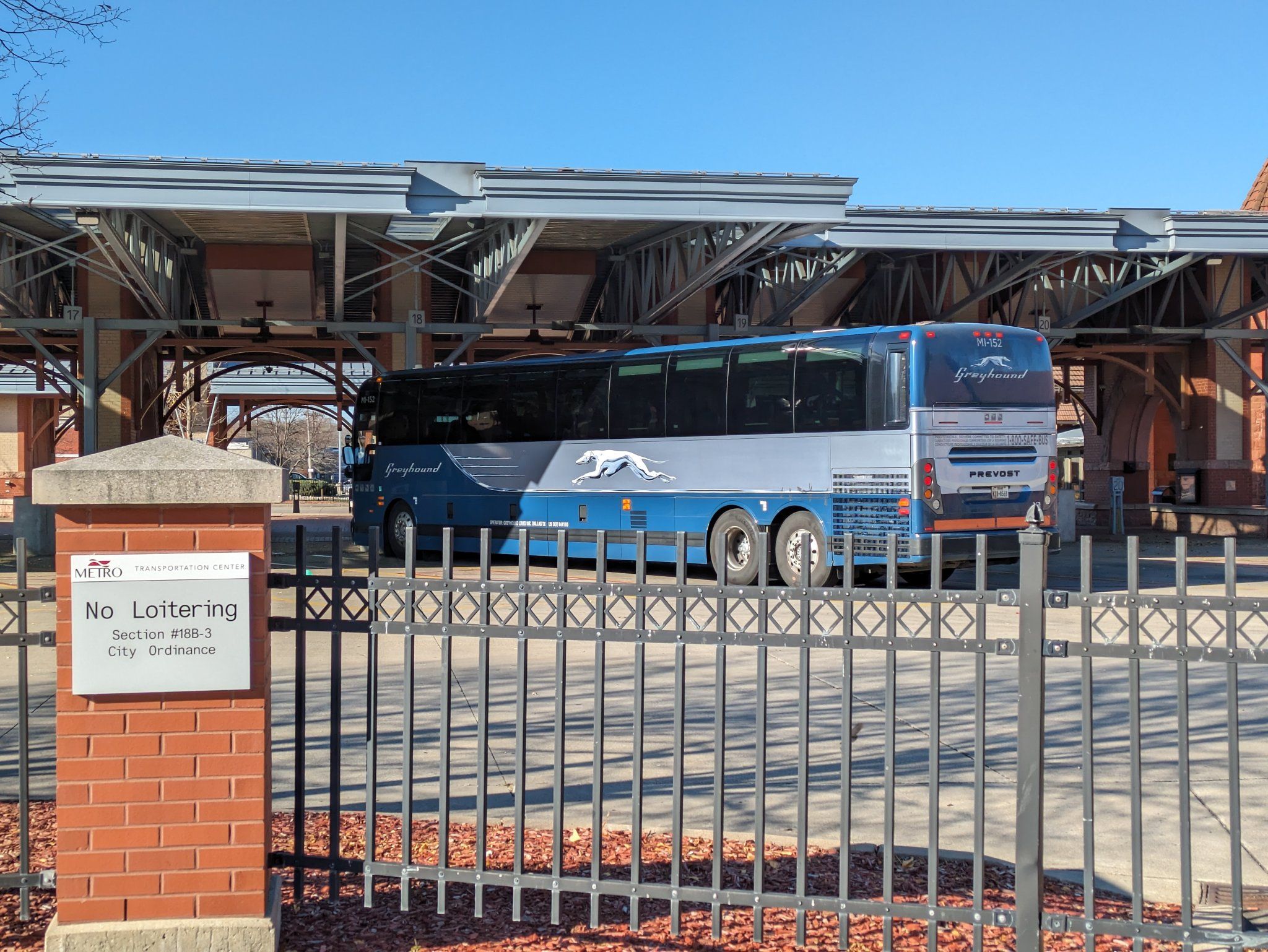
When the day comes for me to book my inaugural ride on Greyhound proper, it’ll be on this route: Chicago to Detroit via Kzoo and Ann Arbor. Short hop (by Greyhound standards) and generally on time.
Act Two: Turning North
After grabbing lunch and stocking up on snacks, it was back to the bus station to climb aboard my home for the next hour – and I was thankful I got to reroll in Grand Rapids, because this certainly wasn’t the newest bus in the fleet.
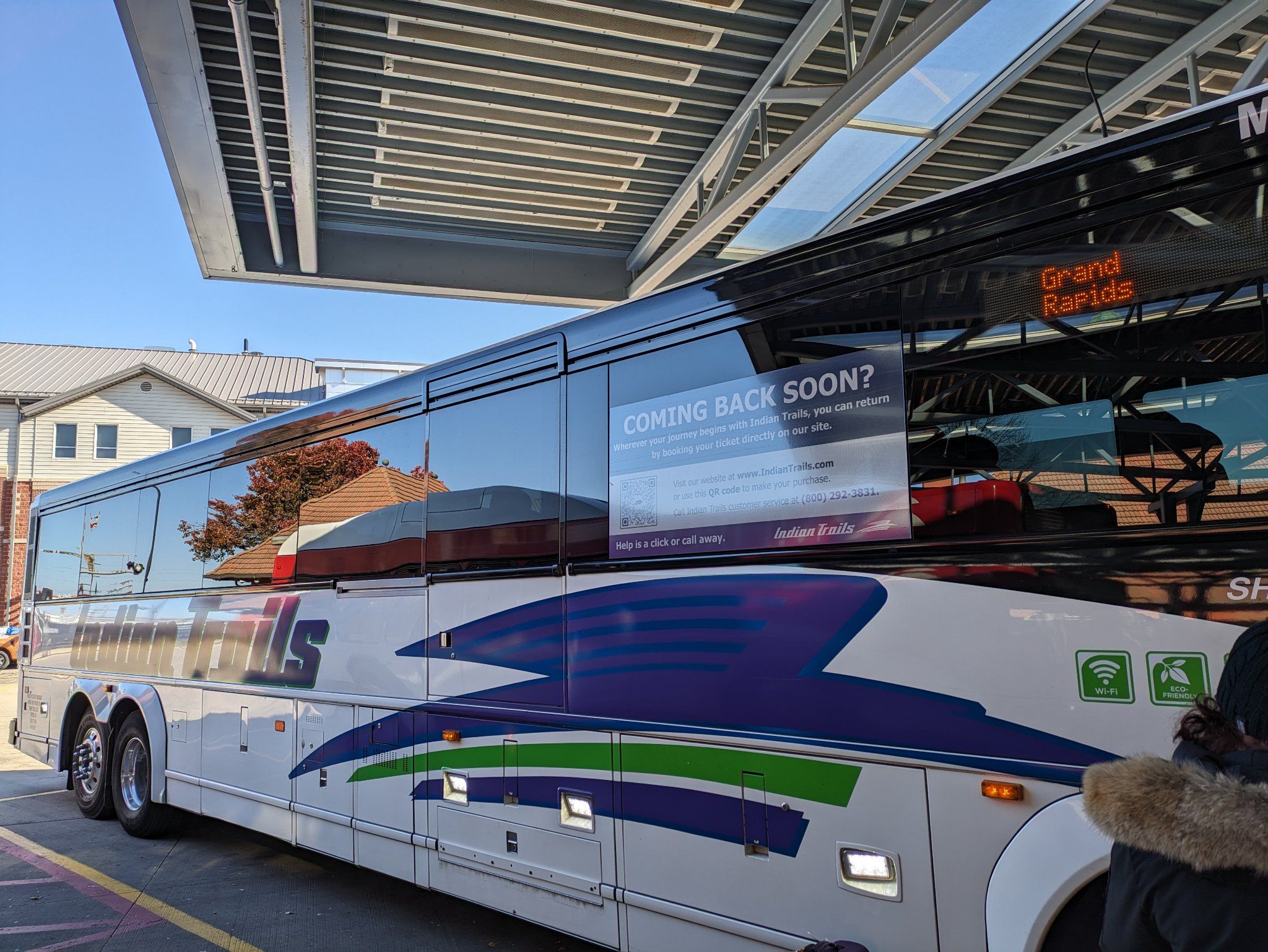
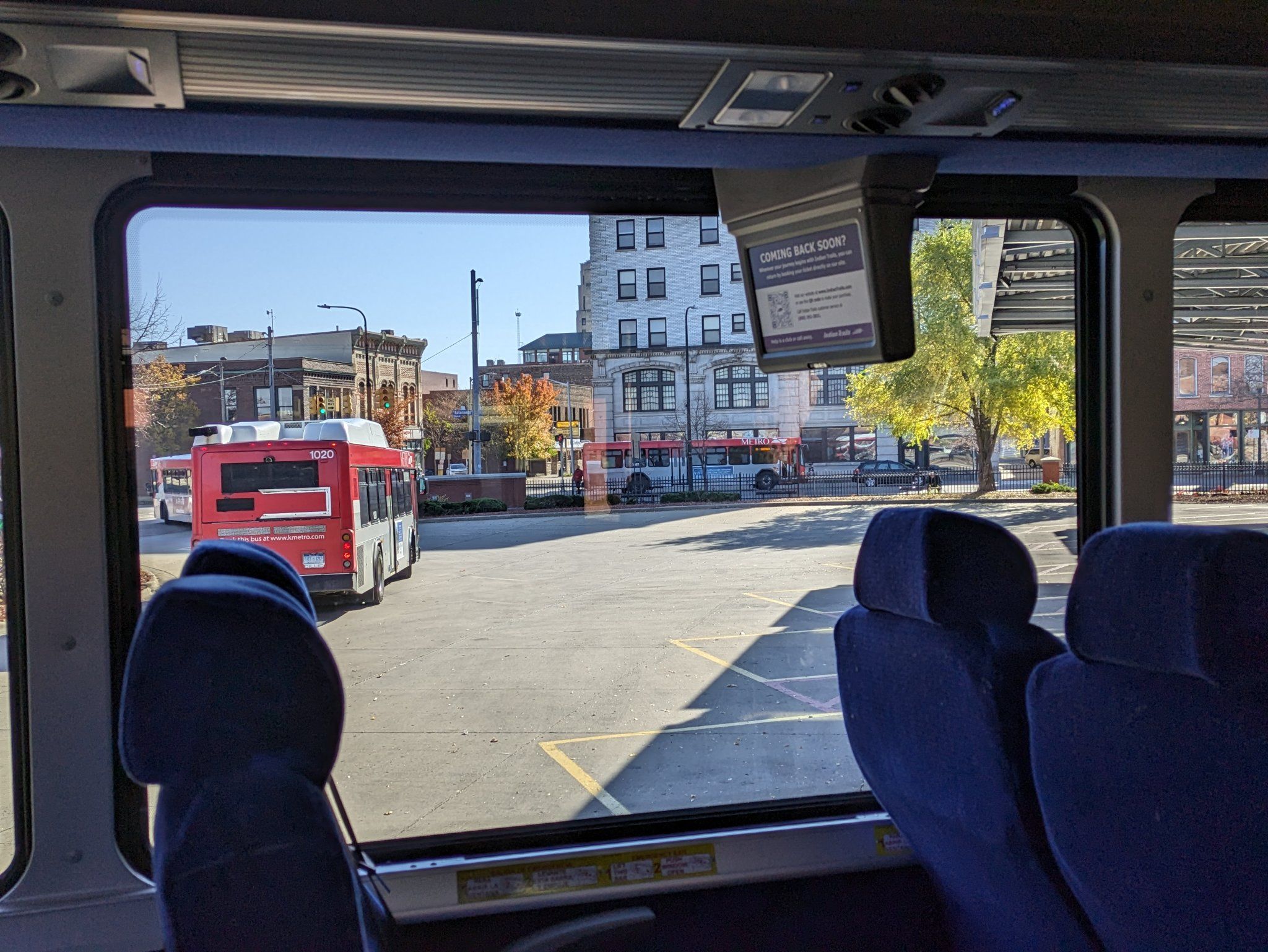
Indian Trails can be a roll of the dice. You might get a shiny new coach with leather seats that fully recline, reading lights, working AC outlets, and panoramic windows. You might also get a bus that’s living in a past decade with blue moquette seats, only USB power, and a whiny engine. It’s all part of the experience.
And reroll I did: In Grand Rapids I scored a two-year-old X3-45, the best model in the fleet for long distance travel. There’s no guarantee of getting one even when you’re traveling across the state, so I was lucky!
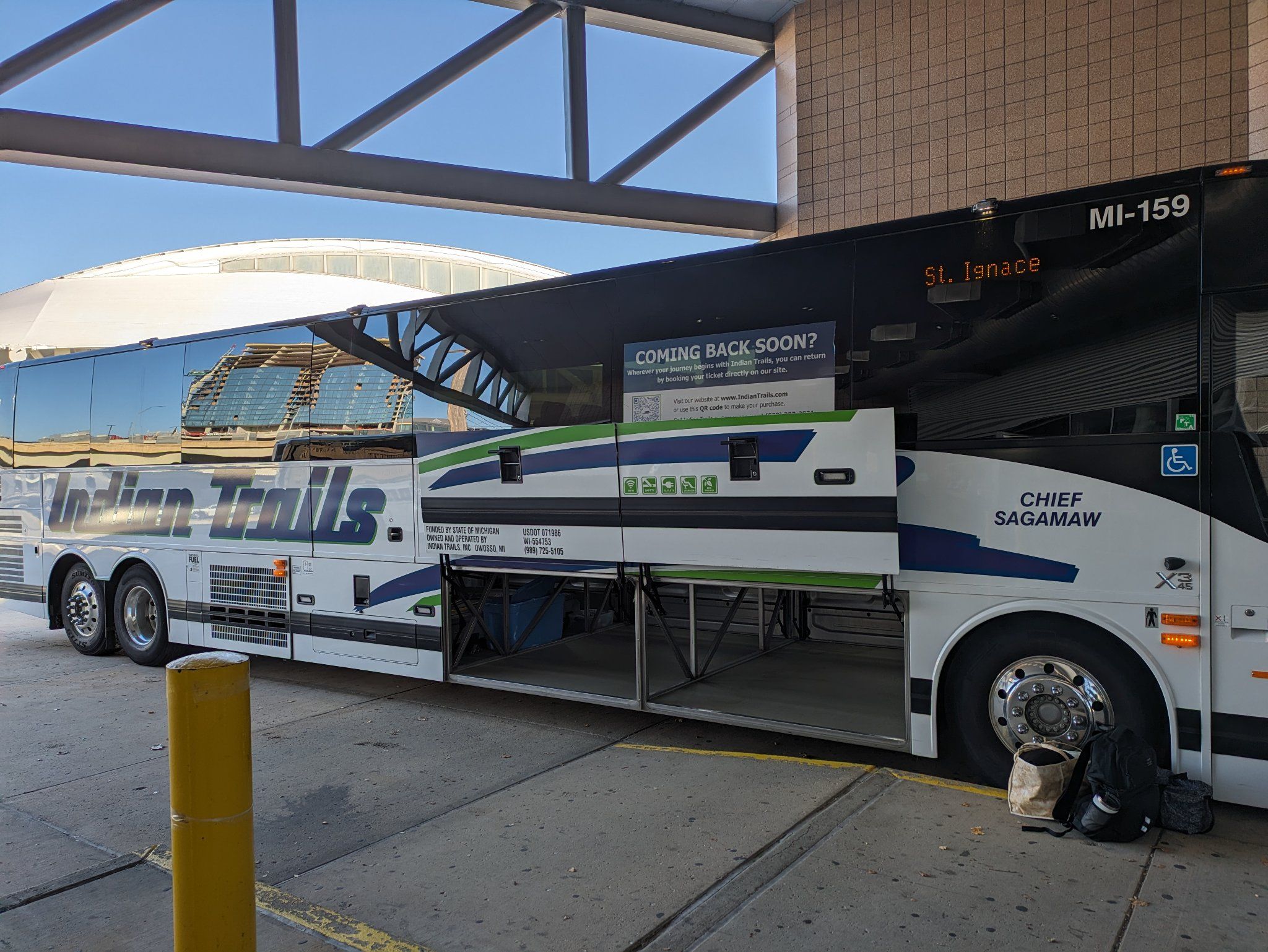
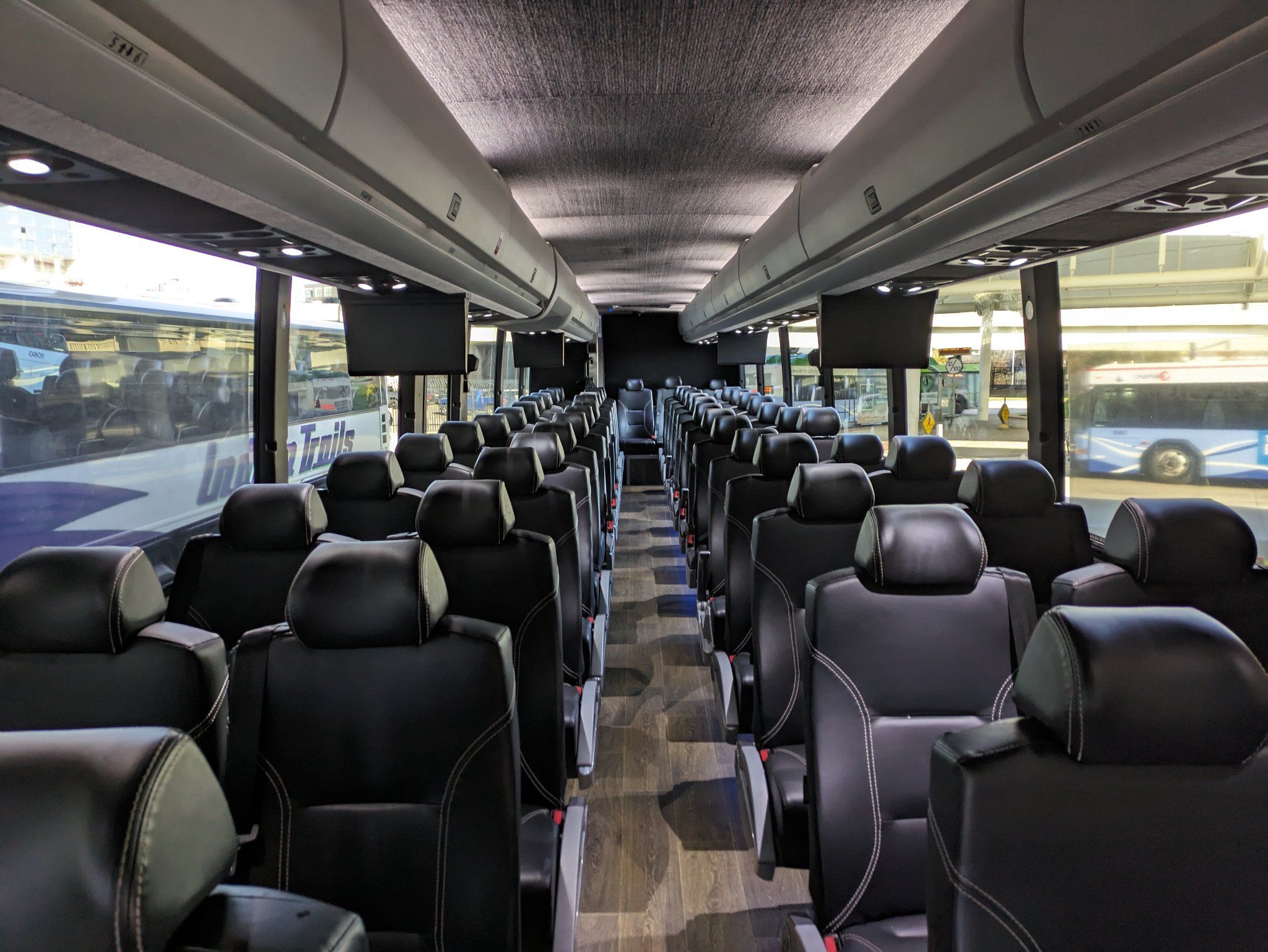

When you get a good bus, the five-hour trip really isn’t all that long!
From this point onward, I was in uncharted Trails territory. Gone were the major bus and train stations: In their place were gas stations, hotels, and party stores.
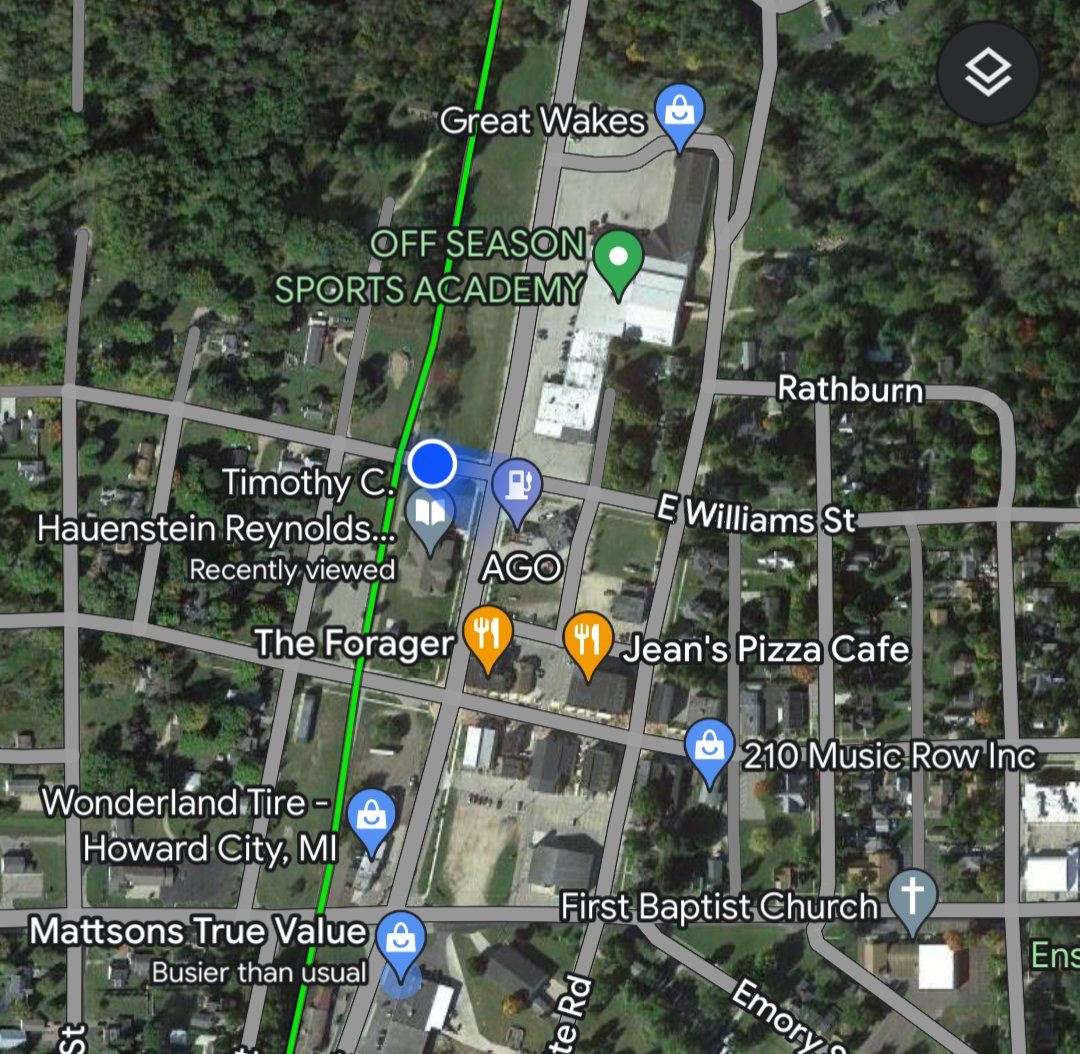
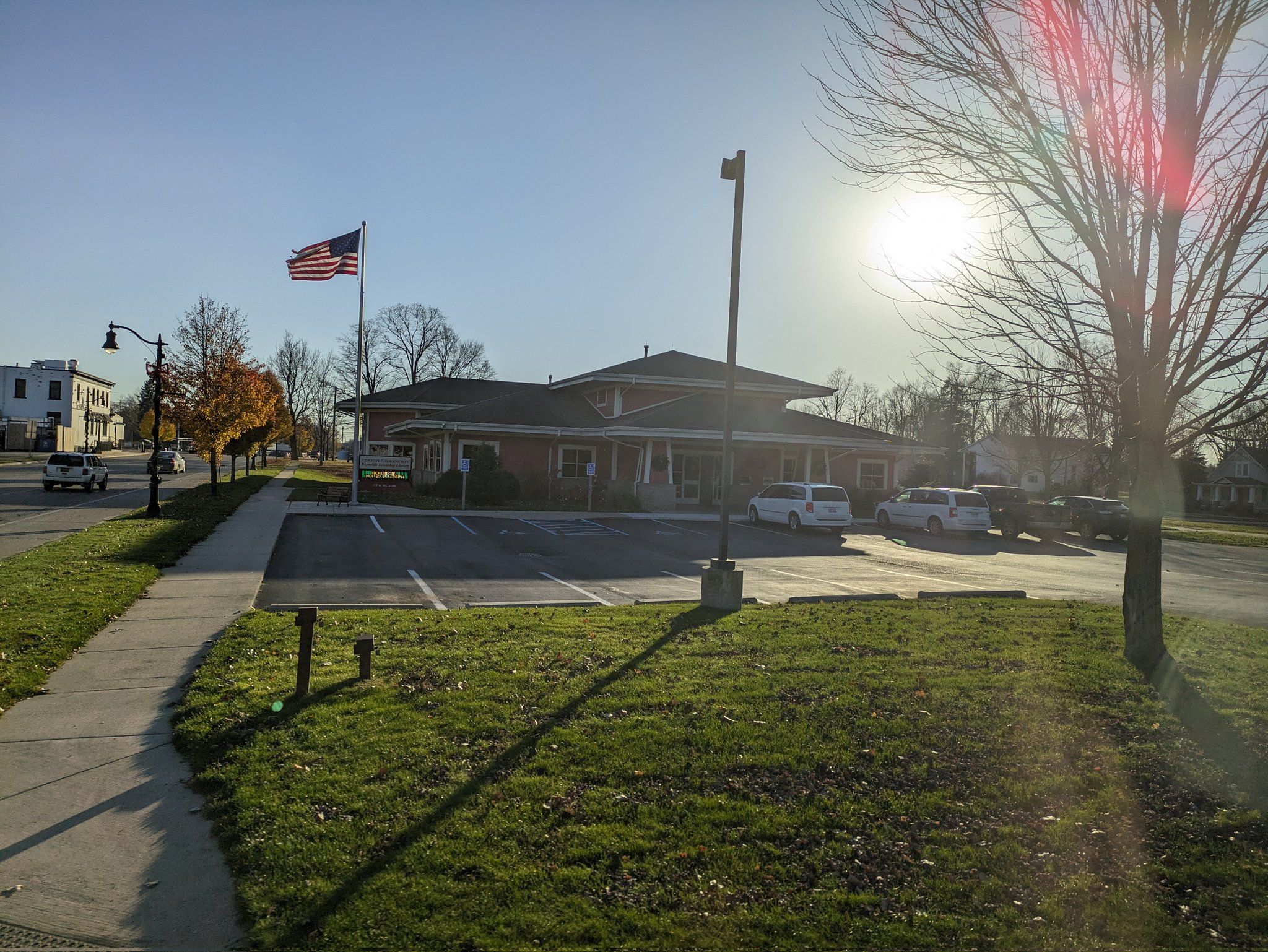
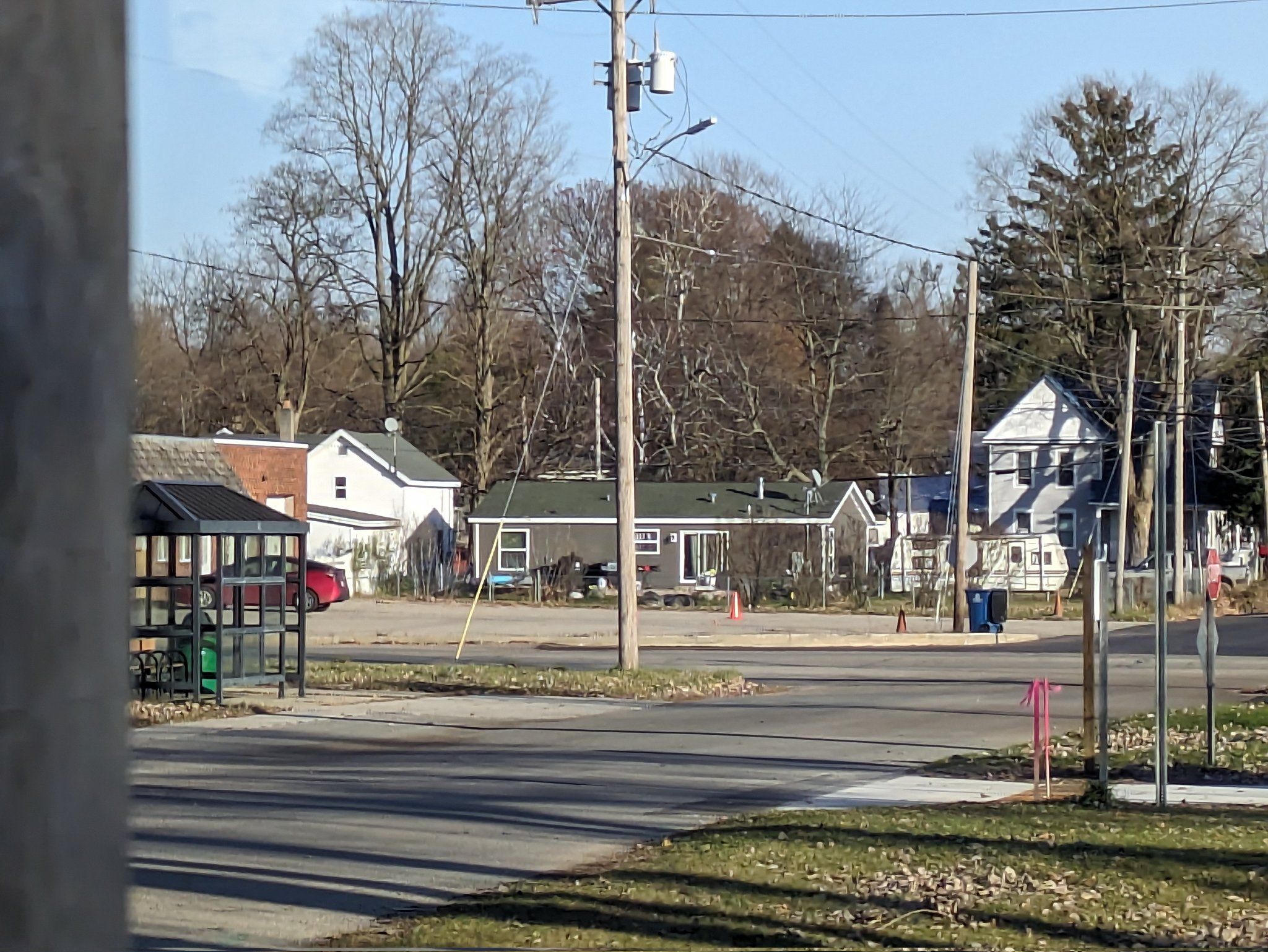
Howard City, which boasts its participation in Michigan’s 2004 “Cool Cities” program on welcome signs, is one of several small towns the Indian Trails bus winds through on its way north towards Mackinaw City.
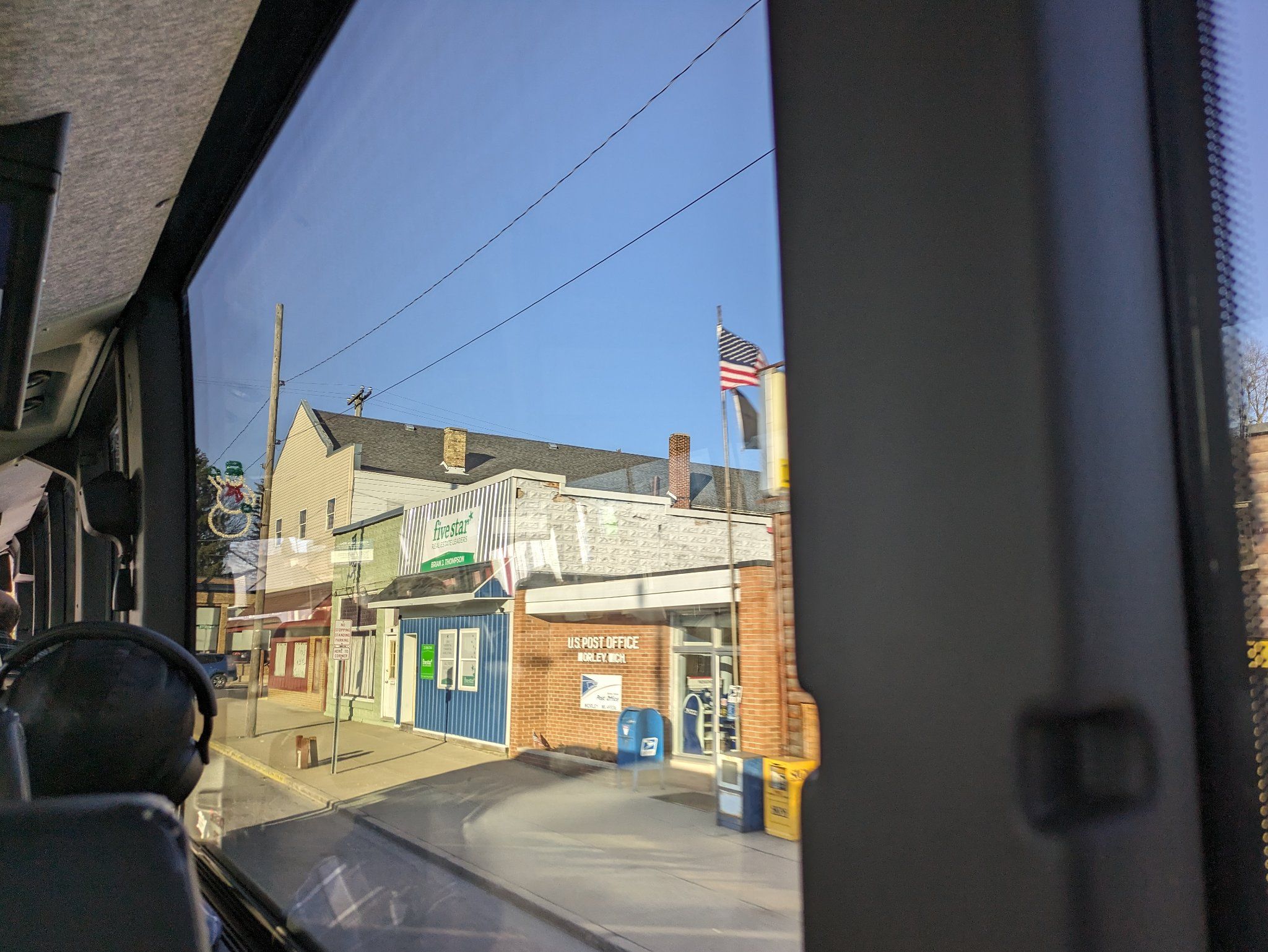
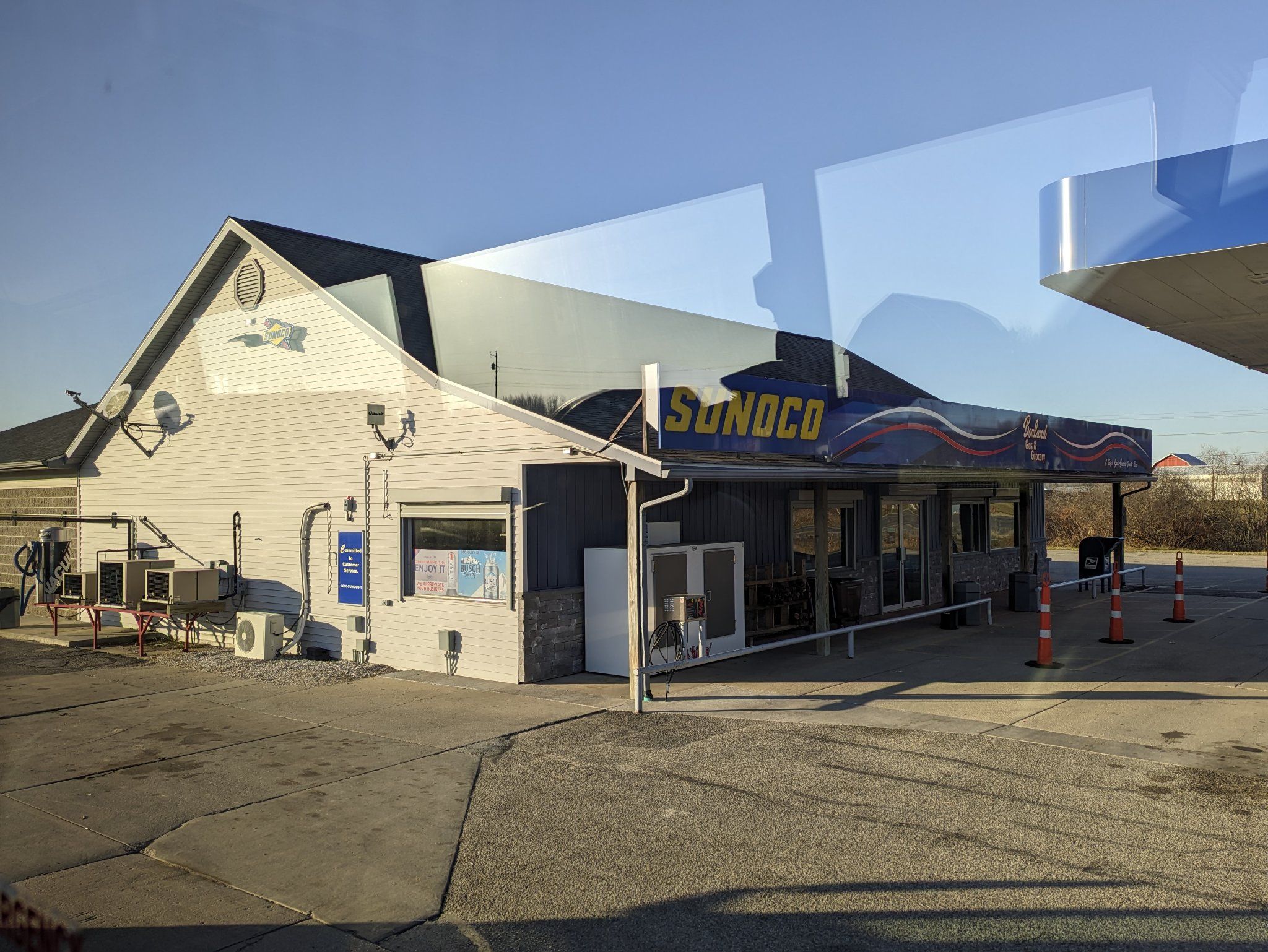

Morley and its two stops: The gas station and a party store which serves as the gateway to Stanwood.
The first major stop north of Grand Rapids is Big Rapids, just south of Ferris State University. On my return trip from Traverse City, several college students boarded here to head home for Thanksgiving break.
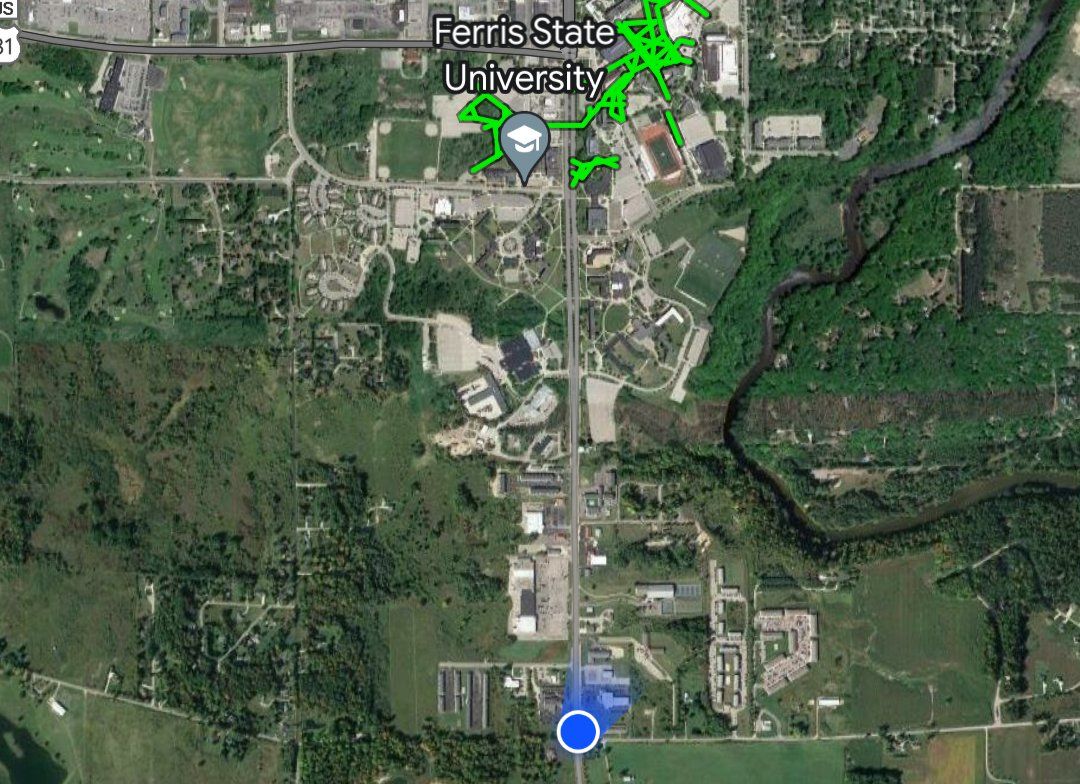
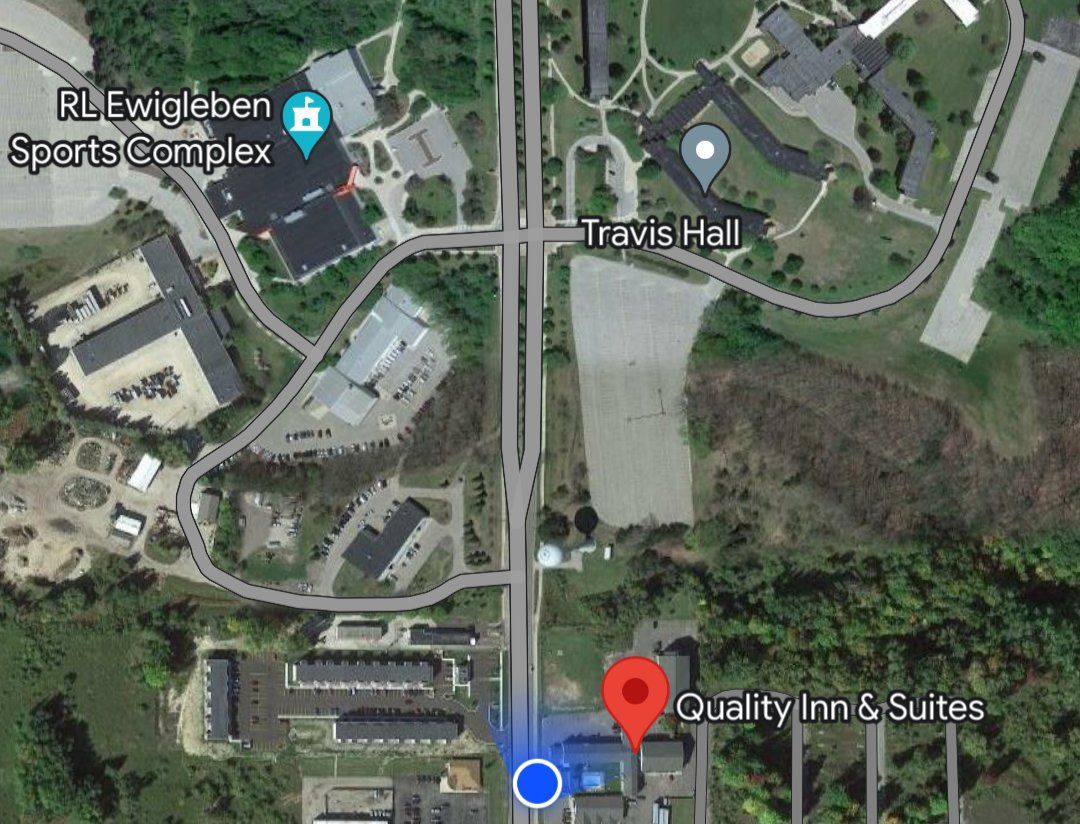
I’ll stay here if I ever visit Big Rapids. Talk about door-to-door transportation!
A tour of campus in 90 seconds
Second Intermission: Hey, who’s getting hungry?
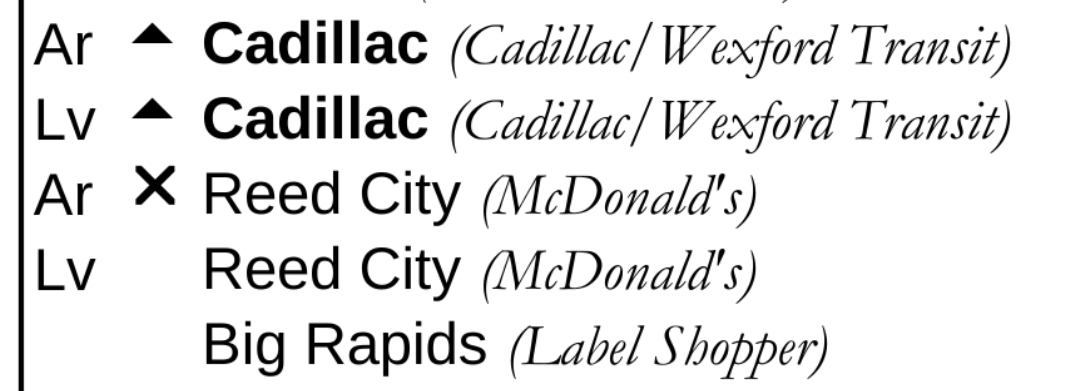
See that ‘x’ next to Reed City on the official itinerary? That’s the meal stop. Only the three longest Indian Trails routes – the three that cross the Mackinac Bridge – have one.
You get 25 minutes. These buses have over 50 seats. Do the math.
Yup. That’s why I planned out the Kalamazoo snack stop.
Our Indian Trails driver explains the upcoming meal stop.
I’ll be real: I expected the kitchen crew to be cold towards us given the hostility towards transit riders I’ve grown accustomed to in Metro Detroit, but they were actually super welcoming and made sure we were fed. It wasn’t their first rodeo by any stretch. I bought a pop and ate my snack tray in the parking lot without a hitch. The owners even let Indian Trails put a little sticker on the door.
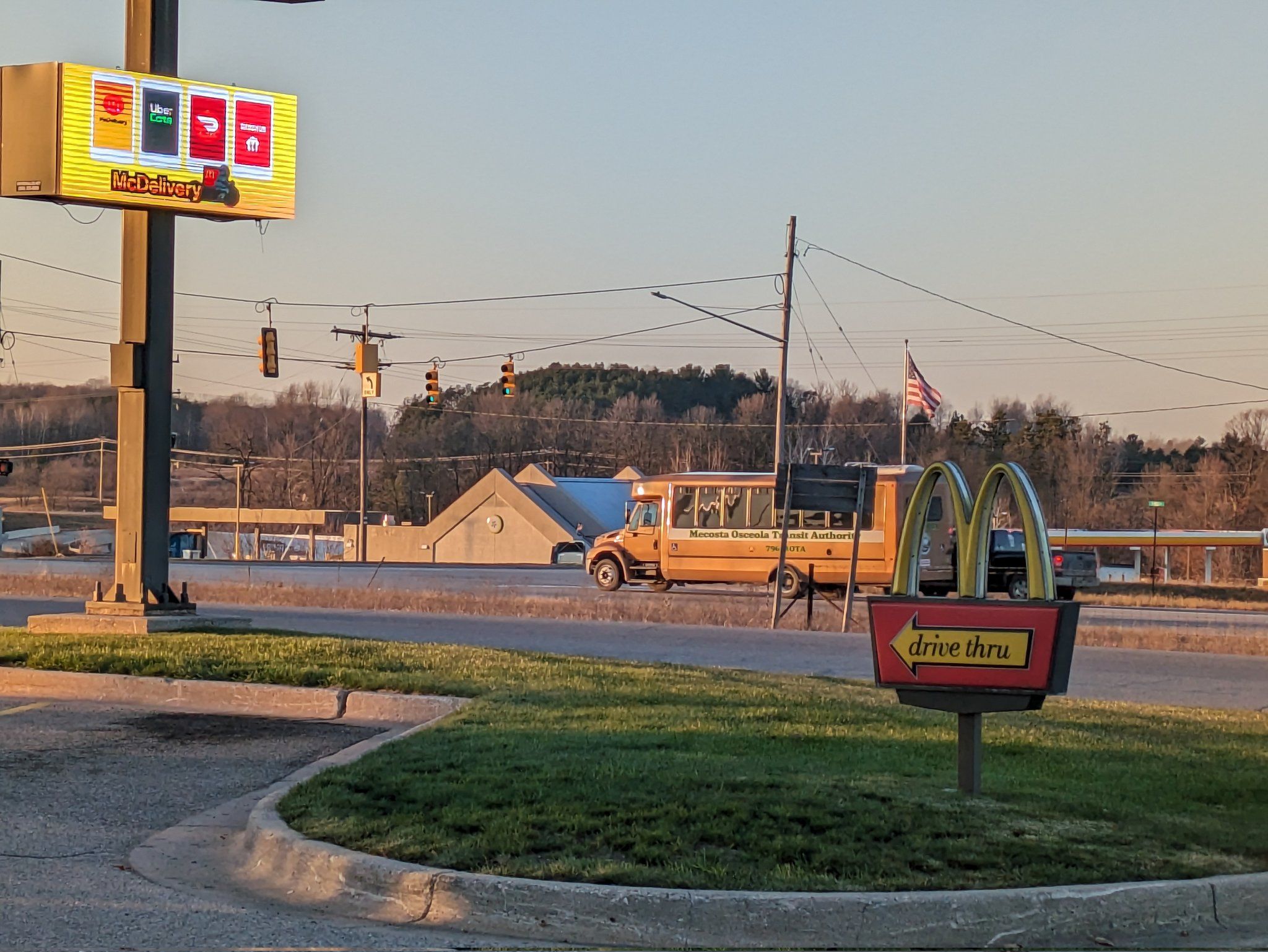

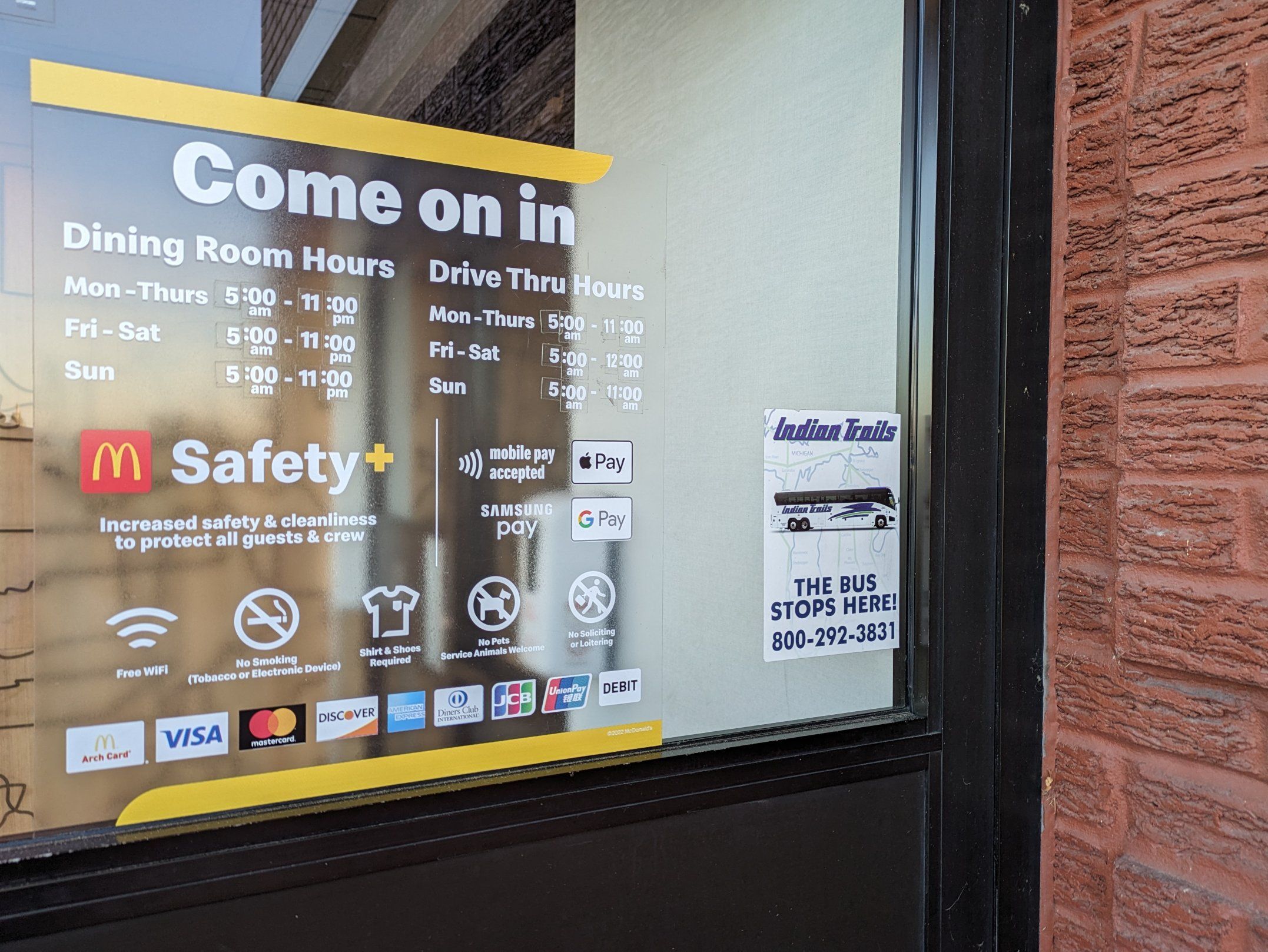
This was the part of the trip I’d been dreading the most and it turned out to be a complete non-event. It was just a stop for food, no different than taking a break on a road trip.
Act Three: Officially Up North
Crossing the White Pine Rail Trail and finally reaching what every Michigander would agree is “Up North”
Cadillac has an entire terminal dedicated solely to Indian Trails and the Cadillac/Wexford Transit Authority (WexExpress). Interestingly, it wasn’t built near the rail line and walkable streets of downtown but instead directly off US 131 for easy highway access. Considering WexExpress serves the entirety of Wexford County on demand, not just Cadillac, this placement has its advantages.
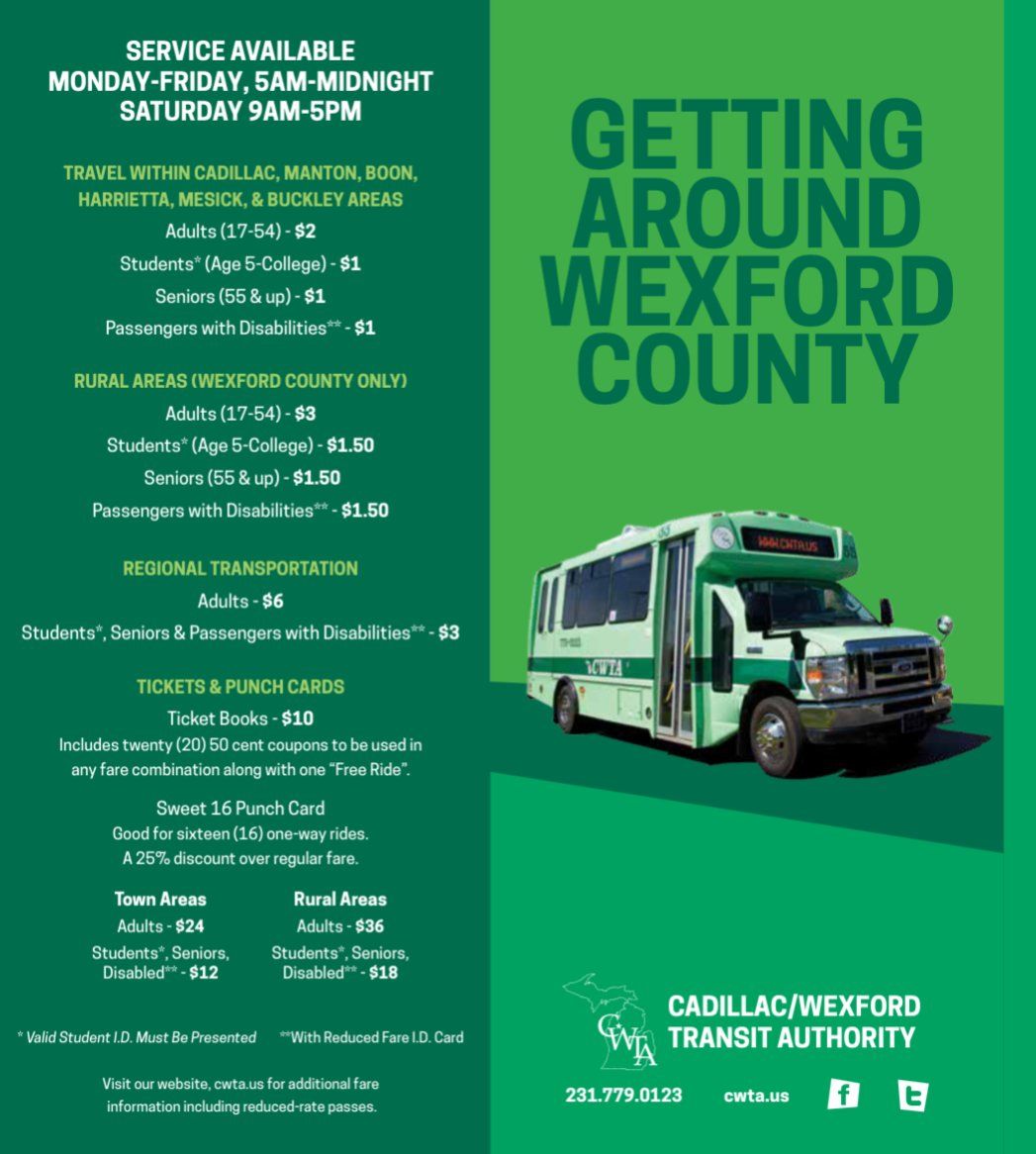
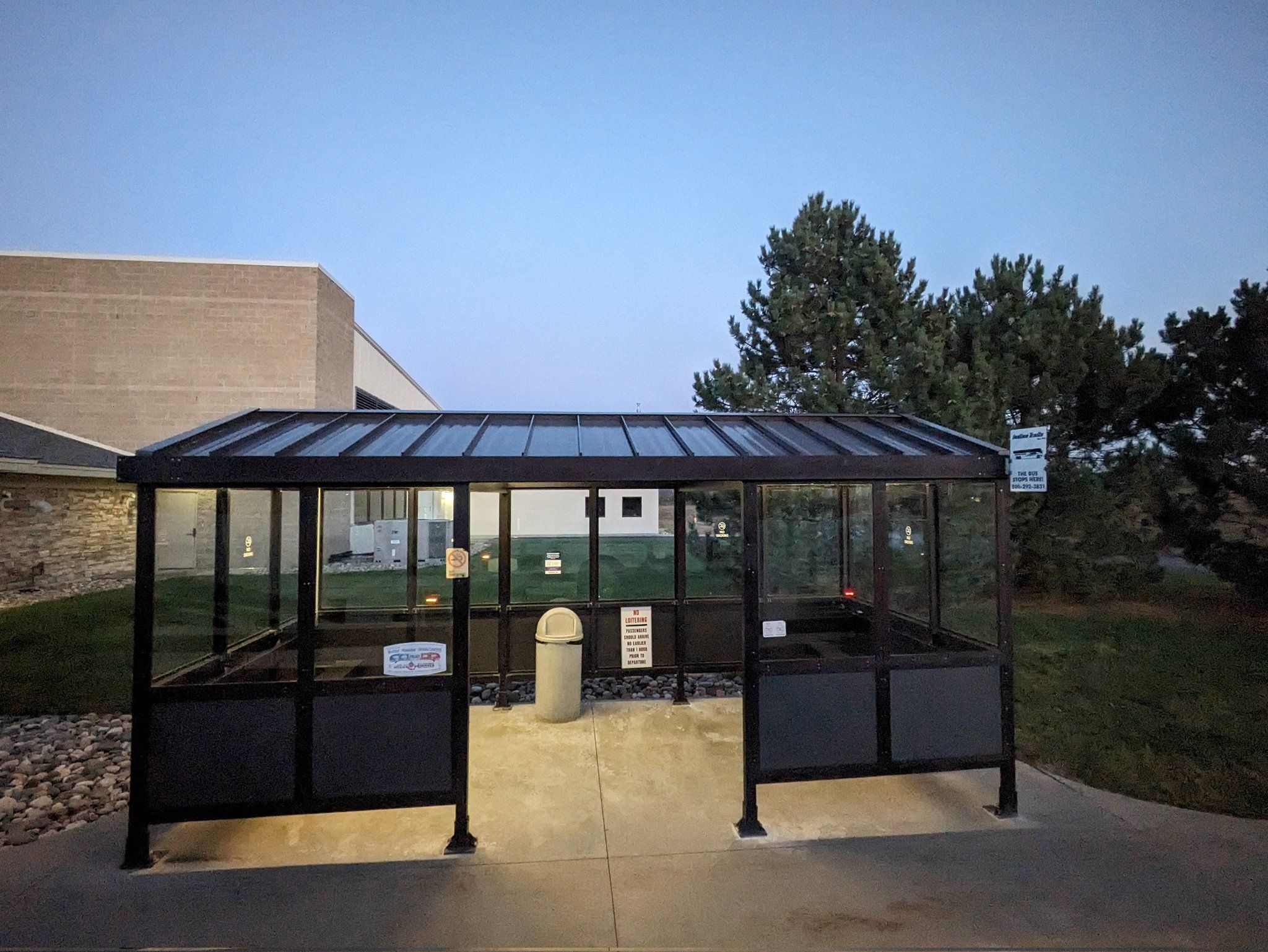
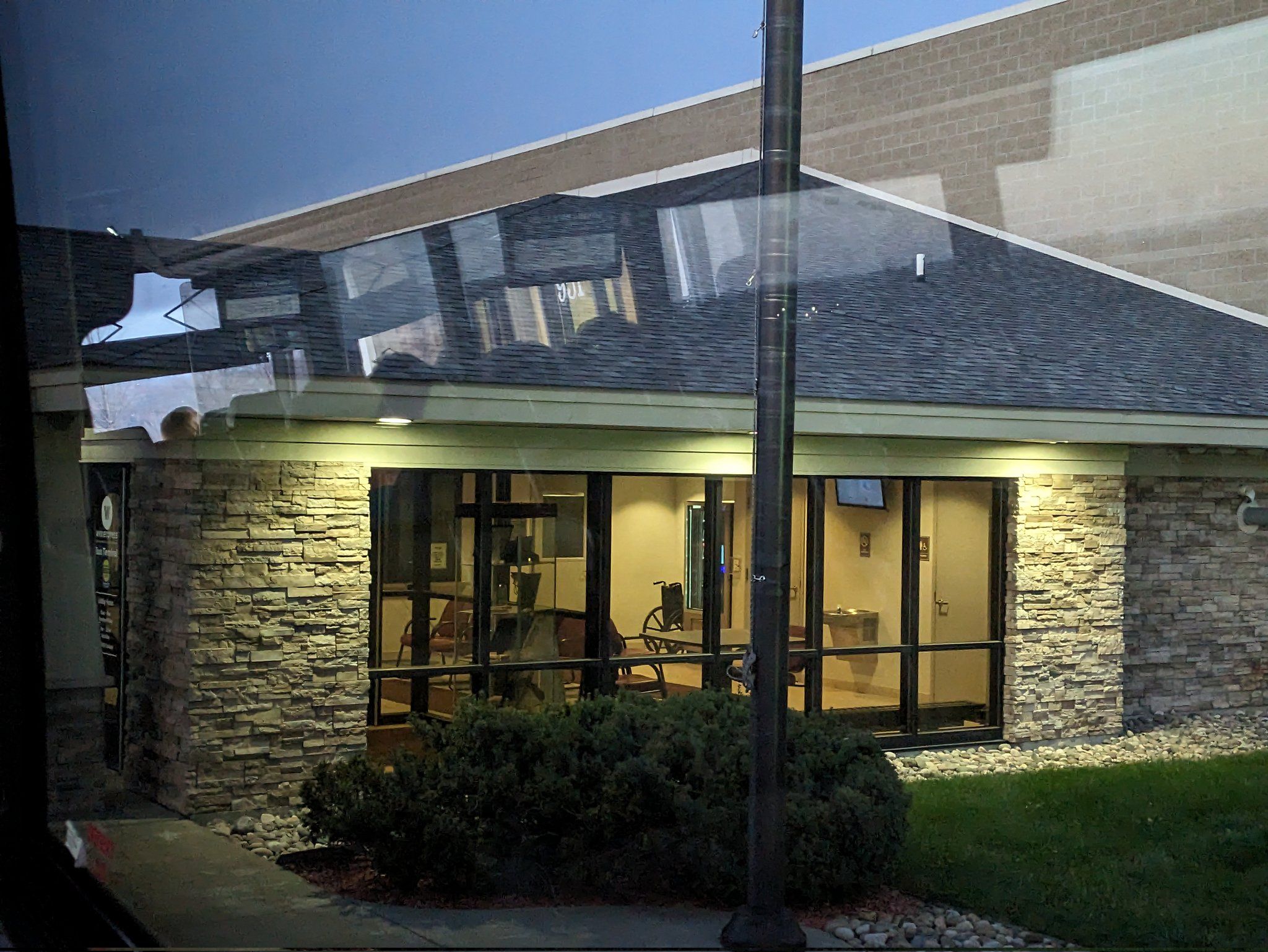
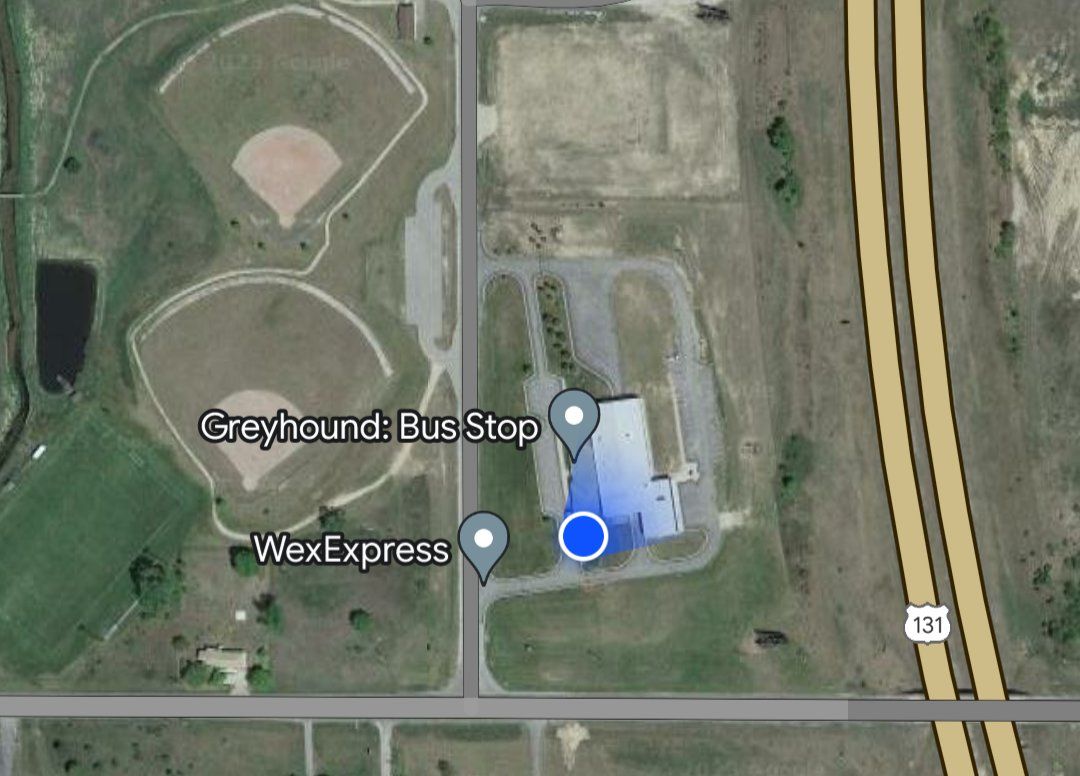
If you live in downtown Cadillac, you can’t get to Indian Trails by walkin’ (at least, not easily). You’re looking at a local bus connection to get you there.
Cadillac at least had a dedicated indoor waiting area. Most other Trails stops north of Grand Rapids left riders to fend for themselves.
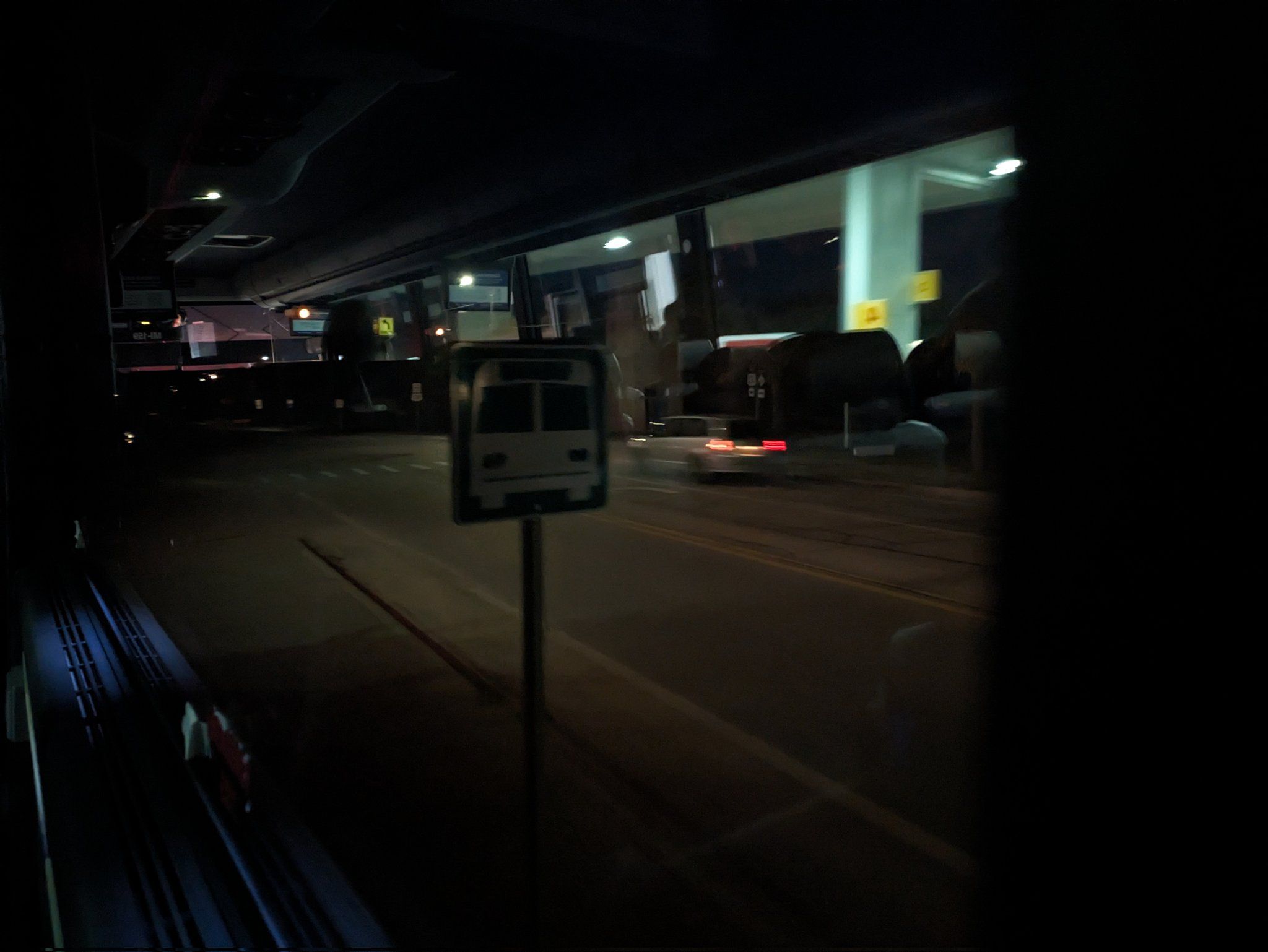
The Indian Trails stop in Manton. No infrastructure, just 🚍
Just before 7:00pm – right on schedule – we rolled into the Hall Street Transfer Station. From here, I was on my own to explore Traverse City’s transit system.
Traverse City Transit: A Primer
Traverse City’s transit provider is the Bay Area Transportation Authority (BATA) . It’s really unique: Fixed routes are run on minibuses with bike racks instead of 40-footers. Most routes run hourly or once every two hours, with one notable exception: The Bayline, which runs every 15 minutes along the bay (as the name implies).
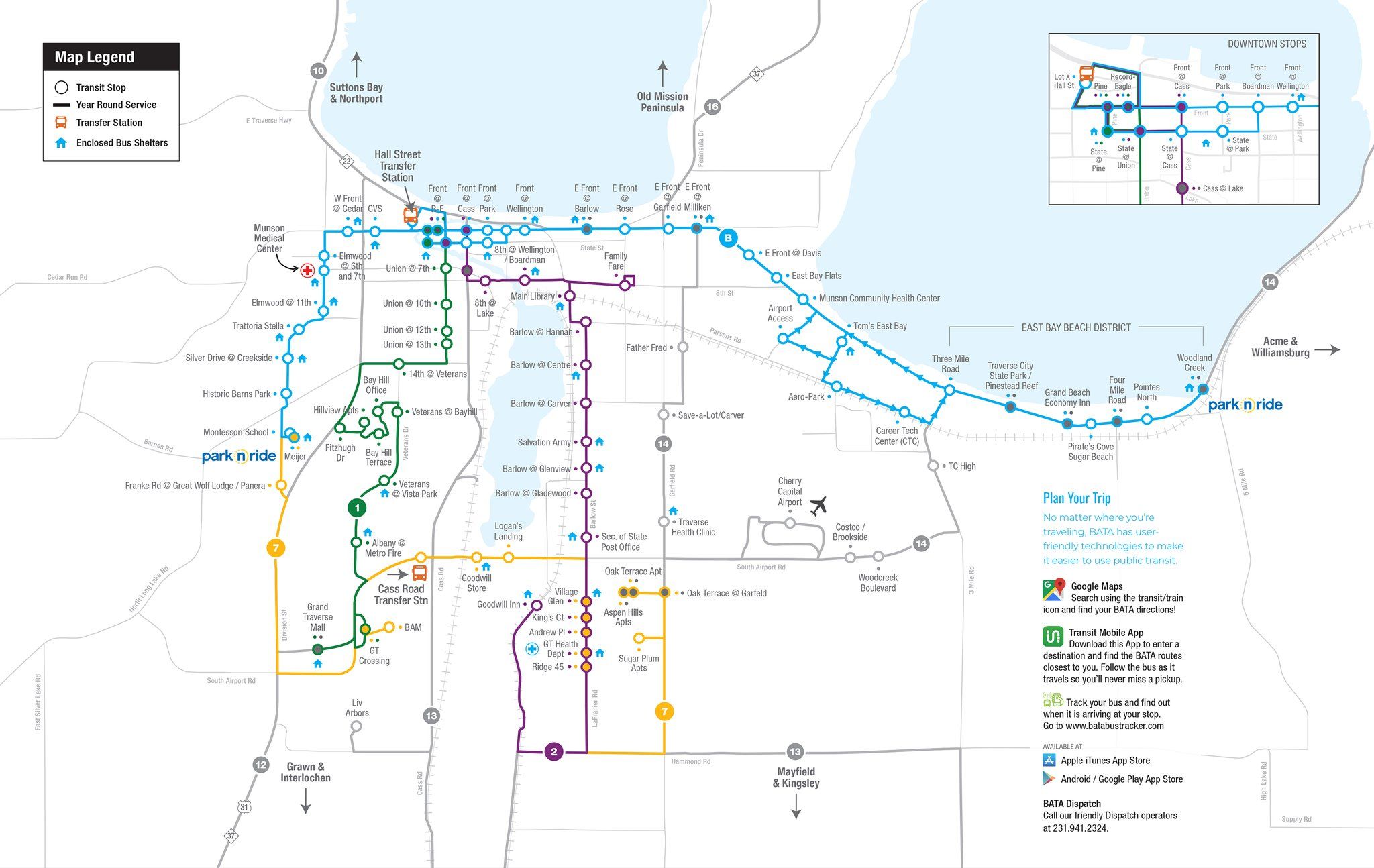
More interesting though is BATA’s on-demand system, Link. If you’ve been following my efforts closer to home, you’ll know I have… Feelings about microtransit and Via , but this system is different: It’s not vans, it’s still minibuses and it’s not contracted workers, it’s still BATA’s own employees.
It’s a dial-a-ride conversion. A few years back BATA replaced the original City Link system with on-demand service powered by TransLoc. More recently they switched to Via for dispatch, the same system SMART uses for Flex. During the day, the service zone is absolutely, mind-bogglingly MASSIVE compared to the small, separated zones we’re used to in Metro Detroit.
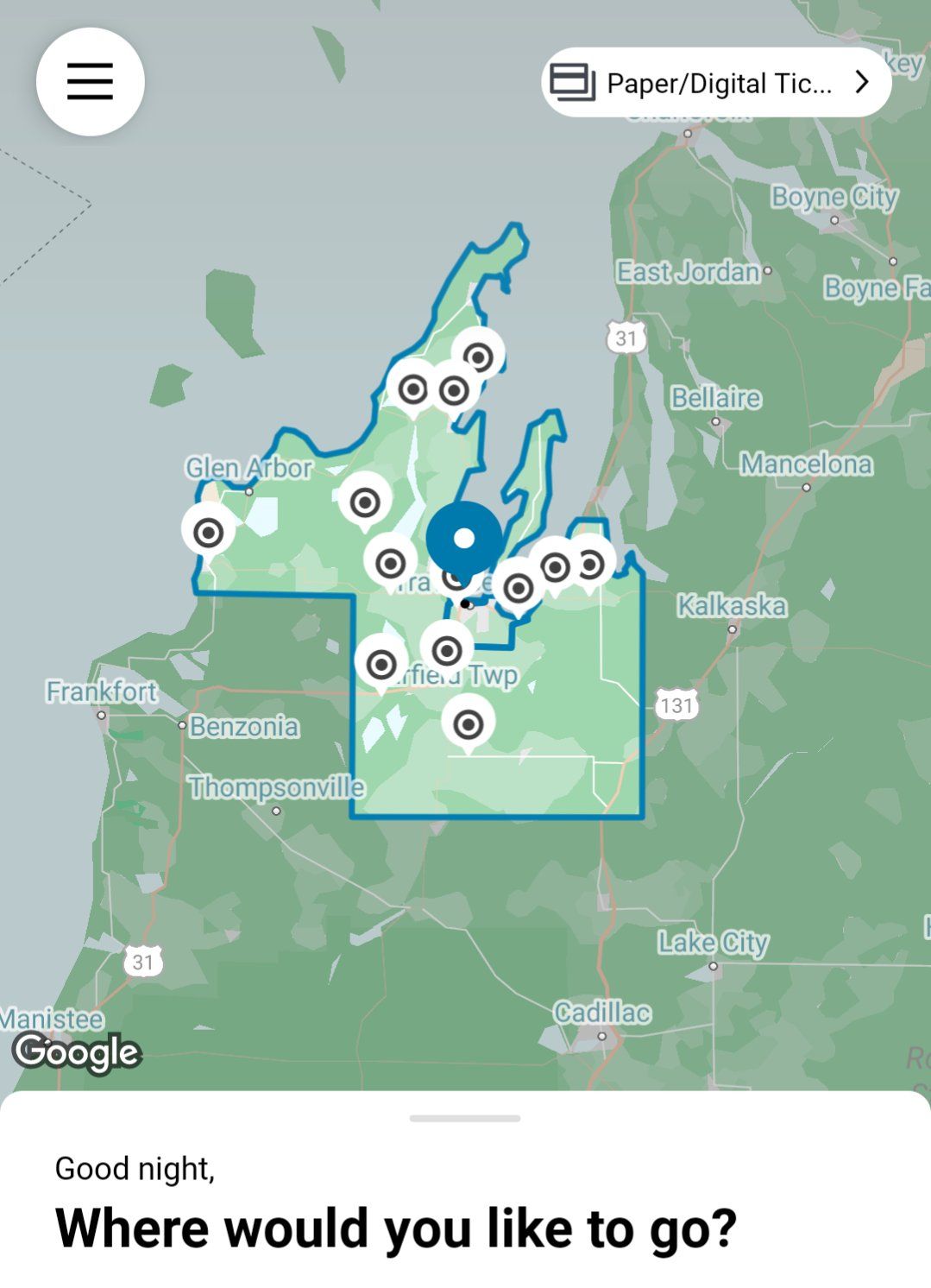
I can go anywhere…
I took Link for a spin on my second day in the city. But first up: The Bayline to where I was staying the night.
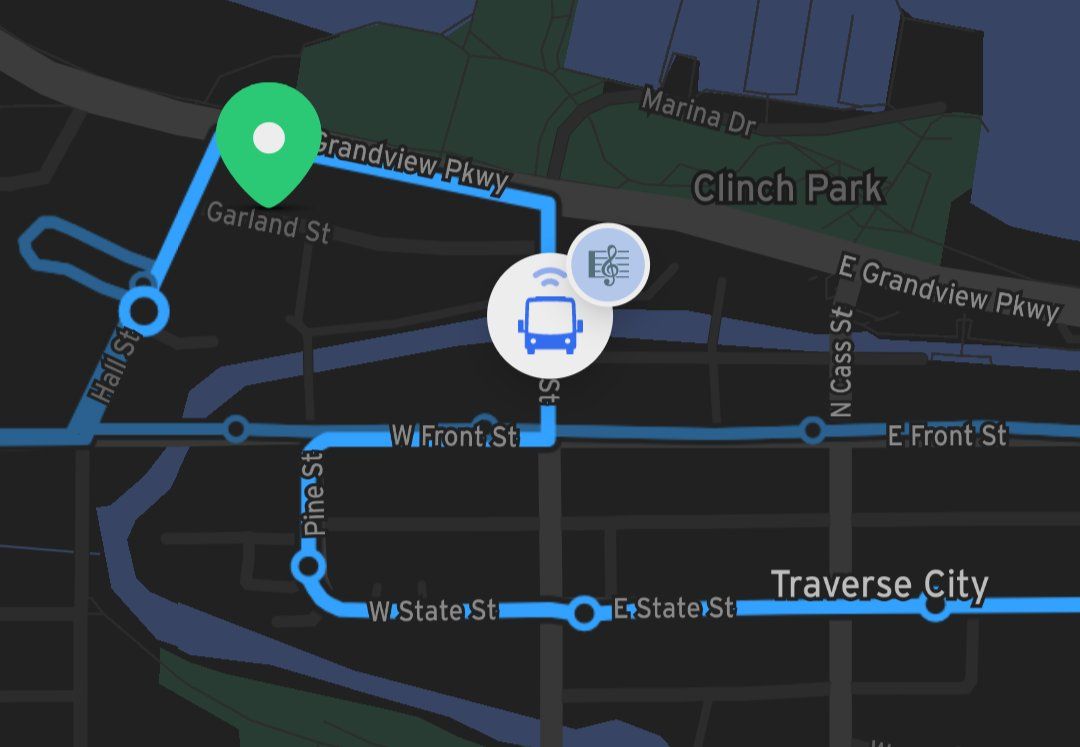
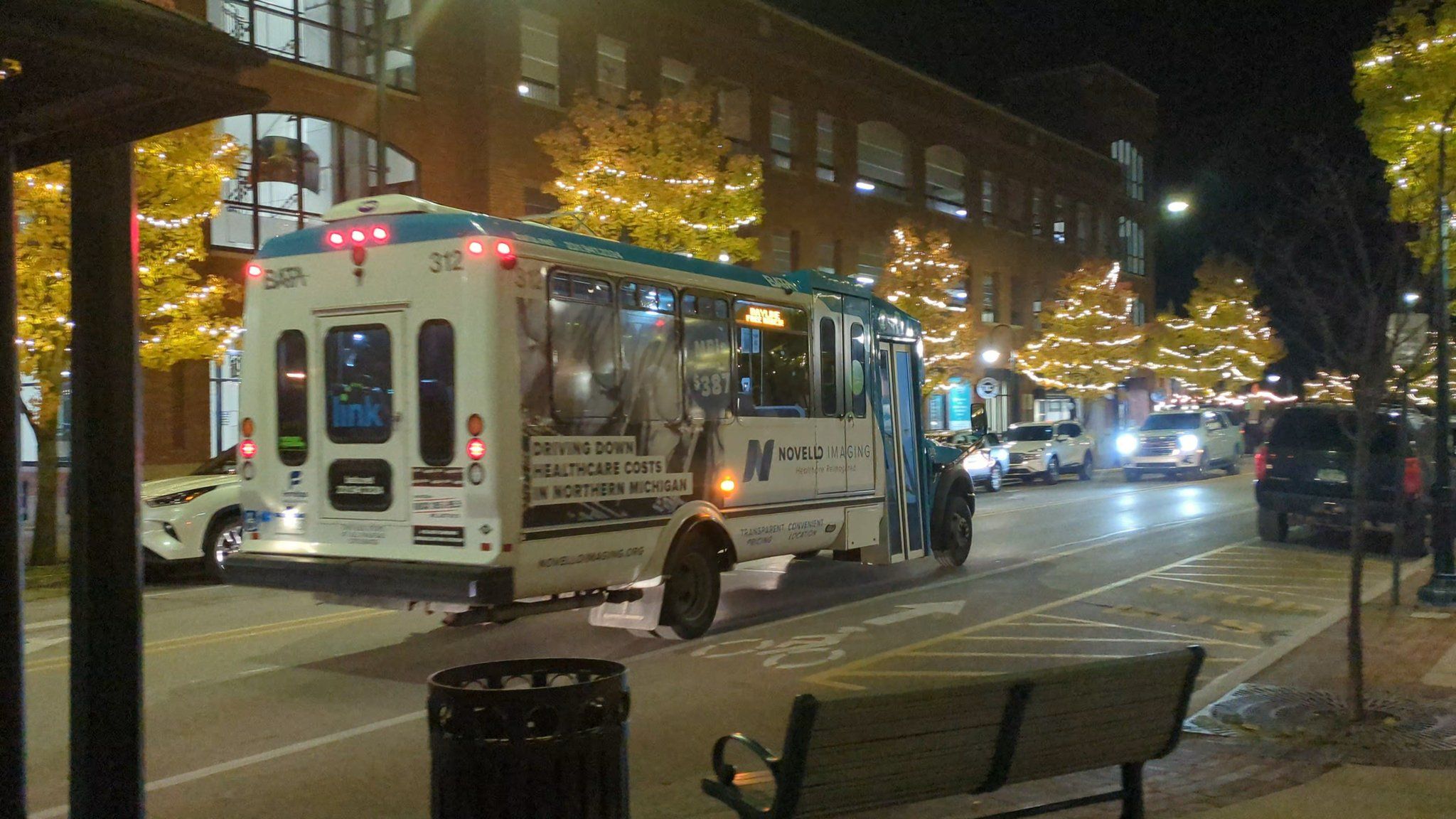
Minibuses with bike racks and stop request cords. It’s bizarre, in a delightful way.
The Main Event: Touring the Groundwork Center
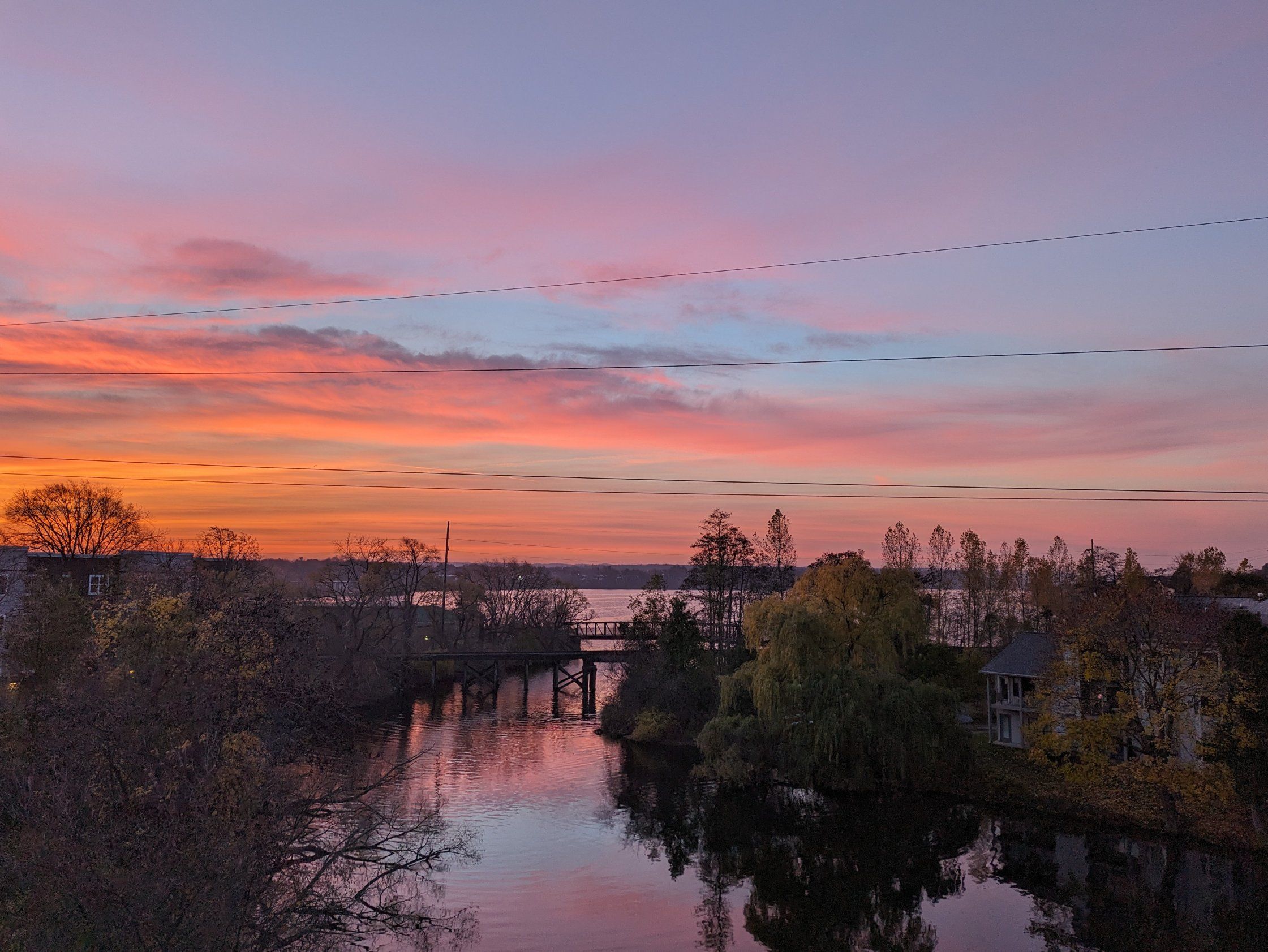
🎵 When the lights go down in the city, and the sun shines on the bay 🎵
The Groundwork Center is one of several tenants inside Commongrounds , a new shared working space and housing cooperative which markets itself as an “innovative, mixed-use community center hosting a variety of common areas, meeting and event spaces, workforce housing, and local businesses and nonprofits at the intersection of food, family, arts, and wellness.” Also, bird puns. It’s full of ‘em.
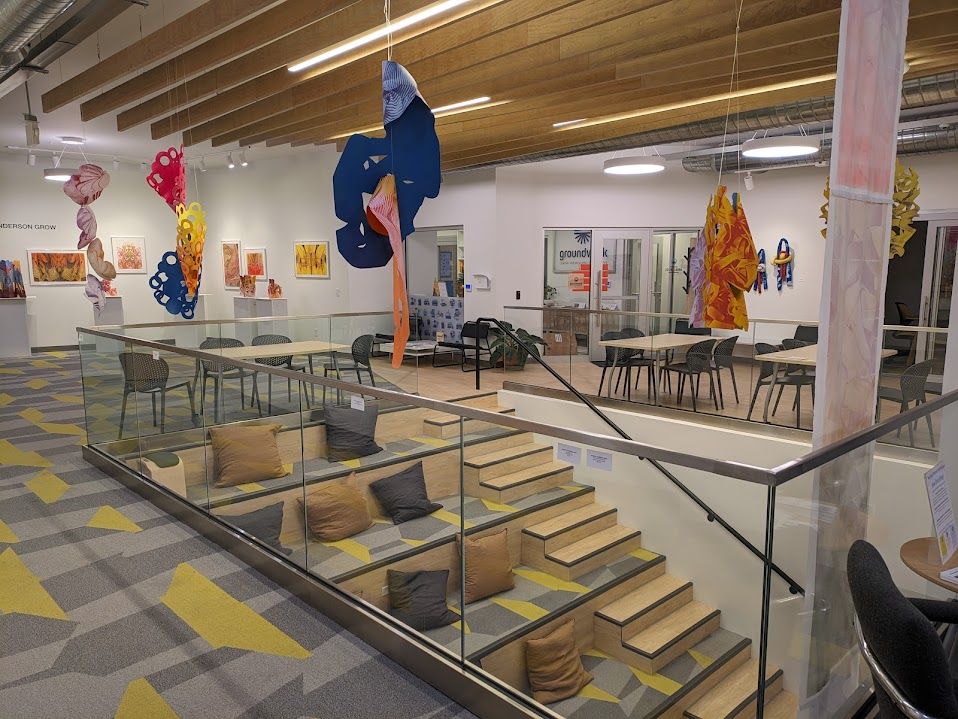
The Commongrounds building in Traverse City, which features long-term, income-based housing and short-term rental units on the upper floors. The Groundwork Center has its own office on the second floor, seen here.
Commongrounds features a community teaching kitchen and coffee learning lab, an early childhood education center, a public food hall with planned expansions underway, and a performing arts venue. And if you’re looking to visit Traverse City, you can stay in the building! Commongrounds manages a few short-term housing units, and the funds received from guest stays are used to subsidize housing costs for permanent residents along with dues from members. It’s a fairly rare setup in Michigan, especially outside the context of university student housing.
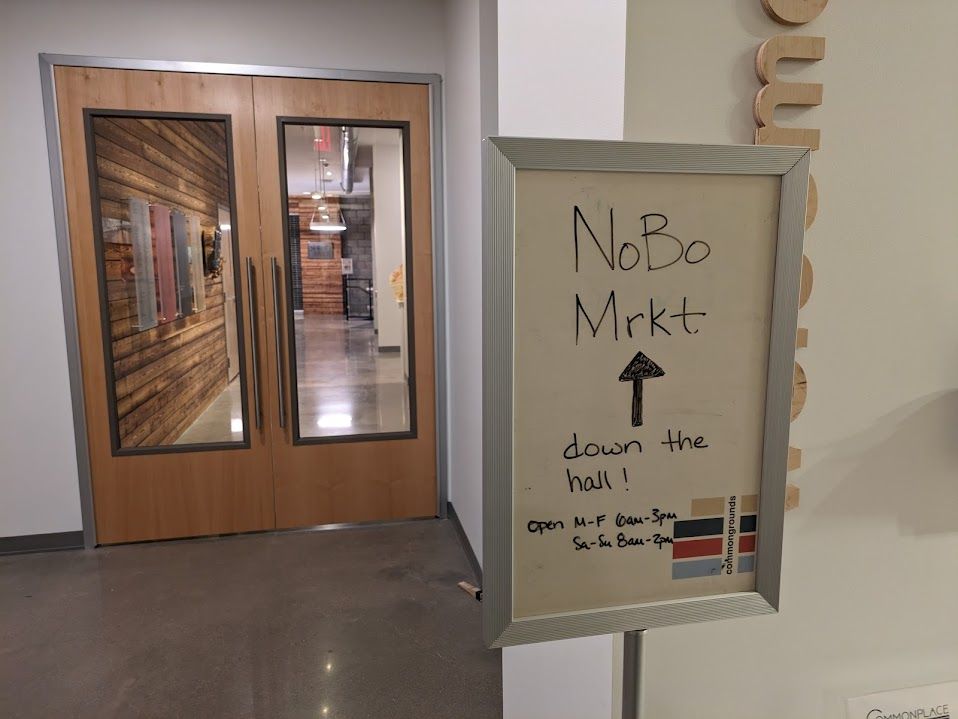
NoBo is named after the area of Traverse City where Commongrounds is located: The North Boardman Lake District, just east of downtown.
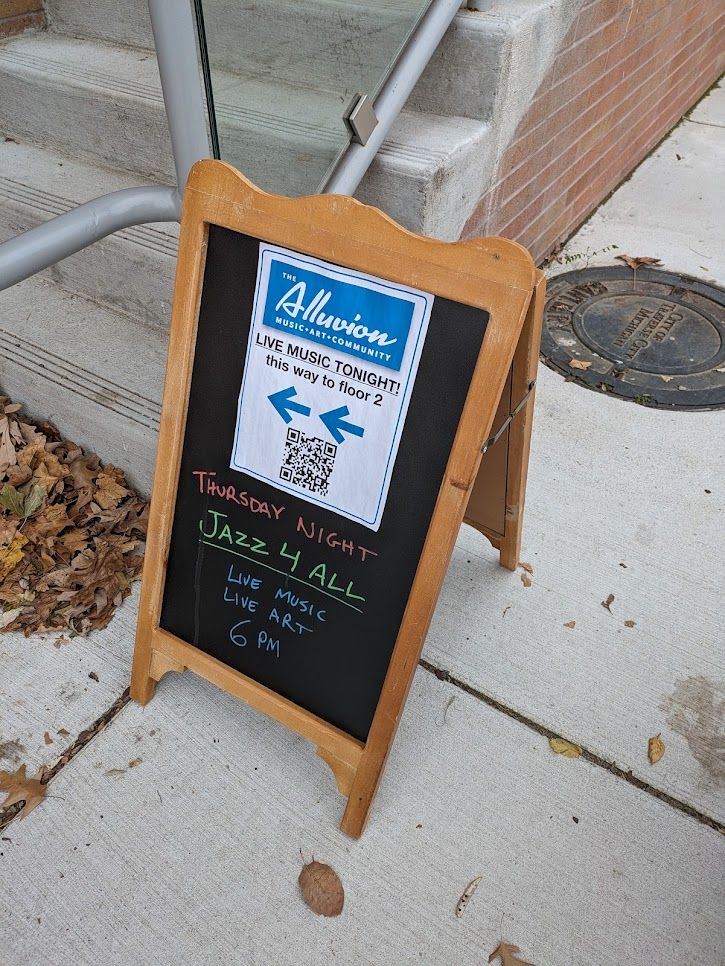
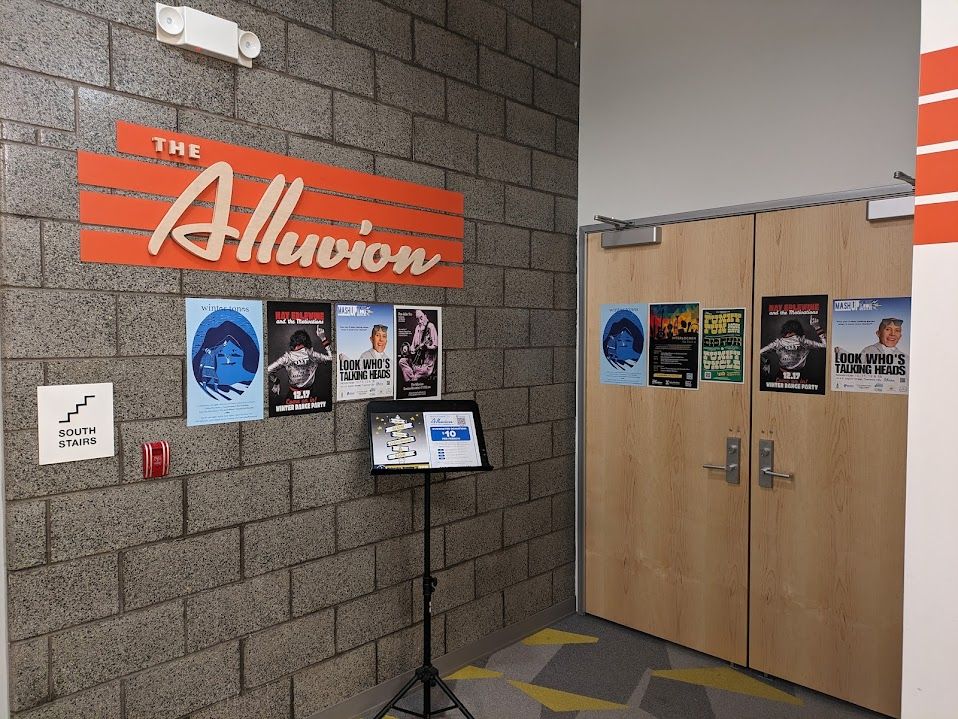
The Alluvion hosts concerts open to the community with a suggested donation.
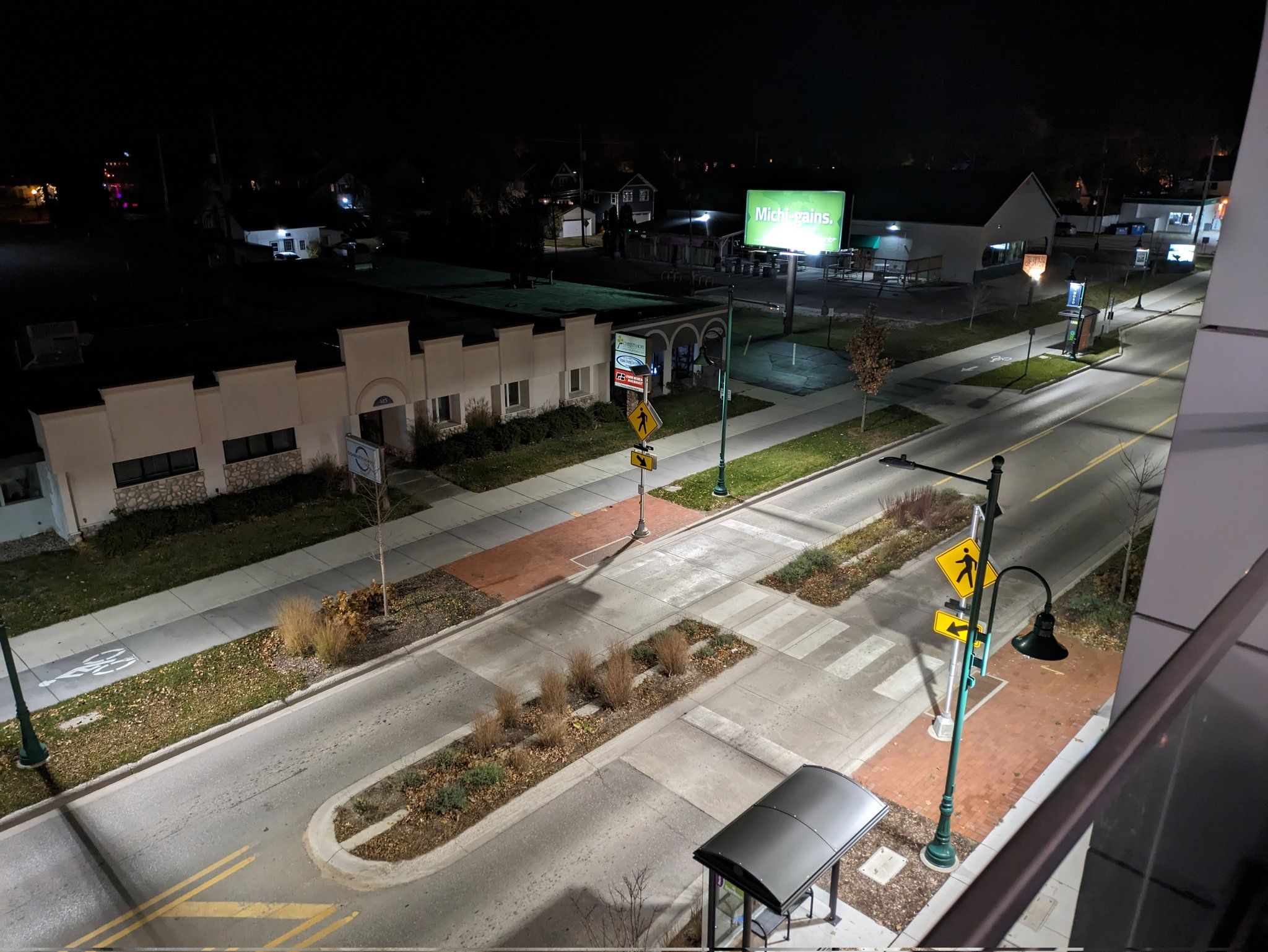
If you bike for transportation, you’ll find yourself among friends in Traverse City! Eighth Street, as seen here from a Commongrounds balcony, recently underwent a complete streetscaping project which saw the installation of two cycle tracks. The setup is similar to the Avenue of Fashion in northwest Detroit, just on a smaller scale.

Commongrounds is a short walk from the Bayline and directly served by City Loop 2.
The Groundwork Center’s Transportation Program staff pointed out some of the area’s rail infrastructure during my visit. Here’s a fun fact: Very much unlike Metro Detroit, freight trains don’t roll through the city all day every day. It’s rare enough that city residents will drop what they’re doing to watch when they hear a whistle in the distance. The Traverse Area District Library is right next to The Filling Station, a passenger rail station turned microbrewery a few blocks east of Commongrounds; when a train passes by, everyone in the library runs to the windows on the upper floors to watch!
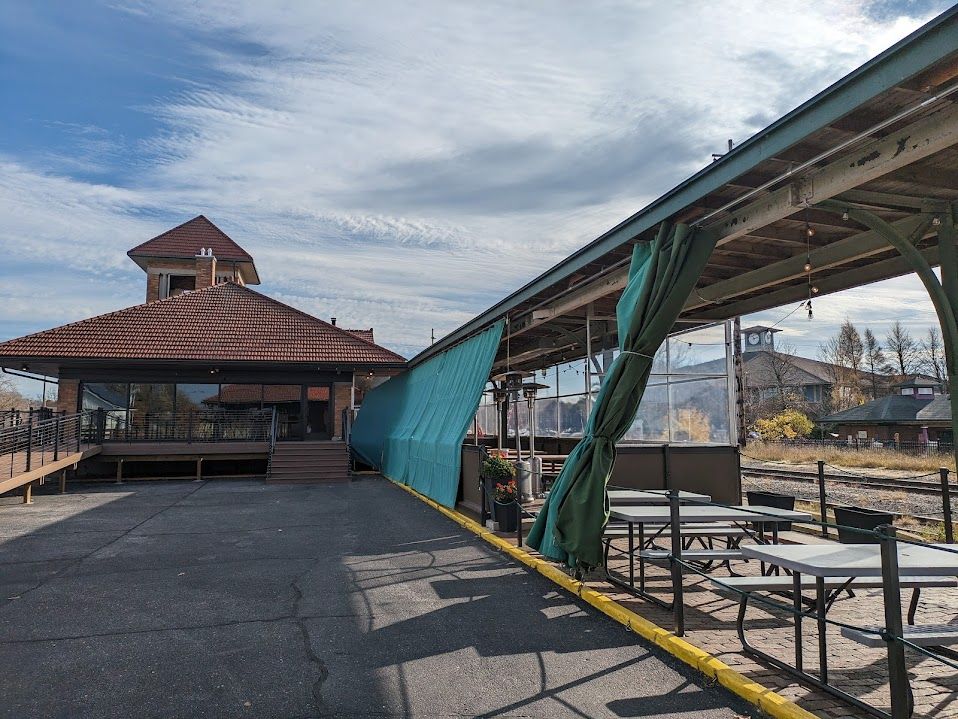
The Filling Station, an old passenger rail platform turned into outdoor brewpub seating.
If you want to learn more about the Northern Michigan Rail Project and other noteworthy events in the passenger rail space, attending a MARP meeting is a great place to start. Next month’s meeting is on December 7th and will be virtual.
Thank you so much to the staff at the Groundwork Center for the tour and insight into your work on building a north-south passenger rail corridor in Michigan!
The Adventure Continues: Exploring Grand Traverse
🎵 Cruisin’ on down Front Street, you’re relaxed and feelin’ good 🎵
I picked up a City Loop Day Pass and took Route 2 back to the Hall Street Transfer Station to continue exploring. “City Loop” and “Village Loop” are the two categories of fixed routes in Traverse City, differentiated by distance. Routes 1, 2 and 7 are City Loops; the rest are Village Loops, and will deviate a short distance from their standard route upon request.

As tempting is it was to hop a bus all the way out to Interlochen or try something truly outlandish and summon a Link bus to the sand dunes, I chose to keep it small and take a ride on Route 1 down to Grand Traverse Mall.
I have a lot of BATA’s fixed-route system left to explore on my next visit.
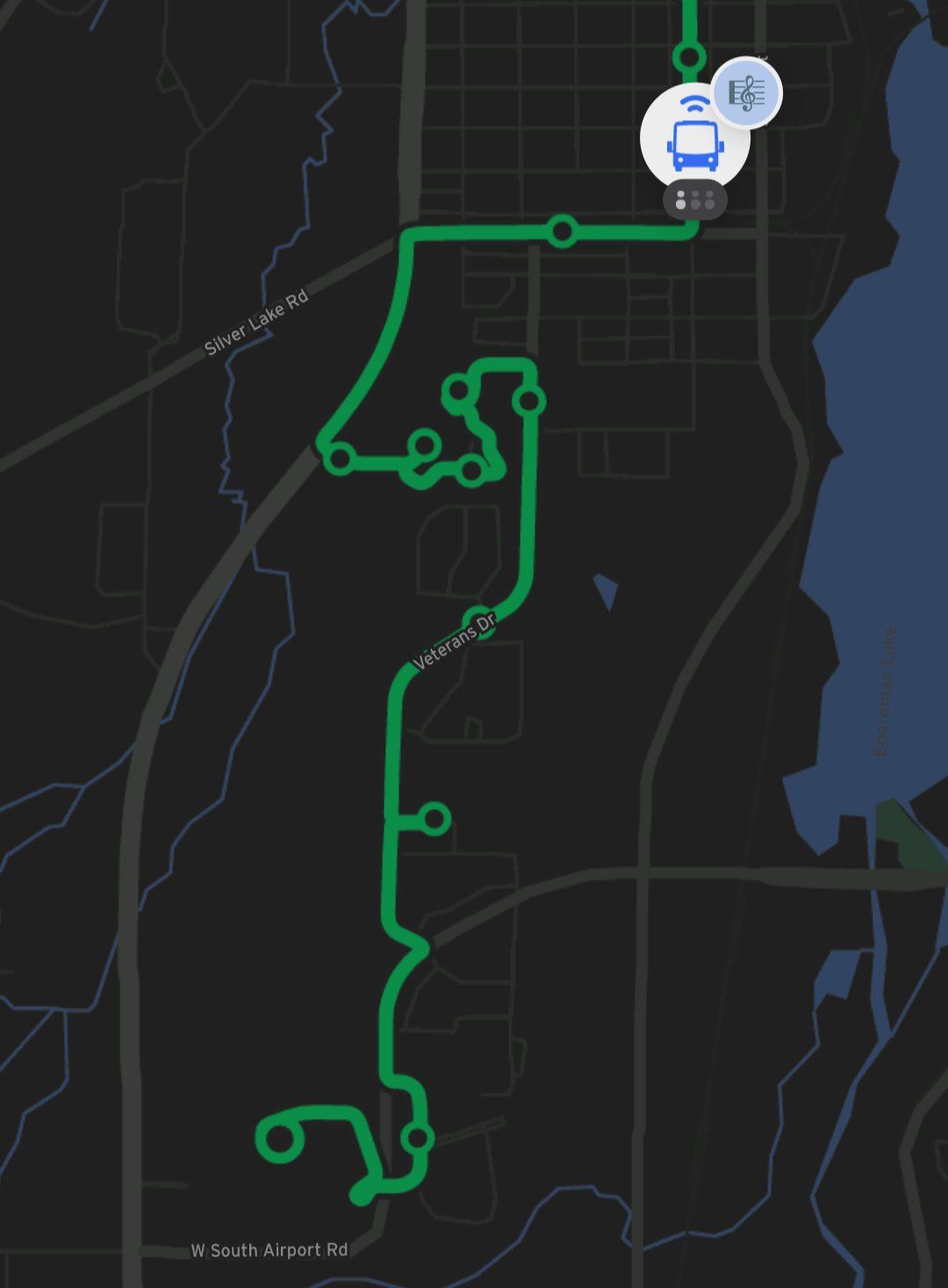
Spoils of planning a minibus route: Turn radius need not concern you, make it as squiggly as you like
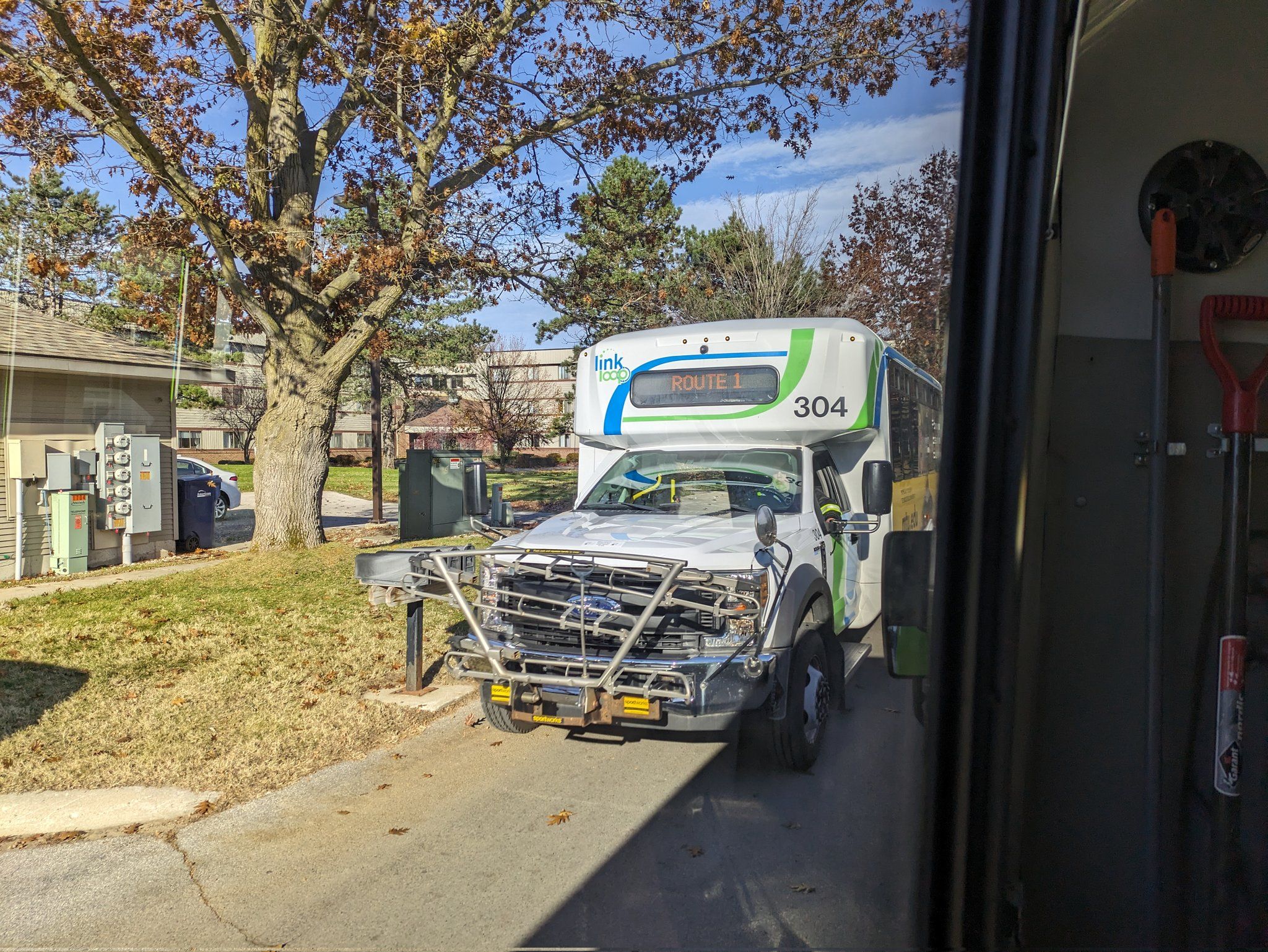
BATA Route 1 drops you off just outside the doors to Grand Traverse Mall, which is a completely normal and expected feature of a public transportation system (yes, Twelve Oaks Mall , I am looking directly at you)
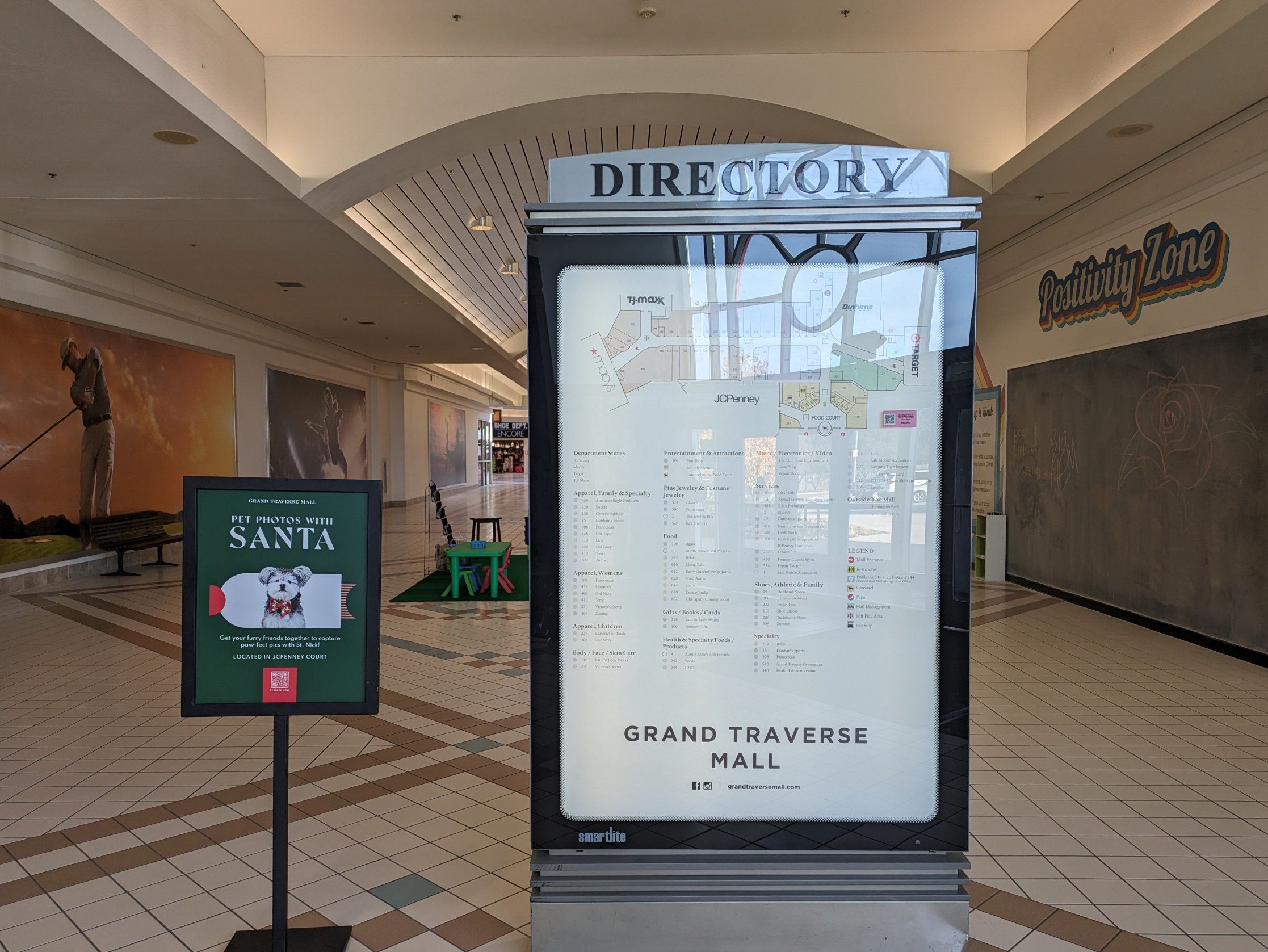
Whenever I ride a brand new transit system for the first time, I have a tradition: Get a mall pretzel. Now, I know what you’re thinking: “You went all the way up to Traverse City and your first stop outside of downtown proper was the dying mall??” Short version of the story: It started at Great Lakes Crossing, when I would have to transfer from SMART to a regional bus that only accepts cash. Bus drivers can’t make change, so if I didn’t have cash on hand I would run into the mall for the ATM and then find somewhere I could break the bill. Guess what the first snack stall you see at Great Lakes when you walk into the door closest to the bus stop is?
It’s a rite of passage I’ve chosen to stick with. 🥨
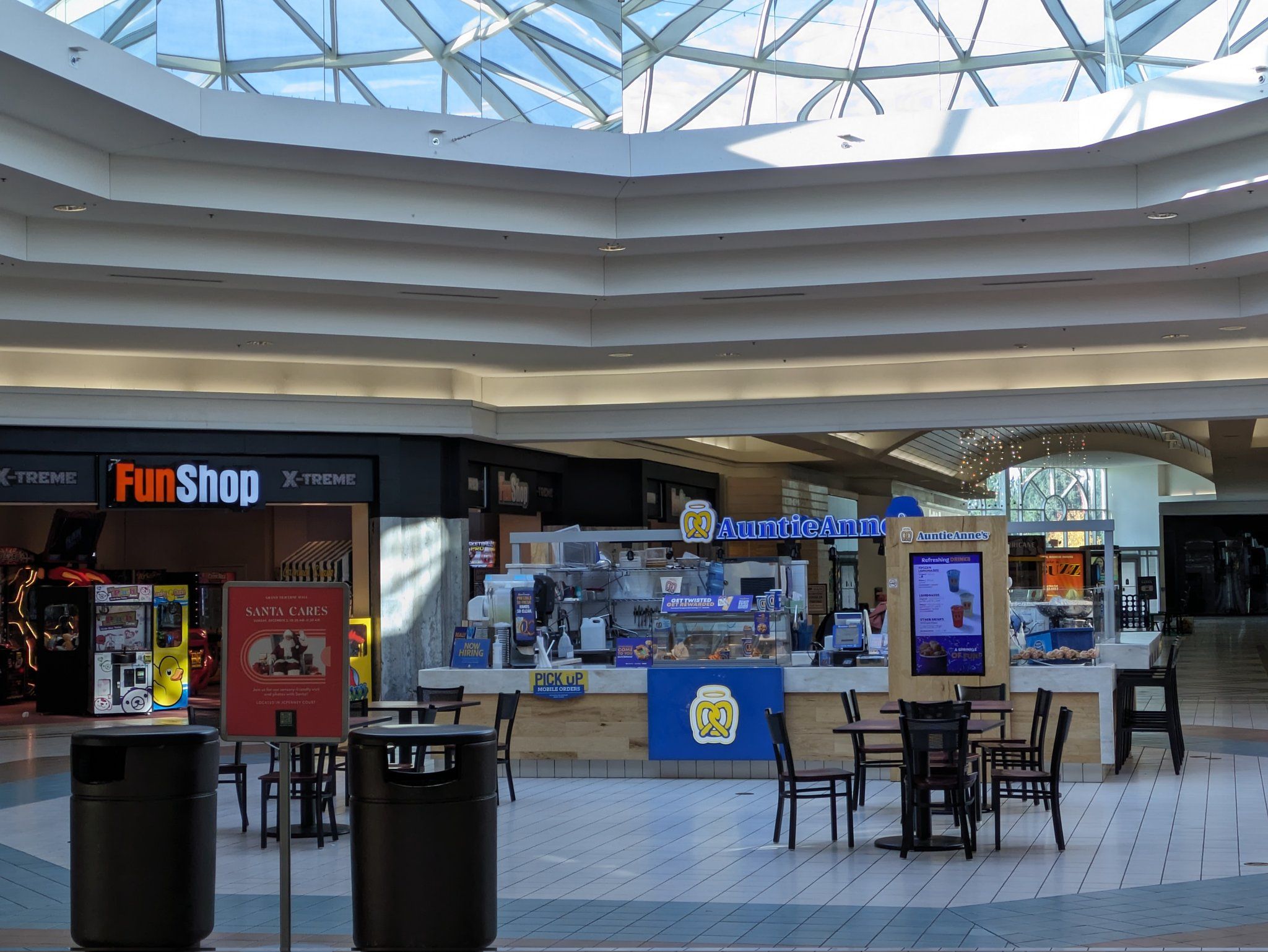
Front and center under a halo of light. 10/10 execution, Grand Traverse Mall.
Sadly, mid-November in Michigan means daylight slips through your fingers at 5:00pm, so the rest of my trip was a moonlit adventure. After 4:00 the walls of BATA start to close in, with Link only serving Traverse City and the immediately surrounding area rather than all of Grand Traverse and Leelanau counties. Boardman Lake is encircled by a mixed-use recreational trail safe from vehicle traffic, so I hatched a plan: Hop a Link bus to the south end of the lake, and walk back into downtown. (Have to balance the hours upon hours of sitting while in transit!)
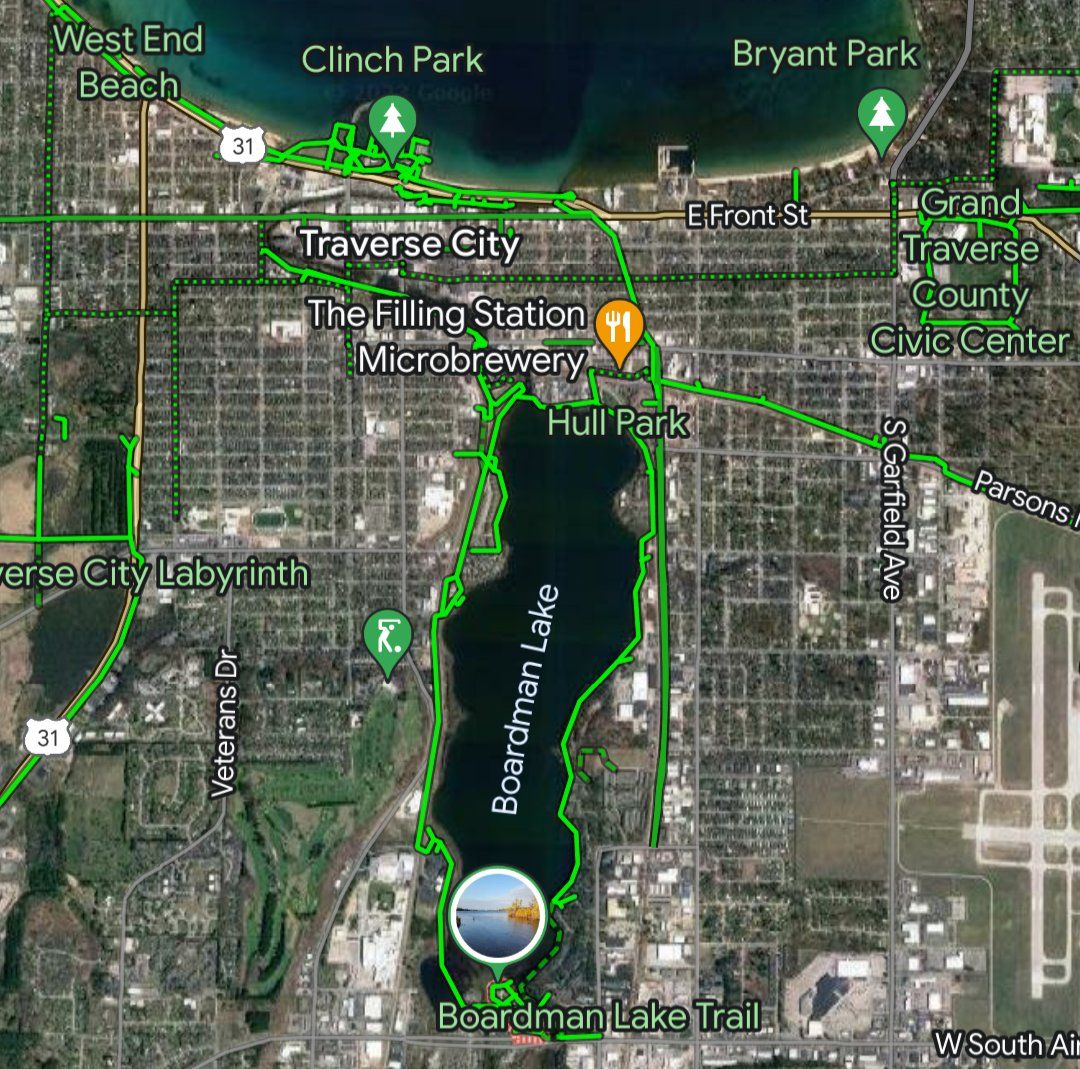
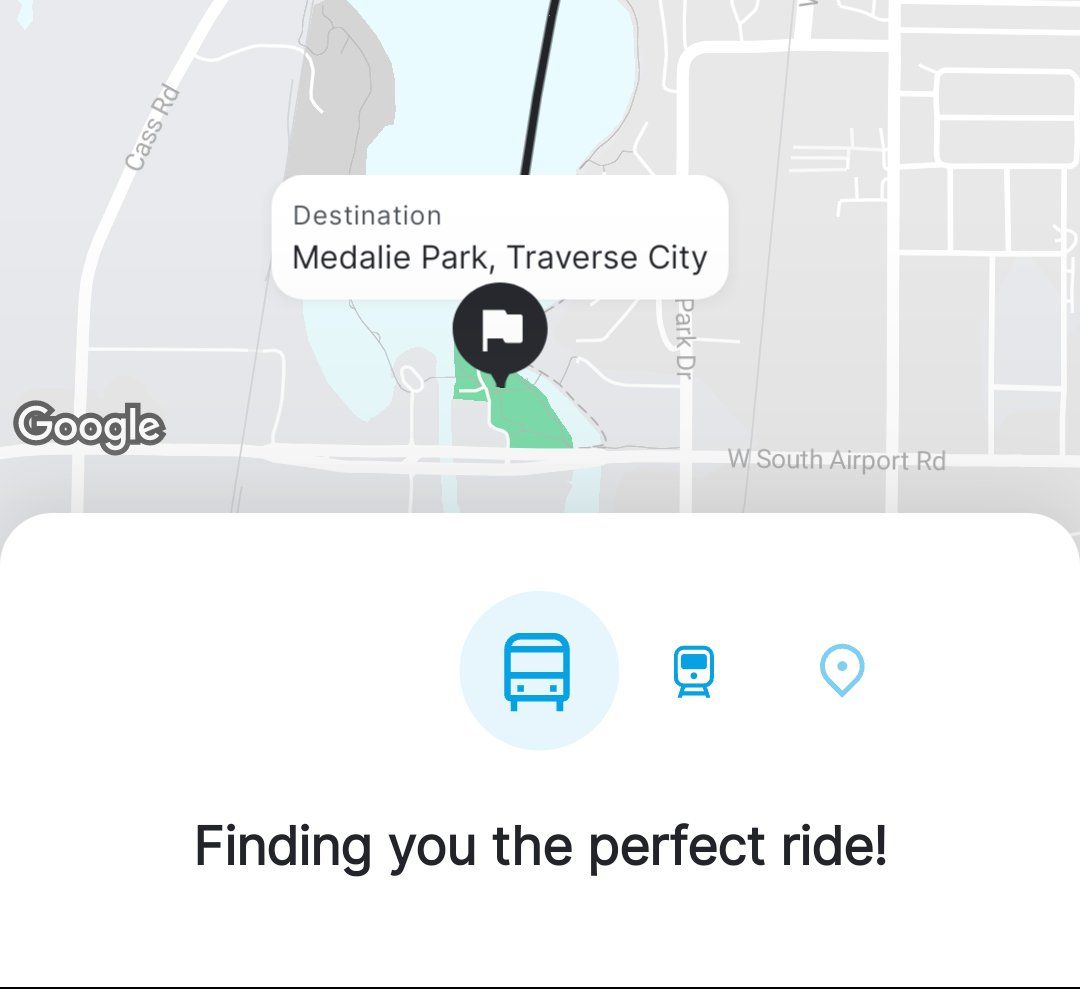
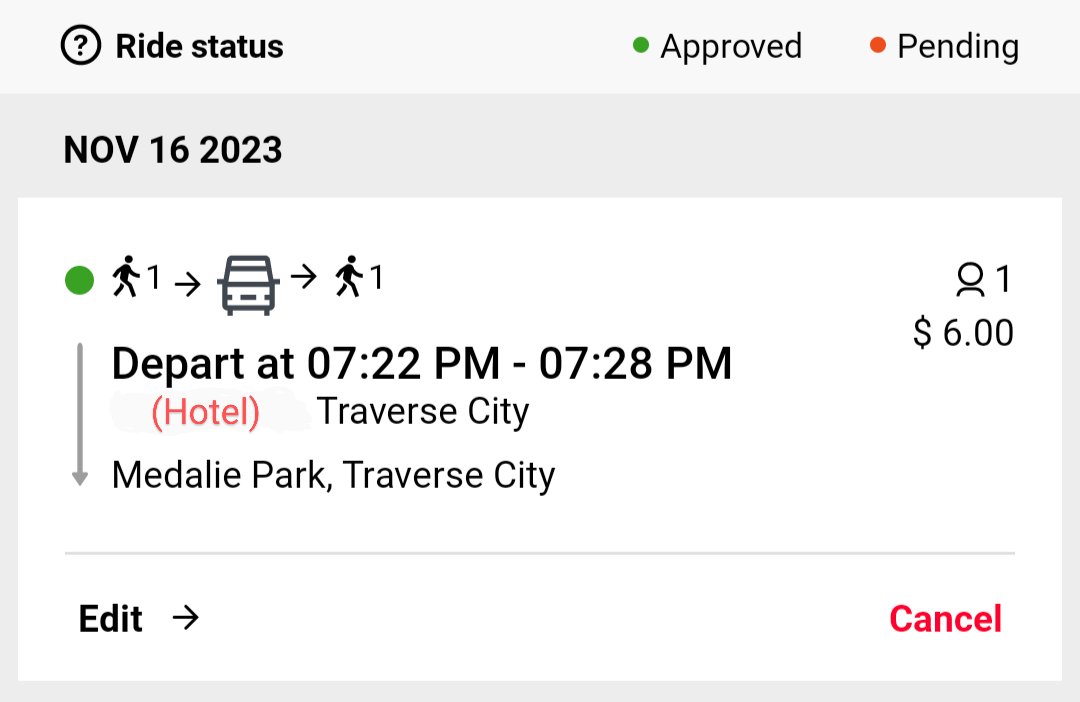
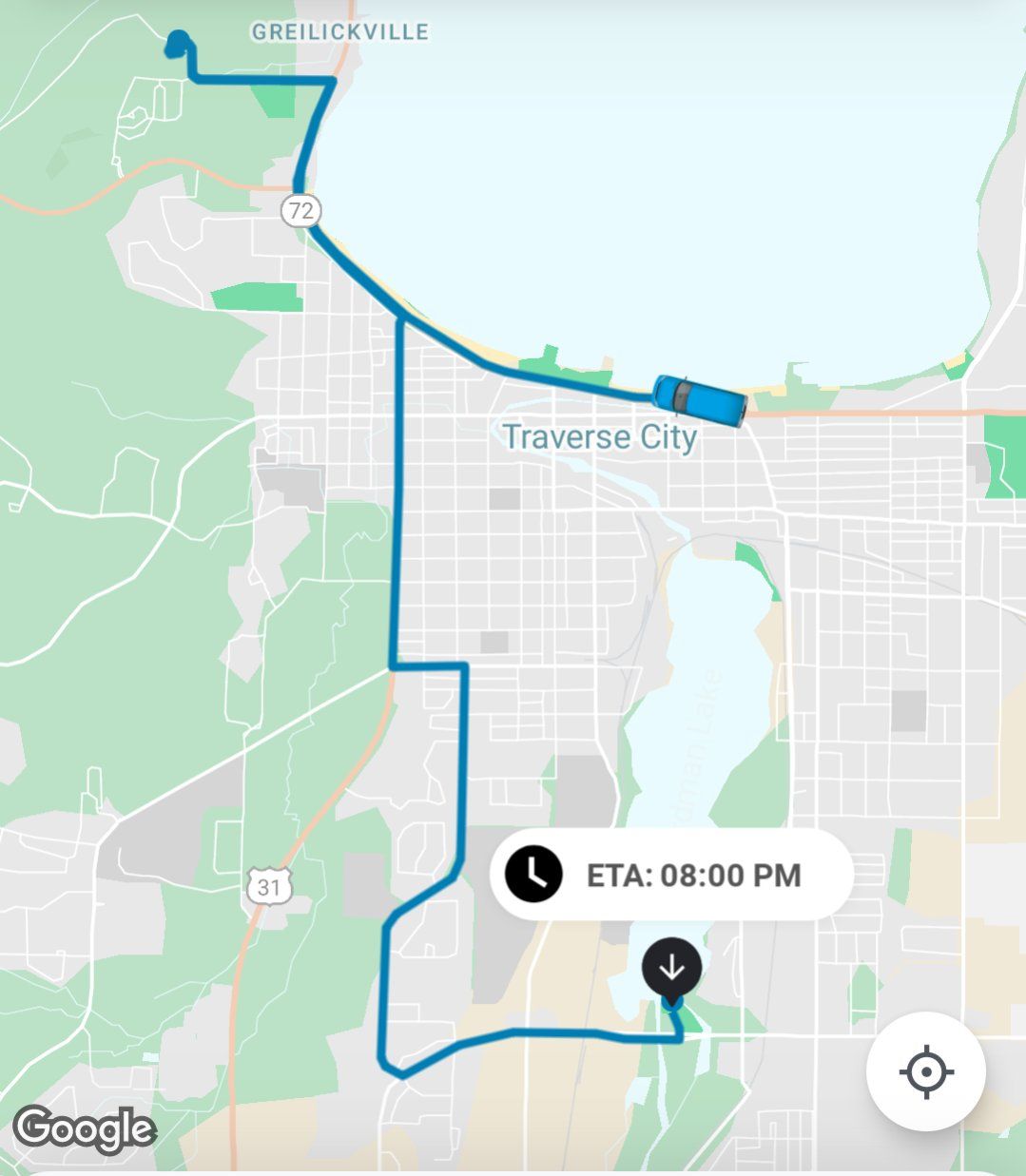
Just like Flex, Link is a busy system. My path to the park at the south end of the lake was far from direct.
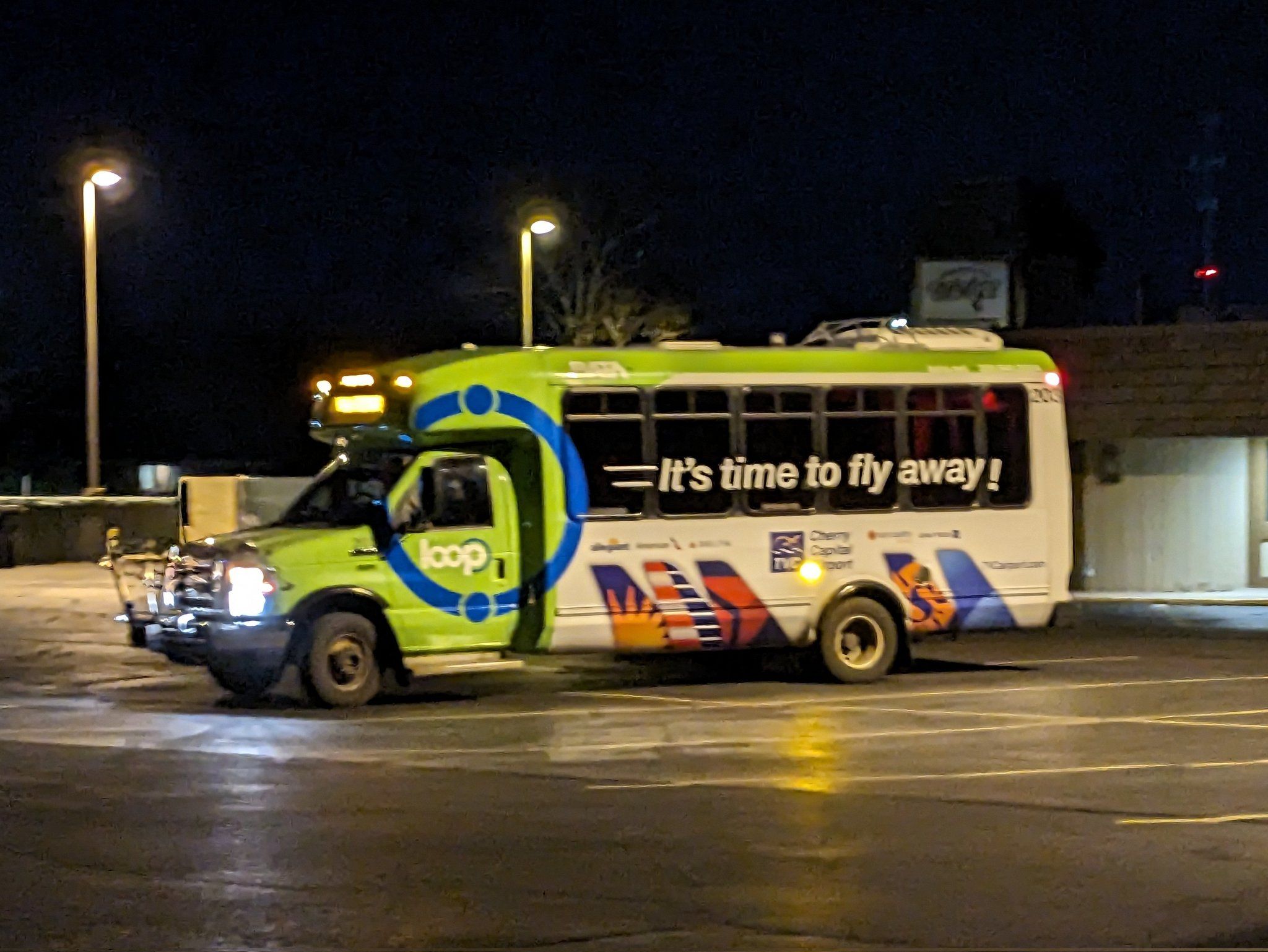
Have to give props to airports that don’t shy away from advertising on transit. Detroit Metro actively tries to hide the fact you don’t have to park there to fly.
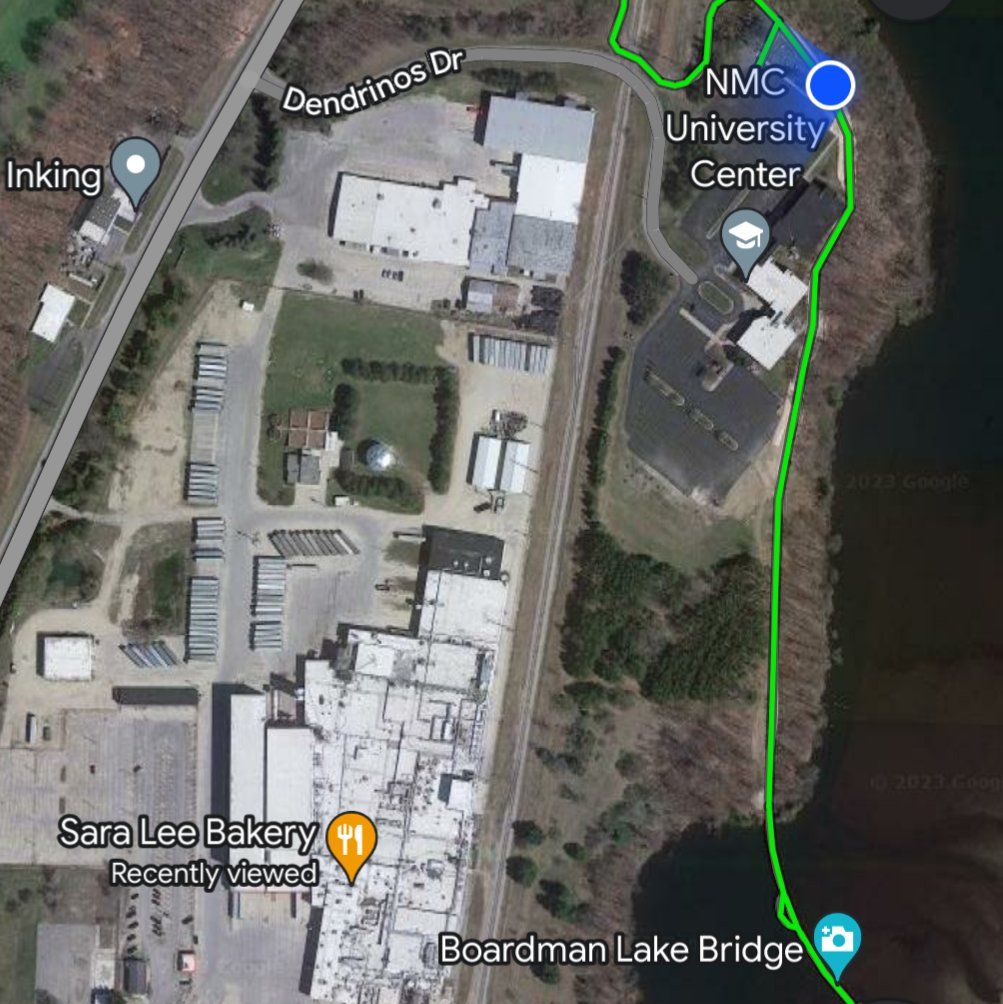
I wish I could share the smell that was floating on the breeze along the trail near this factory. It was a medley of pie fillings 🤤
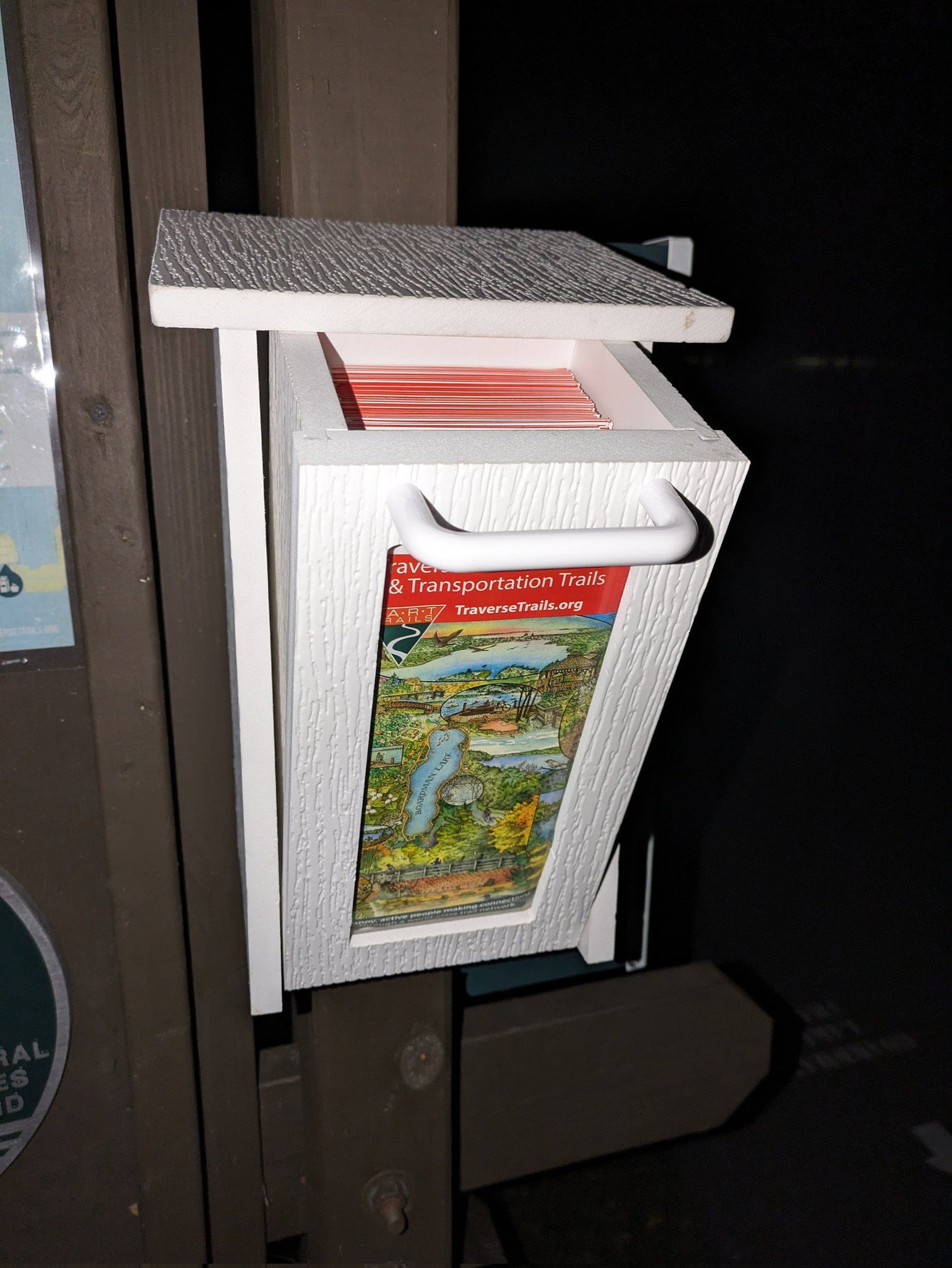
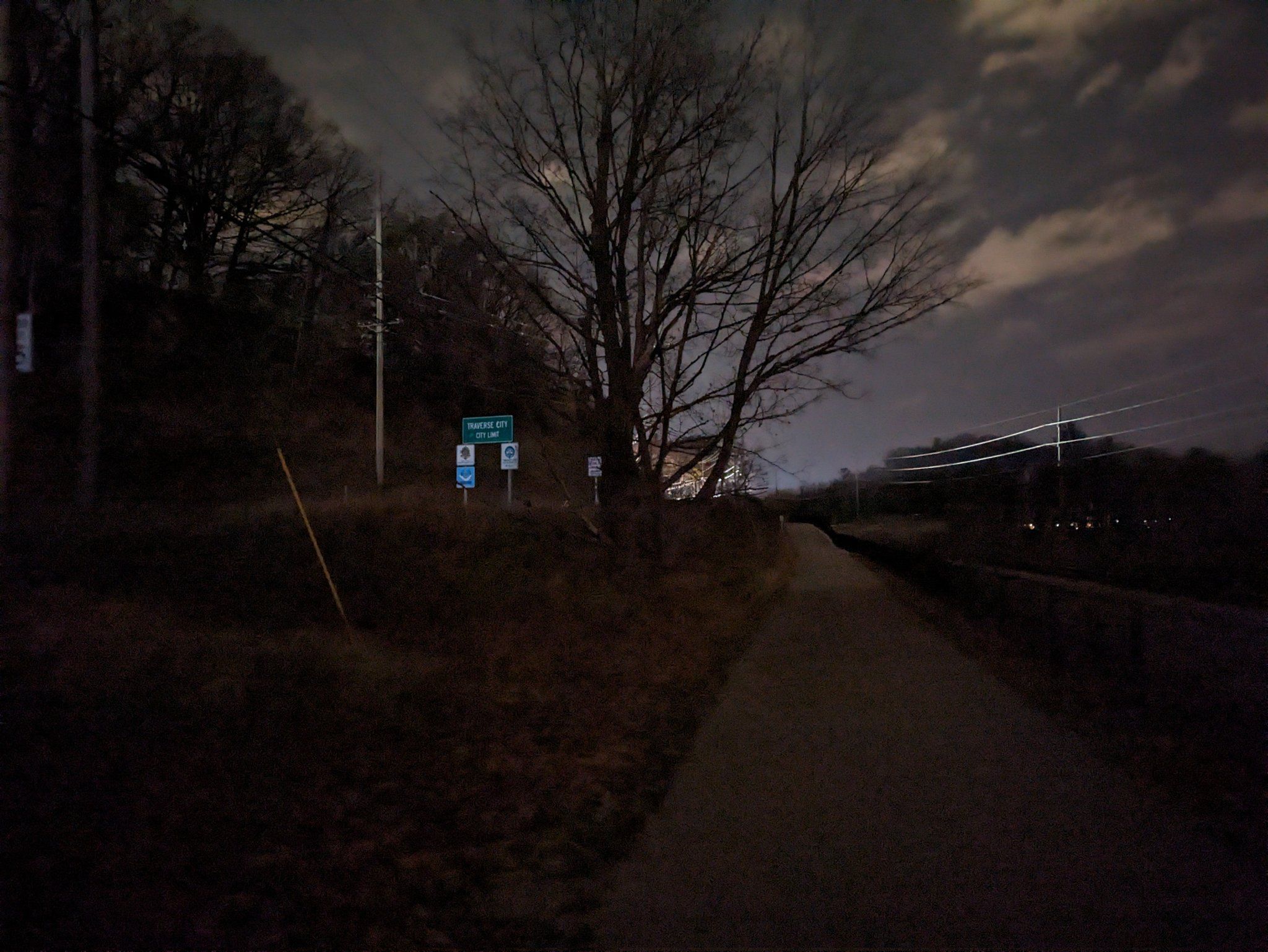
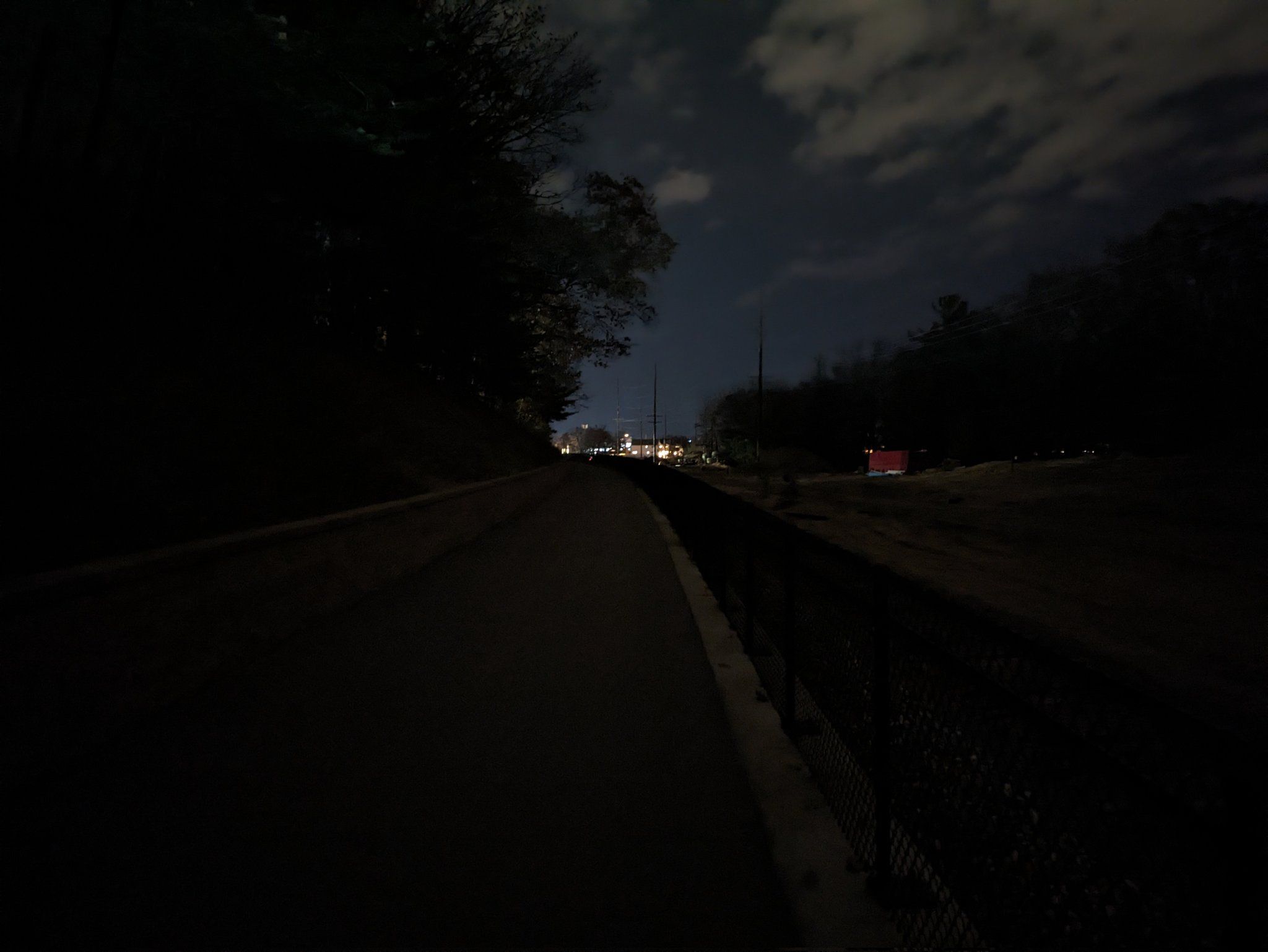
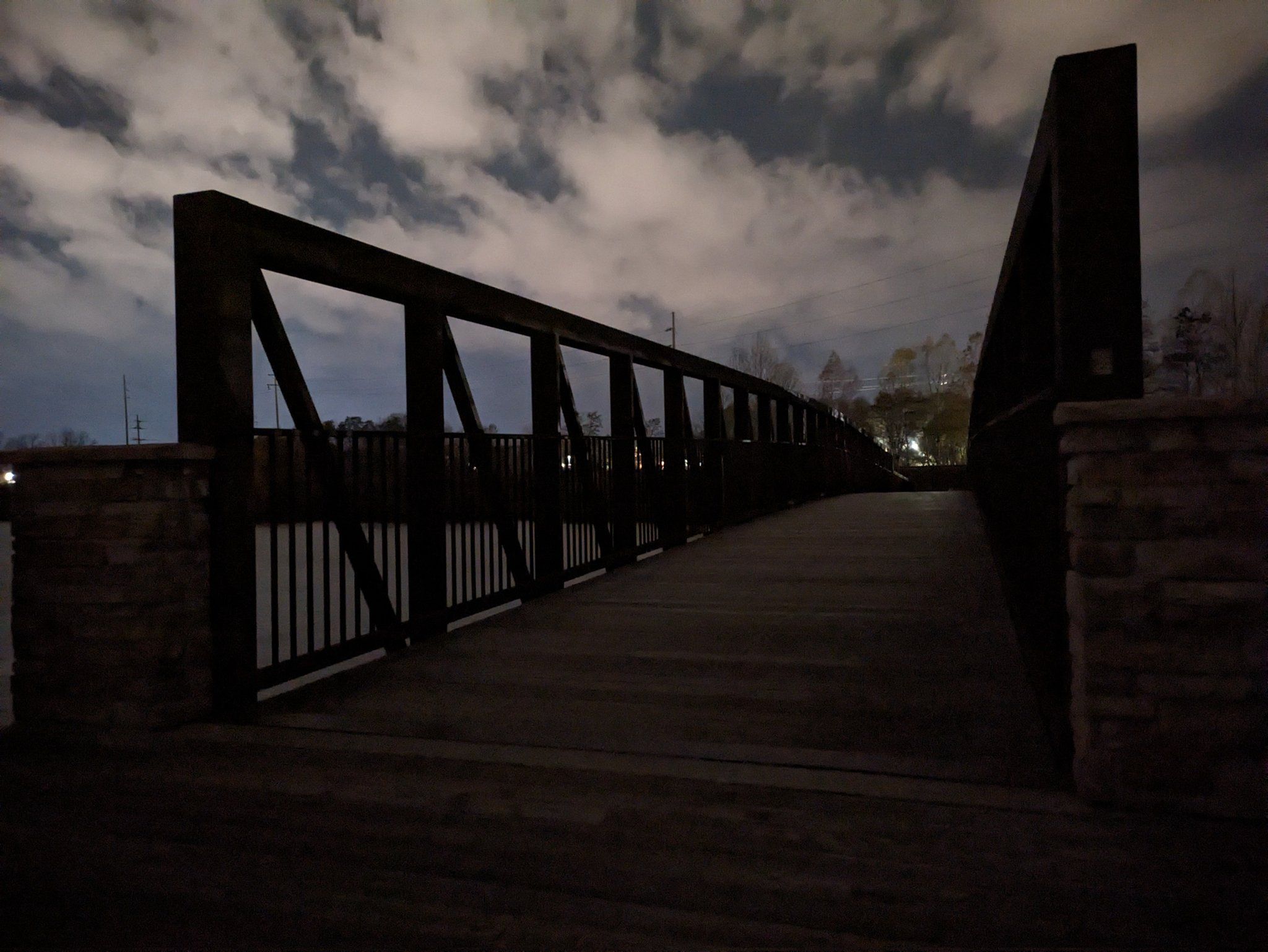
When it gets dark this far north, it gets DARK. But give me a smoothly paved, separated trail where cars can’t hurt me and I’ll walk along it all night long.
I made it back to Front Street just in time to catch the last Bayline bus of the night to my hotel along the East Bay.
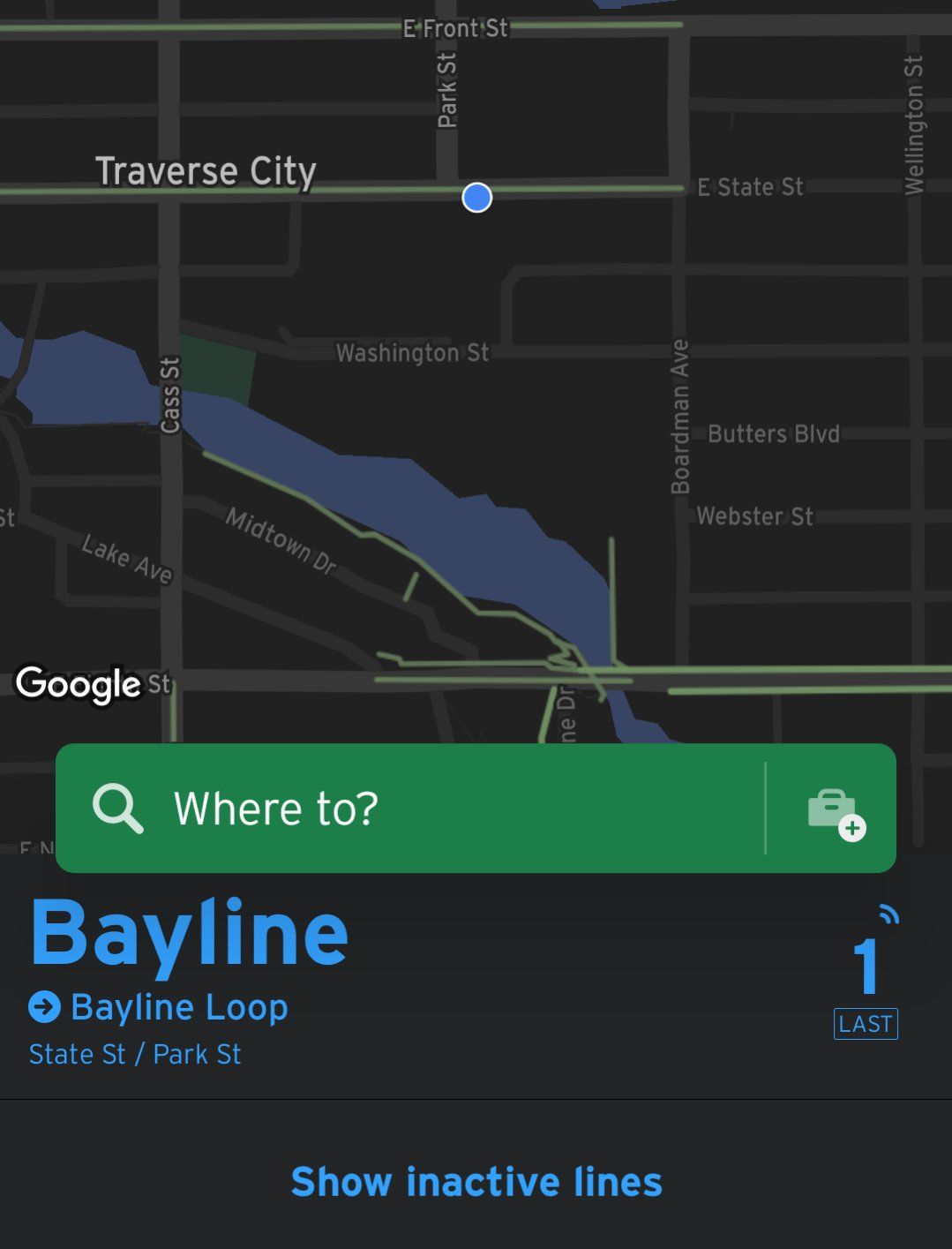
From a safe streets standpoint, Northern Michigan’s flagship town is doing all right for itself…
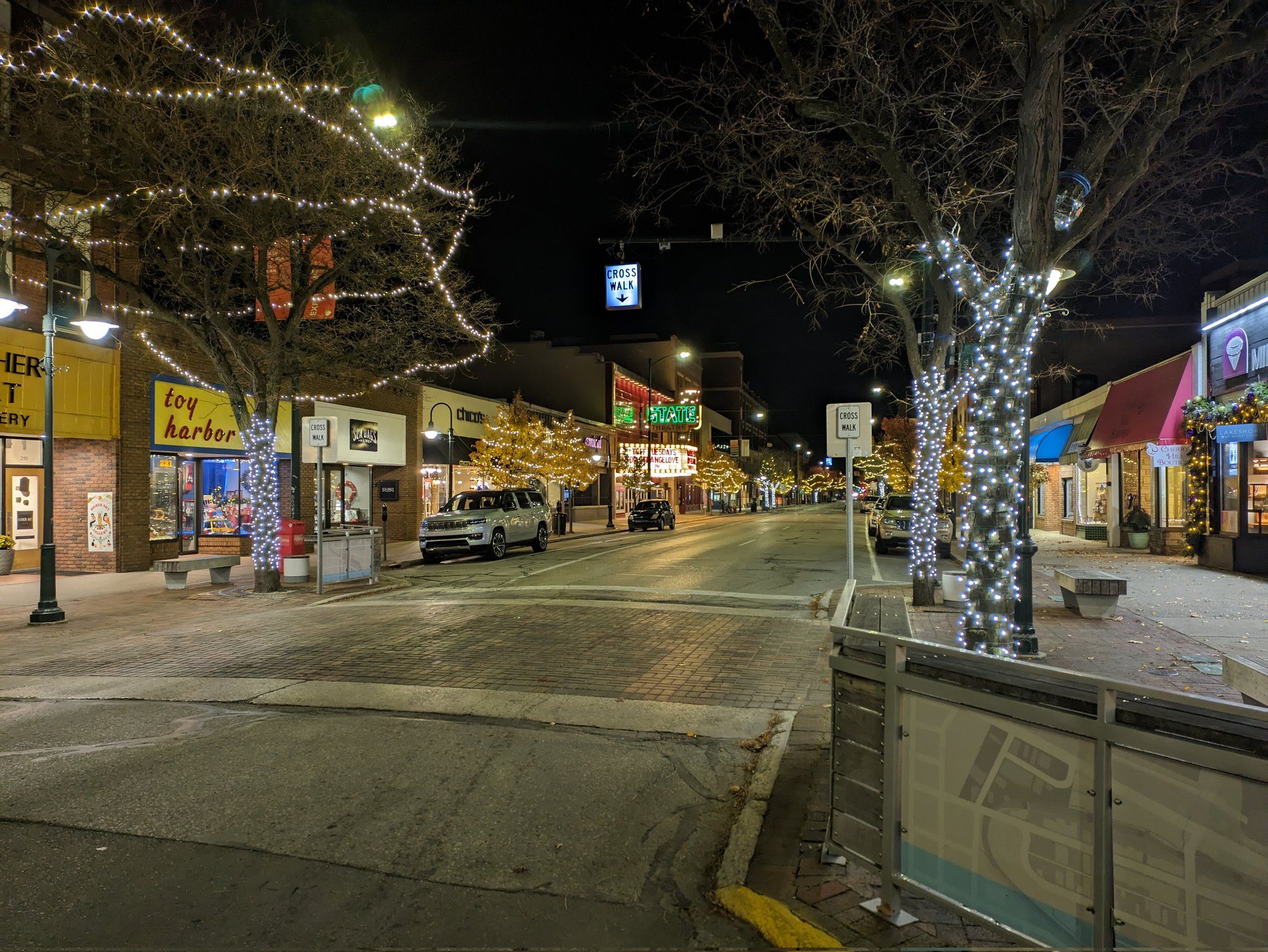
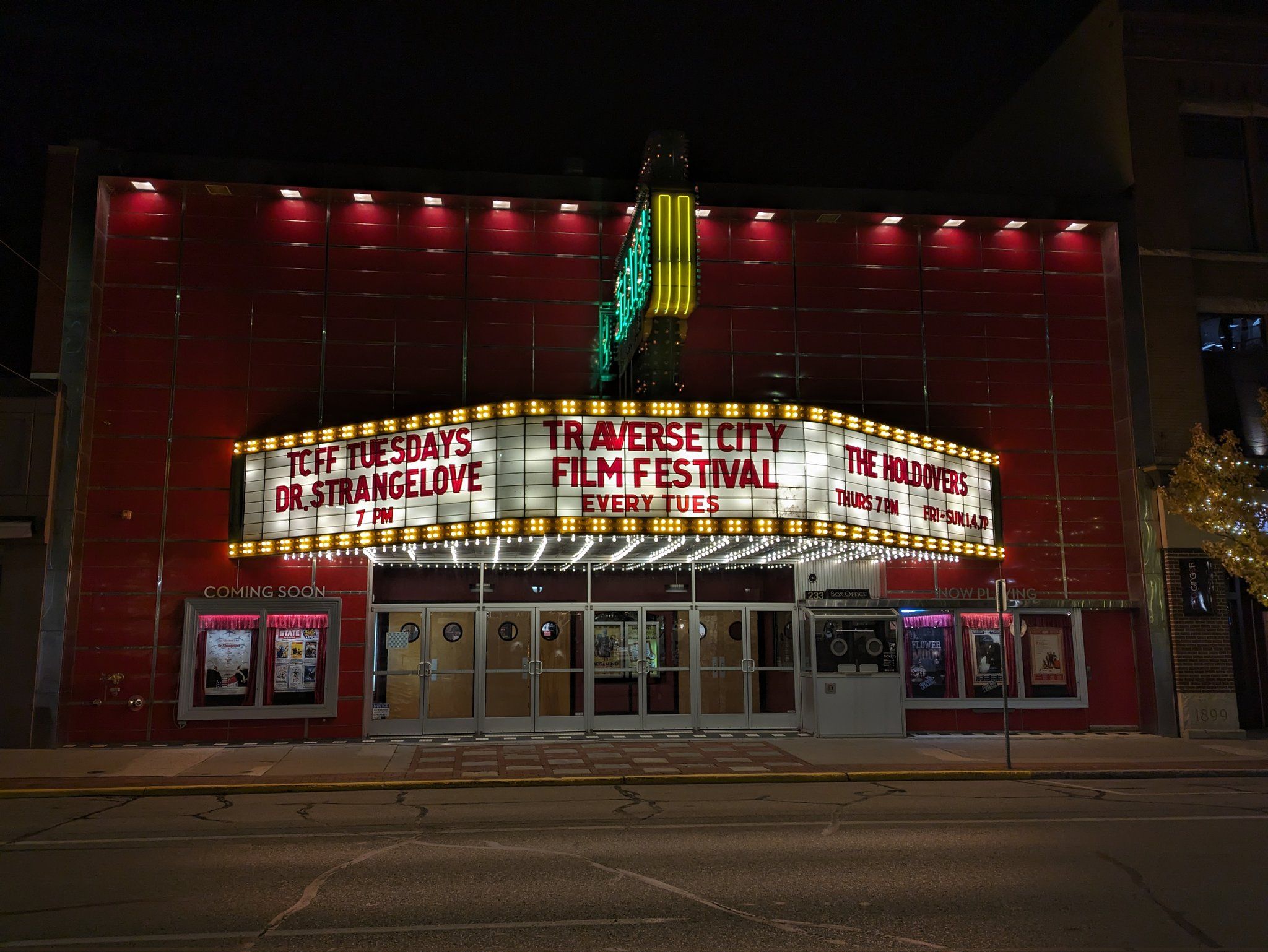
…mostly. The areas immediately outside downtown could use some work. But I’m confident it’ll happen!

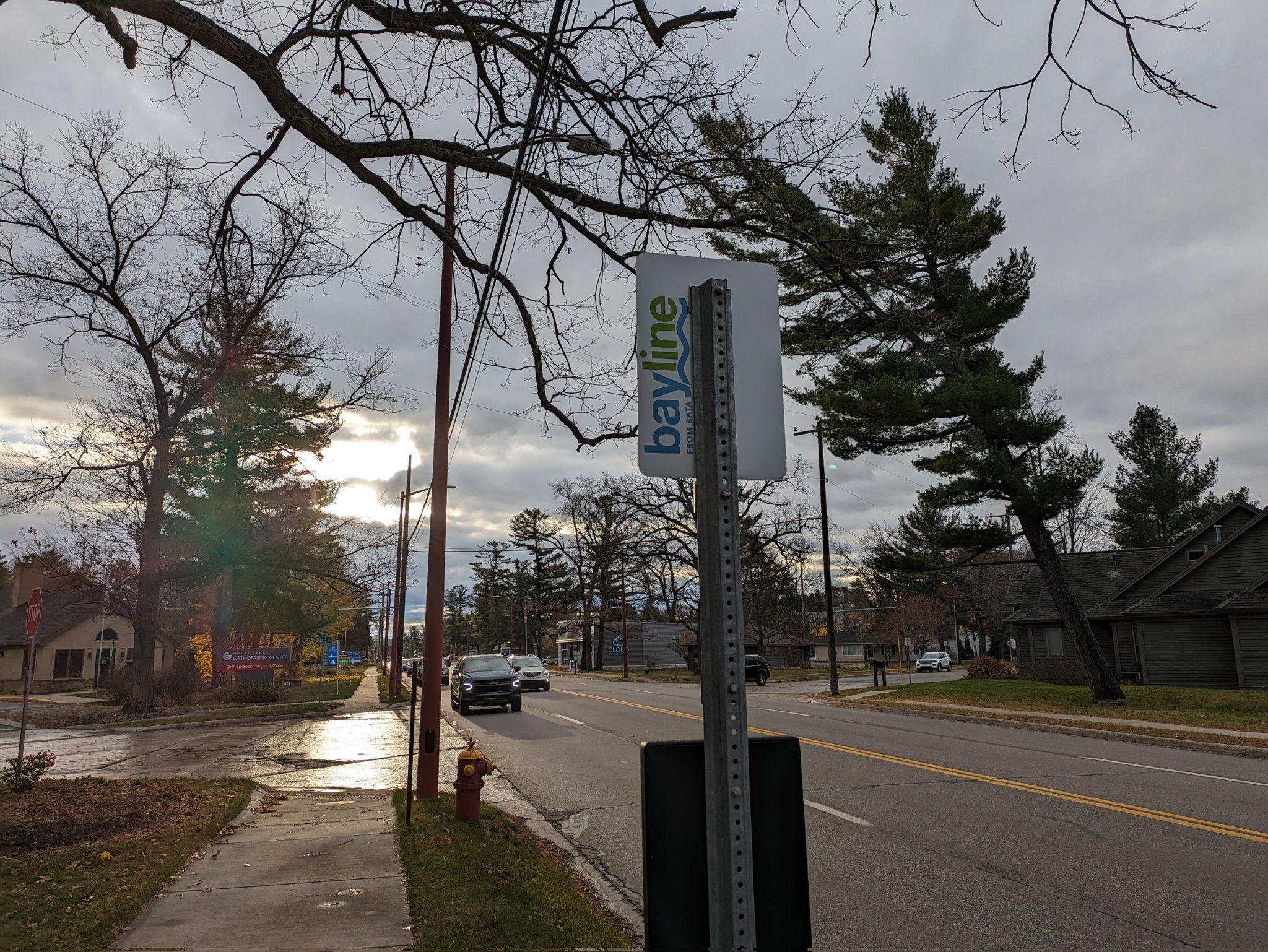
I had to cross this road to get between my hotel and the Bayline stop.
One last note: Shout-out to Dino’s Pizza for delivering to hotels across Traverse City well past midnight. You all make a great pie!
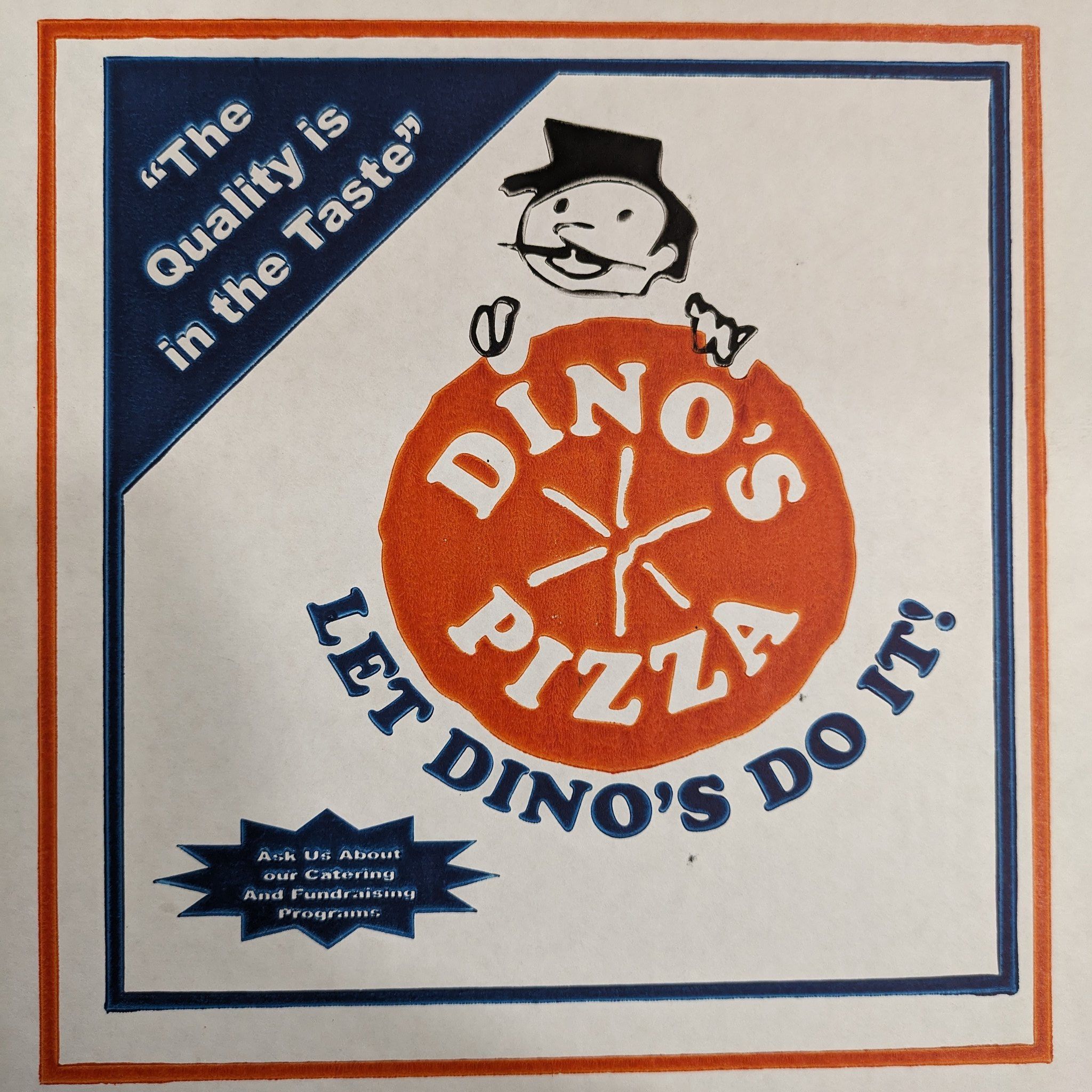
The End of the Road… For Now
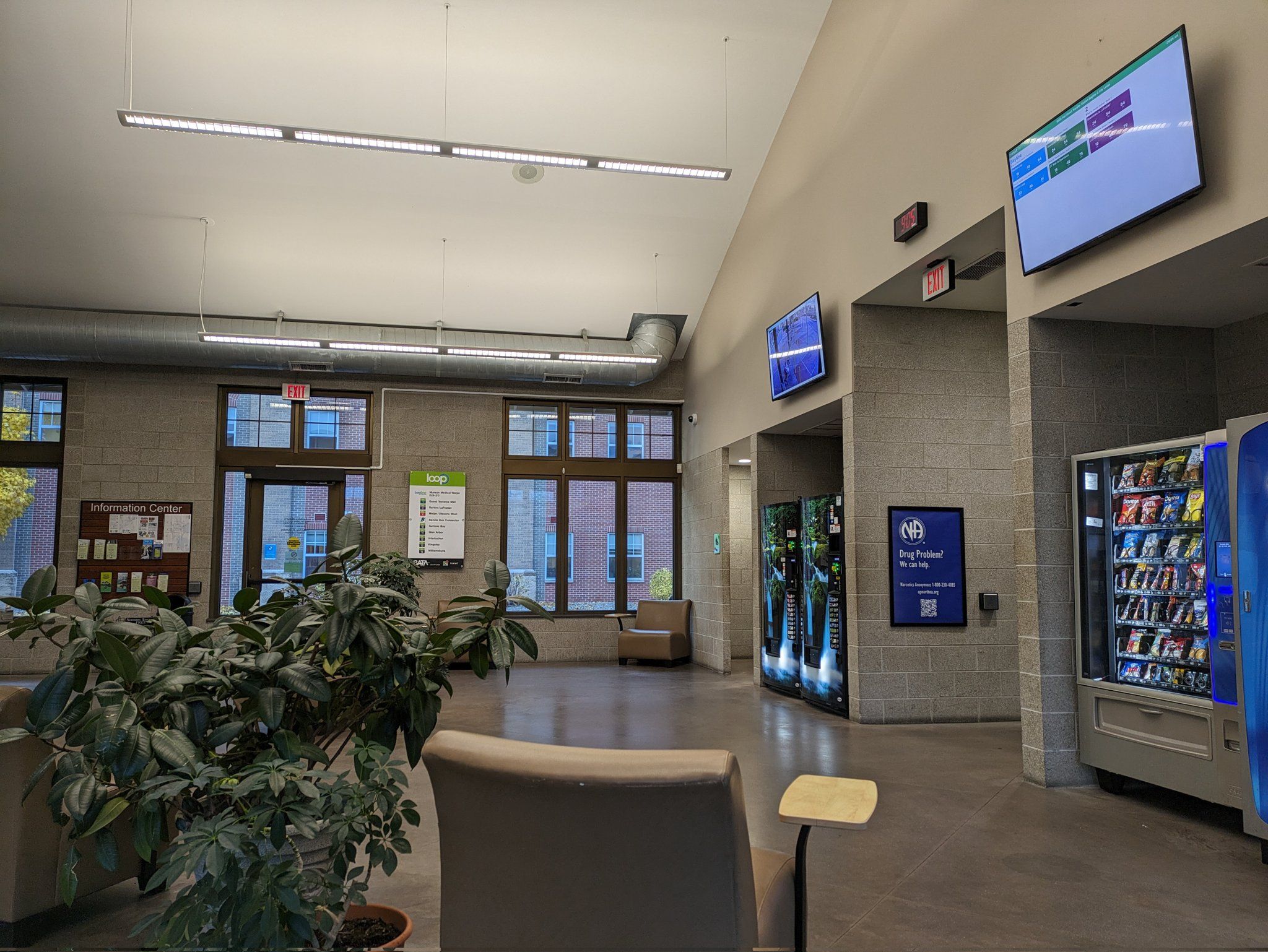
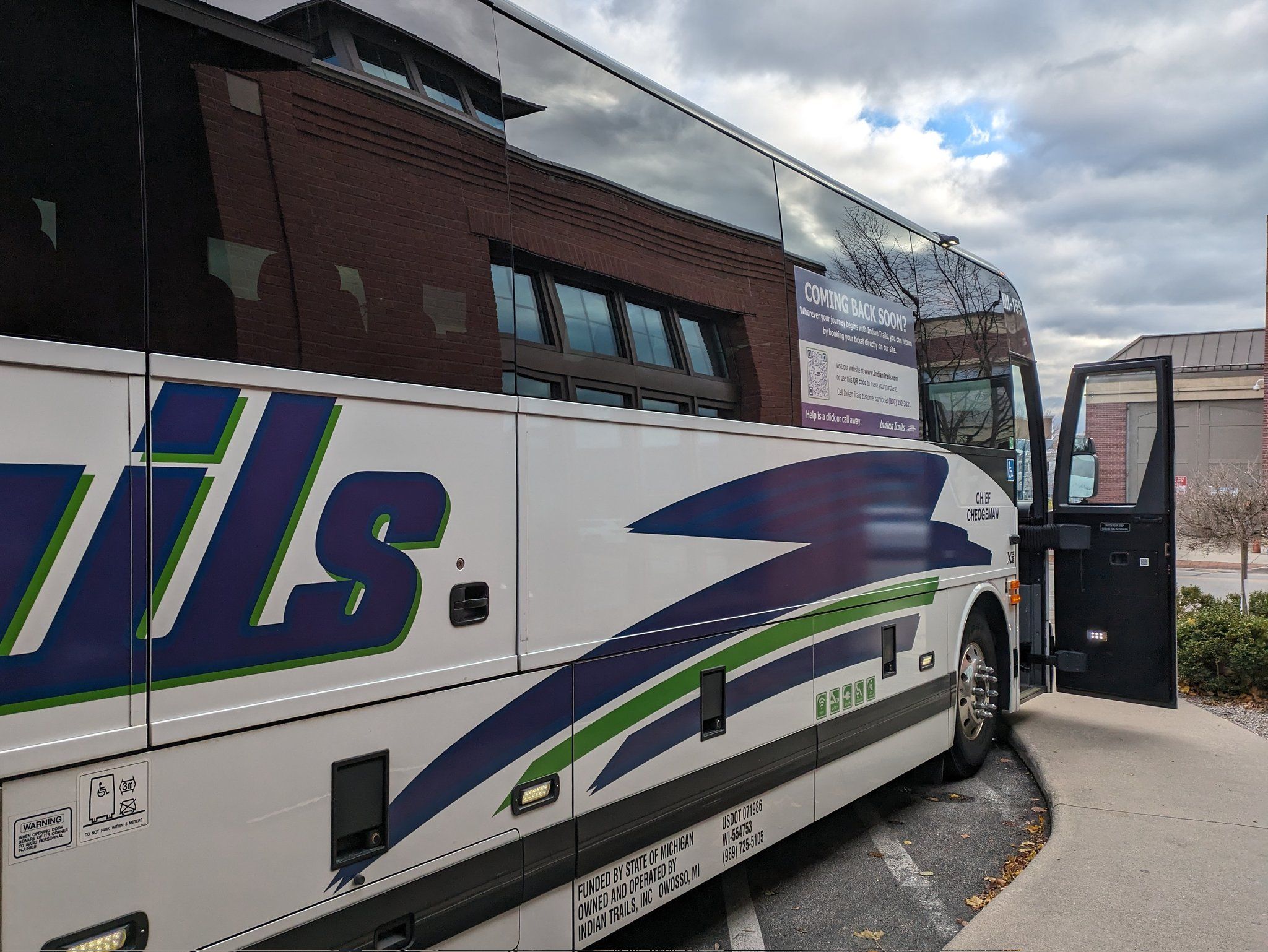
My third and final day in Traverse City was spent leaving Traverse City. When there’s one bus and one bus only, and it’s a morning departure, you leave nothing to chance.
Overall, this was a fantastic trip and – to my genuine surprise – the most pleasant Indian Trails experience I’ve ever had. Traveling upstate is an entirely different animal from city-to-city travel on congested expressways in southeast Michigan. It’s a more relaxed atmosphere where nobody’s in a particular hurry. As Amtrak says, you’re all in it together… literally, so you may as well enjoy the ride.
Before calling curtains on this adventure, I hopped off Trails in Lansing rather than backtracking to Kalamazoo to watch the annual Silver Bells parade. As a treat for making it to the very end, here’s Lansing’s greatest holiday decoration: The famed CATApillar! 🚌🐛
I’d do this trip again. Maybe in the future we’ll have more than a once-daily option – or maybe, just maybe, a train the whole way.
Until then, I’ll see you in transit.
